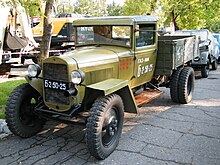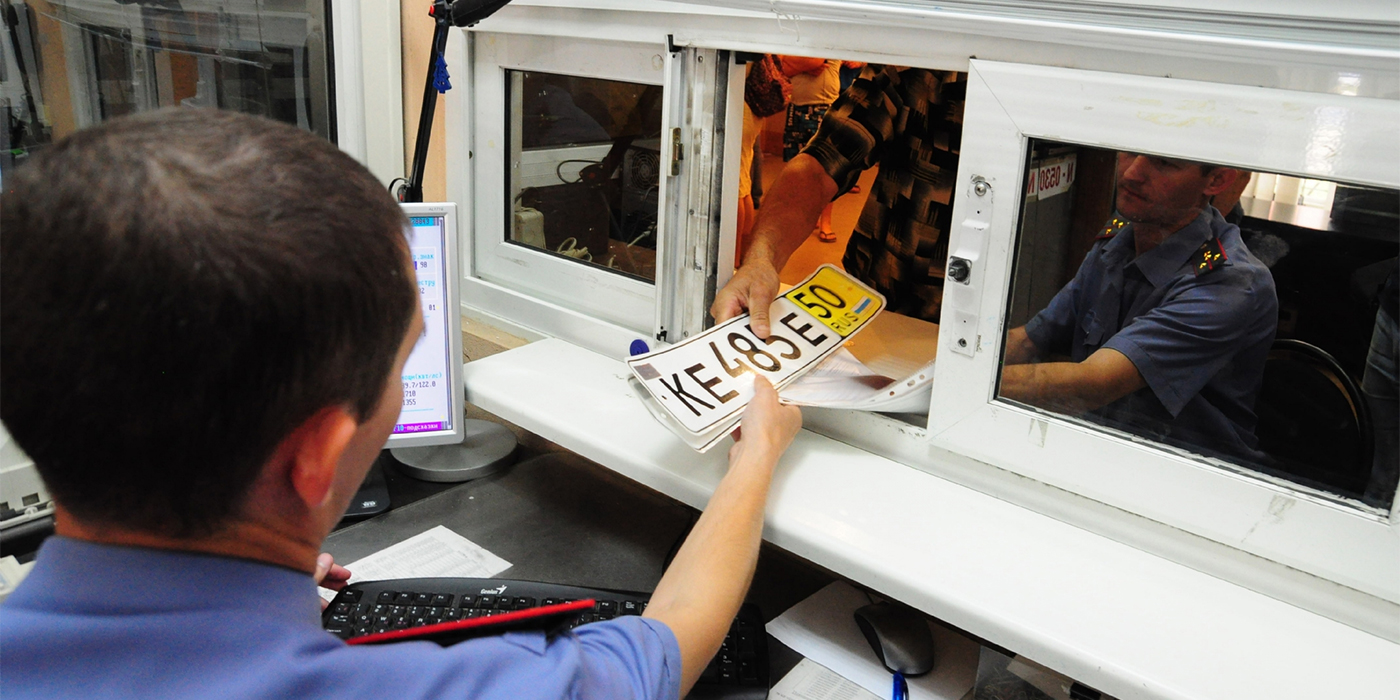
Прямоугольник и квадрат: как менялись номера в России и СССР
(Фото:: Доников Александр/PhotoXPress.ru)
МВД готовит новый стандарт для автомобильных и мотоциклетных номеров. В Научно-исследовательском центре проблем безопасности дорожного движения ведомства разрабатывают изменения в действующий с 1993 г. ГОСТ, которые должны устранить ряд имеющихся противоречий. Так, перспективные нормы разрешат использование табличек так называемого квадратного формата, которые используются в США и Японии, введут более компактные мотоциклетные номера, а также установят специальные знаки для ретро автомобилей и спортивных машин. Пересмотр стандартов пройдет в 2017 г., а окончательная редакция будет готова не раньше 2018 года. По сути, готовящийся ГОСТ предлагает возврат к некоторым правилам, которые вполне успешно существовали в прежние годы.
Белые номера. 1931-1936 годы
Впервые единый стандарт автомобильных номерных знаков в СССР появился в 1931 г. после принятия постановления Совнаркома о порядке регистрации автомобилей. Первые общесоюзные номера состояли из буквы и четырех цифр, написанных черным цветом на белом фоне. Буква обозначала регион выдачи, но не соответствовала названию субъекта. Таблички для автомобилей были одинаковыми, а мотоциклетные знаки отличались размером, причем на мототехнику надлежало крепить и задний, и передний знаки, которые устанавливались также на переднем крыле вдоль направления движения. Особенными были номера для испытательных поездок, на которых ставилась надпись «проба». Кроме того, были введены транзитные номера с надписью «транзит».
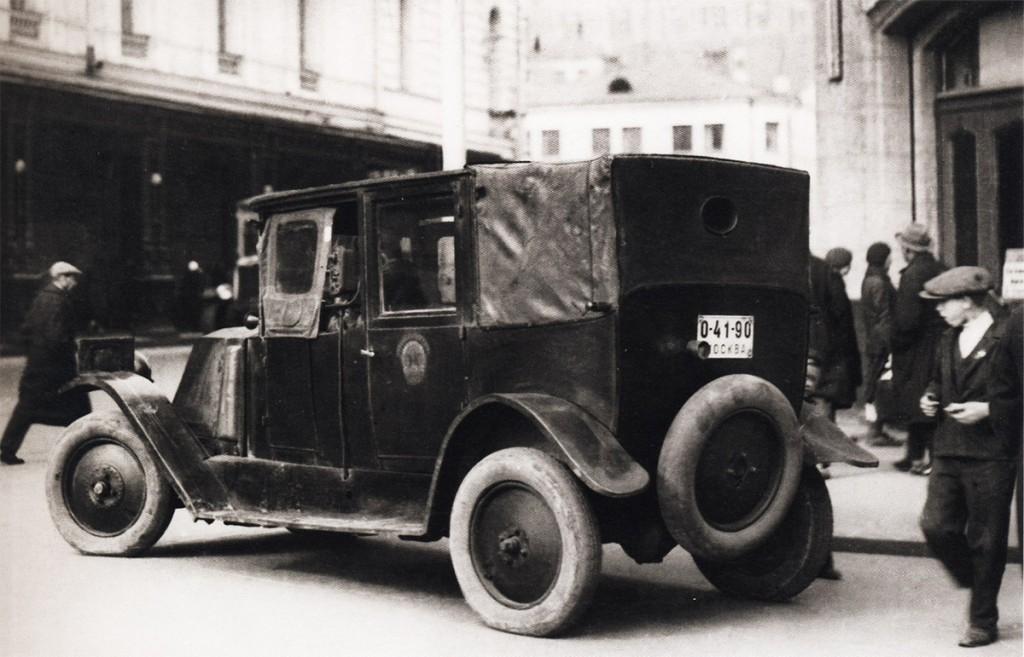
Из-за быстрого роста парка емкость номерных знаков быстро исчерпалась, и в 1934 г. формат табличек пришлось изменить. Название региона стали обозначать прописью, причем длинные имена сокращались до восьми букв, а количество цифр увеличили до пяти. К 1936 г. закончился и этот формат.
Черные и военные номера. 1936-1946 годы
Новый ГОСТ 1936 г. ввел черные таблички с белыми надписями. Регион стали обозначать двумя буквами, сам номер – двумя парами цифр. И именно тогда впервые появились разные форматы знаков: прямоугольный для установки спереди, более квадратный – для установки сзади автомобиля. Так же различались и мотоциклетные знаки, причем они, как и прежде, были меньше автомобильных. Пробные и транзитные номера отличались тем, что вместо кода региона на них мелким шрифтом в два ряда писались слова «проба» или «транзит», под которым располагался цифровой код завода. Кроме того, был впервые введен формат номеров для прицепов, но такие знаки практически не использовались.
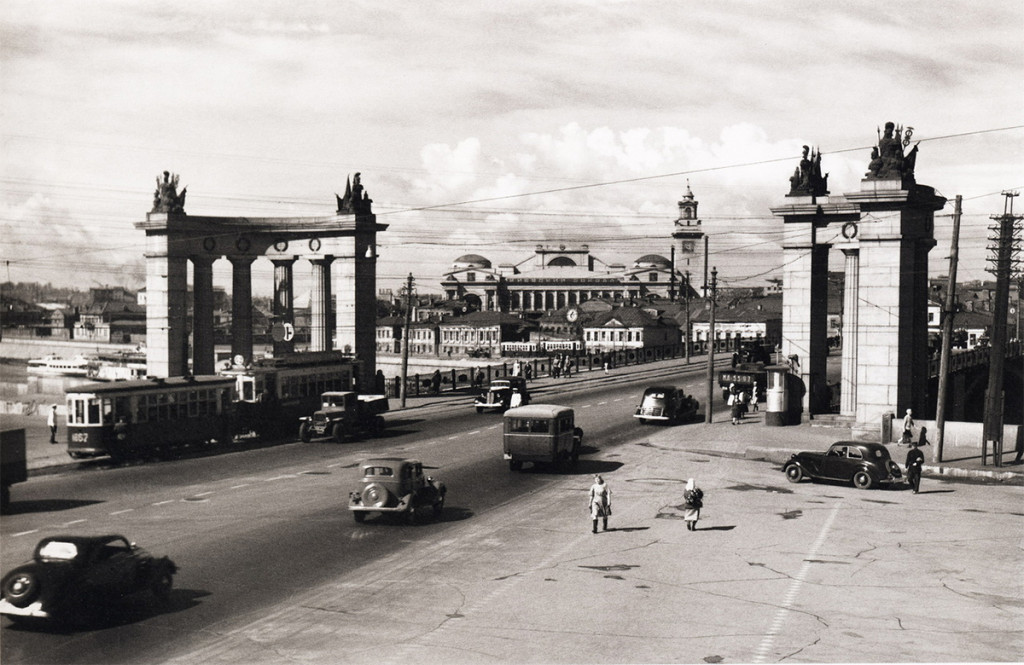
В конце 1930-х появились первые дипломатические знаки, которые выдавались сотрудниками иностранных посольств – они имели три цифры вместо четырех и литеру «Д» в правом верхнем углу. А в 1940 г. в обиход вошли особые номера для военной техники, хотя единого стандарта ведомства не придерживались. Основной формат предполагал букву и пять цифр, но их расположение варьировалось, дефисы ставились произвольно, а некоторые части дополнительно использовали на табличках собственные знаки различия.
Желтые номера. 1946-1959 годы
Масштабная реформа 1946 г. была вызвана не только существенным ростом парка, но и неразберихой, возникшей после окончания войны, когда в стране появилось много трофейных машин. Формат с двухбуквенным кодом региона и четырьмя цифрами в целом был сохранен, но сами таблички стали желтыми, а буквы и цифры – черными. Как и прежде, надпись на передних номерных знаках выполнялась в один ряд, на задних – в два, а дипломатические отличались от стандартных только количеством символов и обязательной буквой «Д». Позже диппредставительствам стали выдавать номера на черном фоне.
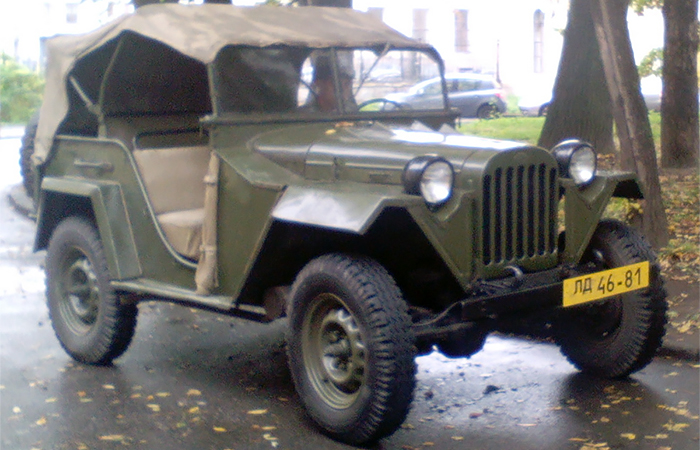
Наконец, были официально введены номера для прицепов – если раньше на них вешали задние таблички грузовика, то теперь они получили собственные таблички того же формата со словом «прицеп». Передние знаки для мотоциклов были отменены, как и пробные и транзитные знаки. На испытаниях автозаводы использовали стандартные таблички, а для транзита выписывали бумажные знаки.
Черные и желтые. 1959–1982 годы
Реформа 1959 г. принесла еще больше форматов. Цвет табличек вновь сменили на черный, цифр осталось четыре, а количество букв в коде региона увеличилось до трех, причем они теперь размещались после цифр или под ними в случае задней номерной таблички. Две буквы сохранили только в номерах для прицепов. Аналогичные номера были введены и для военной техники, но с двухбуквенным кодом региона, причем впервые эти коды соответствовали частям вооруженных сил. Чуть позже – в 1965 г. – регистрационные знаки были введены для сельхозтехники, но от гражданских они отличались и цветом (желтый фон), и количеством букв (две), а также обозначениями «тр-р» для тракторов и «пр-п» для тракторных прицепов. И именно в эти годы впервые была введена форма бумажного транзитного знака для автомобилей, которые крепились внутри на лобовое и заднее стекла. Такие знаки выдавали одновременно с металлическими транзитными, которые содержали слово «транзит».
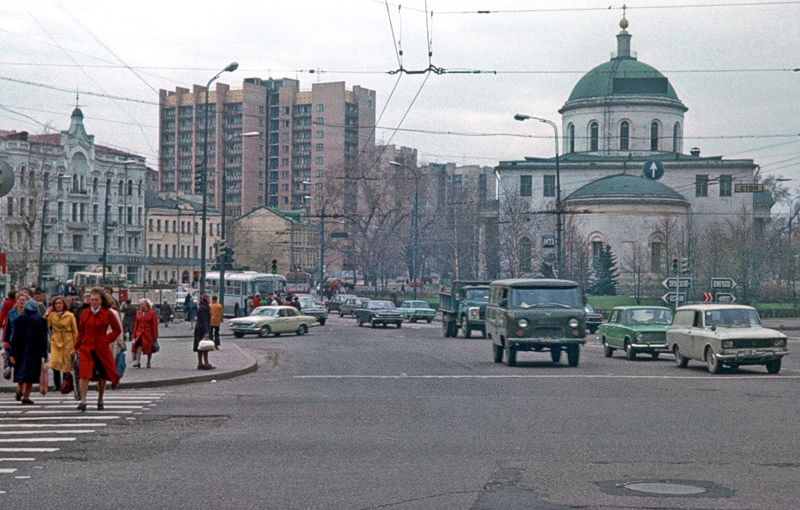
Дипломатические номера стали инверсными, то есть белыми, а литера «Д» сменилась латинской «D». Такие номер выдавались сотрудникам диппредставительств, а журналистам полагались таблички с буквой «K», торговым представителям – с буквой «М», причем в номерах последних также фигурировал двузначный код страны. В то же время появились номера с надписями «проба», «полигон», «спорт» и «милиция». Наконец, стандарт 1959 г. ввел выездные номера, в которых использовались буквы, совпадающие с латинскими.
Белые, желтые и красные. 1982–1993 годы
Последний советский стандарт разработали еще в 1977 г., но вводить начали пять лет спустя. Цвет табличек вновь сменился на белый, а вариантов размещения букв и цифр стало целых три. Частные автомобили получали таблички в формате «буква – 4 цифры – двухбуквенный код региона», у государственных три буквы печатались после цифр, а спецтранспорт, включая автомобили неотложных служб, имел таблички с буквами перед цифрами. Размеры букв и цифр сравнялись, дефис между цифрами исчез. На легковые машины и спереди, и сзади стали устанавливать одинаковые прямоугольные номера, а «квадратные» использовались только сзади на грузовиках. Номера для прицепов отличались от «квадратных» двумя буквами и усеченными углами таблички, похожие использовались на тракторах. А вот на тракторных прицепах использовались «перевернутые» тракторные. Частные госномера квадратного формата ГОСТ разрешил в 1992 г., но реально они не использовались.
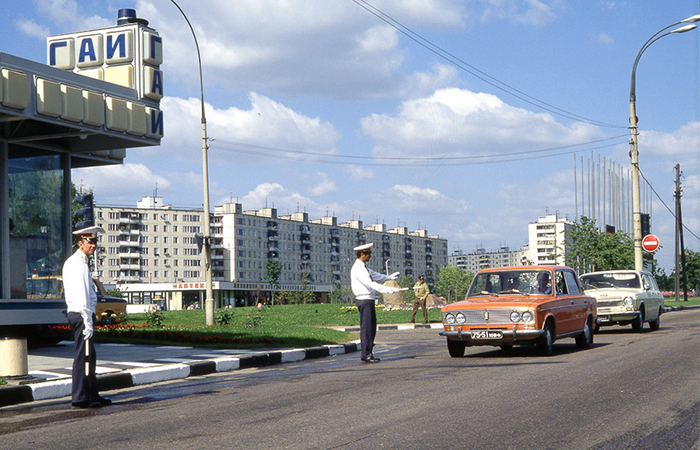
Военные номера остались прежними – черными. Существовал формат, аналогичный гражданскому в черном цвете, но до перехода на российские номера таких табличек было выдано немного. Номера нерезидентов стали цветными: красными с белыми символами – у сотрудников дипмиссий, желтыми с черными символами – у других иностранных граждан. Формат табличек не отличался: латинская буква и четыре цифры, которые кодировали страну или код региона регистрации, а также статус сотрудника посольства, либо указание на машину, предназначенную для экспорта из страны.
Российские номера
Собственный стандарт номерных знаков после распада СССР в России ввели в 1993 году. Таблички остались белыми, но сам номер разделился на две функциональные части: регистрационный знак в формате «буква — 3 цифры — 2 буквы» и цифровой код региона в отдельном окошке. Причем используются только буквы, имеющие аналоги по начертанию в латинском алфавите. Поначалу выпускались упрощенные стальные таблички с простой окраской и без флага РФ, но вскоре номера стали алюминиевыми, фон знака получил светоотражающее покрытие, а под кодом региона появился флаг. Рисунок знаков незначительно менялся в феврале 2005 г., когда в обращение вошли трехзначные коды регионов вместо двухзначных. Для автомобилей и прицепов используются только прямоугольные таблички, а так называемые квадратные предназначались, как и раньше, только для мототехники и сельскохозяйственных машин.
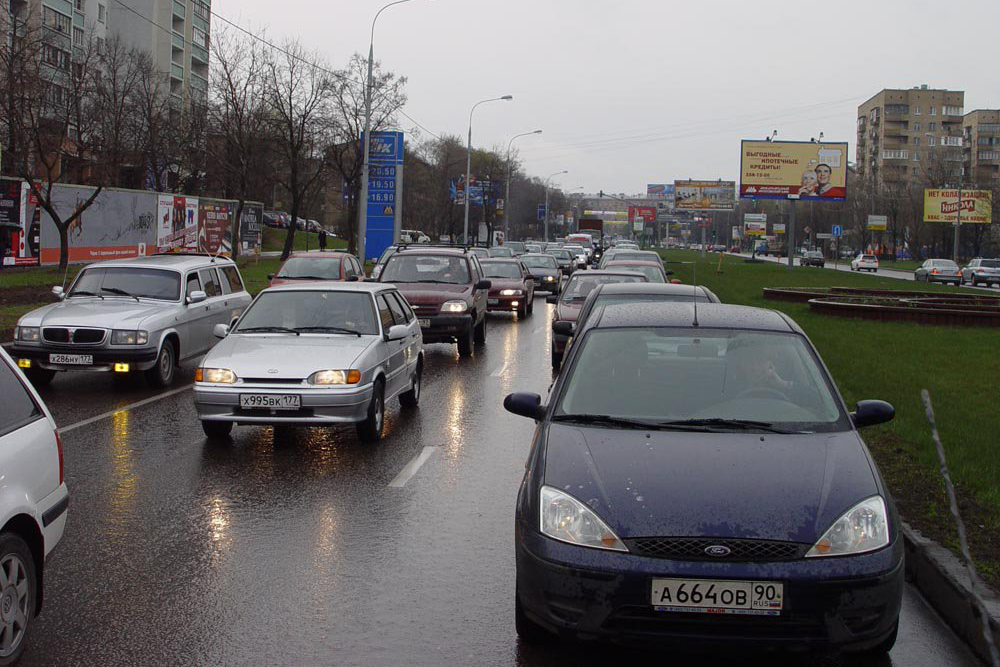
Иные цветовые решения применяются для автомобилей МВД (синий), сотрудников диппредставительств (красный), военных (черный), причем все они сделаны в схожем с обычными знаками стиле, но могут отличаться расположением и количеством букв и цифр. Вплоть до 2002 г. существовала линейка желтых номерных знаков для иностранных граждан, на которых буквой обозначался статус нерезидента. Сегодня желтые номера в формате «две буквы – три цифры» используются для такси и пассажирских автобусов.
Автомобилям, временно снятым с учета, ранее выдавались бумажные прямоугольные знаки с белым фоном и желтым полем региона, а также бумажные транзитные знаки для внутренней установки. А на машины, окончательно выезжающие за границу, ставили алюминиевые таблички с крупной буквой «Т». С октября 2013 г. автовладельцы получили право сохранить номерные знаки при смене машины, а транзитные номера были отменены кроме случаев вывоза автомобиля за границу. Кроме того, стало возможным провести регистрационные действия в любом отделении ГИБДД на территории страны, что лишило смысла использование кода региона.
До 2007 г. существовали также так называемые федеральные номерные знаки с флагом РФ вместо кода региона, которые выдавались высокопоставленным госслужащим и руководителя госкомпаний, и которые фактически являлись привилегированными. На смену таким табличкам по сути пришли традиционные знаки особых серий.
Иван Ананьев
Фото: moiarussia.ru, wikimedia.org/Professor Caretaker, liveinternet.ru, moscowchronology.ru, nik191-1.ucoz.ru, РБК
Какими были “правительственные” номера в СССР, и чем они отличались от обыкновенных? Правда ли существовали специальные серии для машин, выезжающих за границу? В какой республике были уникальные номерные знаки с использованием латинских букв? Мы продолжаем исследование советских номеров. В первой части мы затронули раннюю эпоху с 30-х до 50-х годов, а теперь пройдёмся по более знакомому нашим читателям промежутку с конца 50-х до 80-х.
Чёрные
На переднем однострочном знаке введенных в 1959-м номеров сначала шли четыре большие цифры (две и две через тире), далее три буквы поменьше. На заднем двухстрочном знаке сверху цифры, внизу ближе к центру – буквы. Сечение всех знаков и канавок треугольное.
Шрифт ранее применявшихся «жёлтых» номеров, о которых мы рассказывали в первой части, был более «квадратным», а у «чёрных» – скруглённым. Теперь регион обозначало сочетание первых двух букв. Чаще всего оно и указывало на название города, области, республики.
Деление серий букв по типам транспорта начало расходиться по стране. В Москве и Подмосковье действовало прежнее деление на «частные», «легковые государственные» и «грузовые» серии. В Ленинграде выделялись только серии частных машин, на легковые госучёта и грузовики обычно давали одни и те же серии. Исключение – «ЛЕБ», предназначенная только для легкового государственного транспорта. Во многих городах и областях одни и те же серии давали на любые машины.
Наконец, во многих союзных республиках одни серии обозначали столицу, другие – конкретные области. Рост парка частных автомобилей отразился на сериях номеров. Например, в Подмосковье большинство серий 60-х от «ЮАА» до «ЮАЯ» раздали на грузовики и автобусы, а среди серий второй половины 70-х: «ЮВА»-«ЮВЯ» и «ЮГА»-«ЮГЗ» преобладали «частные».

Больше всего легенд крутится вокруг «спецсерий». В Москве изначально существовали специальные серии: для маршрутных автобусов — «ММА» и такси — «ММТ». Серия «ММЛ» сначала встречалась на легковых госучёта, затем её передали для такси. В конце 70-х появились ещё одна «таксомоторная» серия «МММ» и «автобусная» «ММН». Якобы «правительственная» серия «МОС» официально считалась просто легковой государственной. В ГОНе и других ведомственных автобазах встречались машины с обычными легковыми сериями госучёта: «МОК», «МКО», «МКЖ», «ММЖ», «МНН». Такие же серии носили медицинские, учебные и милицейские легковушки. Никаких специальных серий для милиции и КГБ в чёрных номерах в Москве не было – они получали обычные «государственные» серии.

В каждом регионе выдавались специальные «выездные» серии для международного движения с общими буквами латинского и русского алфавита: «АВТ» в Москве, «АВО» в Московской области, «АВЕ» в Ленинграде, «АЕВ» в Горьком, «ВСВ» в Вологде, «ВРН» в Латвии и так далее. Иногда под «выездные» использовали часть цифровых «десяток» гражданских серий — например, «МОО» и «МОР» в Москве. Уникальное явление – «выездная» серия Эстонии «SSA», обычный чёрный номер с буквами латинского алфавита.

Чёрные номера для мотоциклов, как и желтые, представляли собой один знак, уменьшенную копию заднего автомобильного. Деления на «государственные» и «частные» серии для мотоциклов не было даже в Москве, сочетания букв повторяли любые автомобильные. На прицепы выдавался двухстрочный знак с цифрами сверху, двумя буквами в нижнем левом углу, за которыми следовала надпись мелким шрифтом «прицеп».
Для машин конструкторских бюро автозаводов и институтов, а также автомобилей с конвейера, проходивших обкатку на дорогах общего пользования, предназначались специальные номера с четырьмя обычными цифрами и надписью «проба», по формату близкие к обычным – спереди однострочный, сзади – двухстрочный. Отдельные типы номеров существовали для тракторов, тракторных прицепов и мопедов.

Долгое время машины с новыми «чёрными» и старыми «жёлтыми» номерами встречались на дорогах одновременно. В середине 60-х ещё более 50% автомобилей по стране ездили с номерами старого стандарта. В Москве массовую перерегистрацию государственного и грузового транспорта ГАИ устроила в 1967 году к 50-летию Октябрьской революции, а частных машин – в 1970-м, к 100-летию В.И. Ленина. В других городах и областях «жёлтые» номера вытеснялись «чёрными» с естественным обновлением парка до 70-х. «Жёлтые» номера попадаются на рынке ретро-техники до сих пор, иногда вместе с древними автомобилями-носителями. «Чёрные» номера – вообще не редкость, они ещё встречаются даже на эксплуатируемых автомобилях-ветеранах.
Белые
В 70-е годы Всесоюзный научно-исследовательский институт безопасности движения совместно с ГАИ разрабатывал новый стандарт, соответствующий международным нормам. Так были созданы принципиально новые «белые» номера ГОСТ 3207-77. У разных типов транспорта появились разные номера. У частных машин третью букву вынесли вперёд, перед цифрами, и сделали уменьшенной. У государственного транспорта три буквы, как и прежде, следовали за четырьмя цифрами. Но на легковые автомобили выдавалась пара однострочных номеров, а грузовикам и автобусам полагался задний двухстрочный. Теперь инспектор ГАИ и любой гражданин могли с первого взгляда определить форму собственности автомобиля. Размеры знака и шрифт увеличились, тире было упразднено. Белый фон и чёрные знаки предполагали введение светоотражающей плёнки, но это новшество внедрить не удалось.
Первые опытные серии «белых» номеров раздали летом 1980 года на транспорт, обслуживавший Московскую олимпиаду. С января следующего года их начали выдавать на государственный транспорт, причём за год были заменены номера на машинах всех столичных предприятий, учреждений и автобаз. В области тот же процесс затянулся года до 1984-го. На московских частных машинах белые номера появились в мае того же 1981 года, на подмосковных – в августе. Полную перерегистрацию частного транспорта провести не удалось, хотя попытки предпринимались. Чёрных номеров на частных машинах всё равно осталось очень много — и в столице, и в регионах.
Серии букв белым номерам чаще всего доставались в наследство от чёрных. Но бывали и отличия. Так, в Подмосковье на автомобилях отказались от буквы Ю. На государственные легковые и грузовые машины давали серии «МЕА»-«МЕЯ», потом, с 1987 года – «МЗА»-«МЗТ». Частным областным автомобилям сначала выдали от «А-МЖ» до «Я-МЖ», затем от «А-МЕ» до «Я-МЕ», и уже в начале 90-х – «А-МЗ»-«Н-МЗ» и «А-МЛ»-«Г-МЛ». У ленинградских частников основными стали серии от «А-ЛД» до «Я-ЛД». В Москве у такси остались три старые серии, а автобусам вместо «ММА» дали «МНА». Именно в белых номерах появились специальные серии для милиции и пожарных машин: в Москве — «МКМ» (в чёрных номерах была «частная»), в области – «МОМ» и «МЕЧ».
У мотоциклов номер опять стал уменьшенной копией заднего «грузового», а прицепам сделали совершенно новый двухстрочный с четырьмя цифрами сверху, двумя буквами снизу и скошенными нижними краями.
Перестроечные
В эпоху перестройки началось труднообъяснимое. Например, в 1988 году «специальным» легковым автомобилям – медицинским, учебным, спортивным, инкассаторским – обычные номера поменяли на «перевёрнутые» с буквами впереди цифр: московские серии «ММС» и «ММР», подмосковная «МЗС» и так далее. В столице появилась серия для кооператоров «МКЗ» в легковом и грузовом вариантах. Гражданские серии стали выдавать не по алфавиту, а вперемешку. «Выездные» серии – всем подряд.
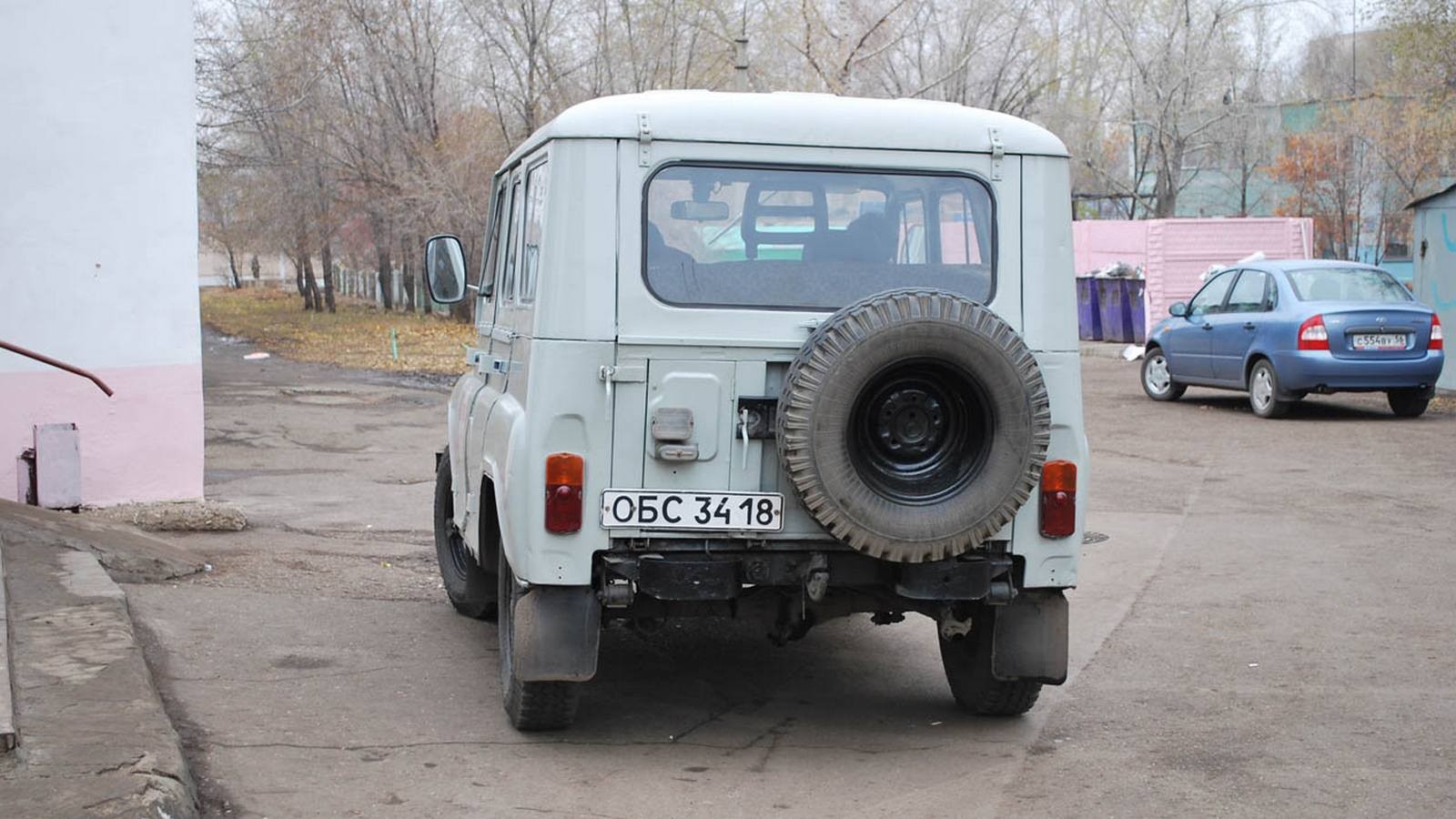
Начались грубые нарушения ГОСТа. Сначала появились целые серии с «нестандартным» шрифтом, потом на некоторых сериях вообще ввели «немецкий» шрифт. В некоторых регионах погибающего СССР (Минск, Крым) грузовые номера с парой из однострочного и двухстрочного замелькали на частных легковушках. Московским грузовикам досталась эстонская серия «ЕАТ», а подмосковным – «ЕАХ».
После развала СССР каждая из бывших союзных республик ввела свой стандарт номеров. В Российской Федерации номера нового ГОСТа, с некоторыми изменениями действующего до сих пор, появились в октябре 1993-го. Они получили не доставшийся белым советским номерам светоотражающий фон и обозначение региона цифровым кодом по французскому образцу. История повторилась: в 1934-м за основу взяли один иностранный стандарт, а ровно 60 лет спустя – другой.
Регистрация городскими властями транспортных средств сопровождалась выдачей табличек с номерами еще до изобретения автомобиля. Неудивительно, что с…
Регистрация городскими властями транспортных средств сопровождалась выдачей табличек с номерами еще до изобретения автомобиля. Неудивительно, что с появлением автомобилей и впоследствии — органов, отвечающих за безопасность дорожного движения, в обязанности последних были вменены учет транспорта и выдача регистрационных номеров.
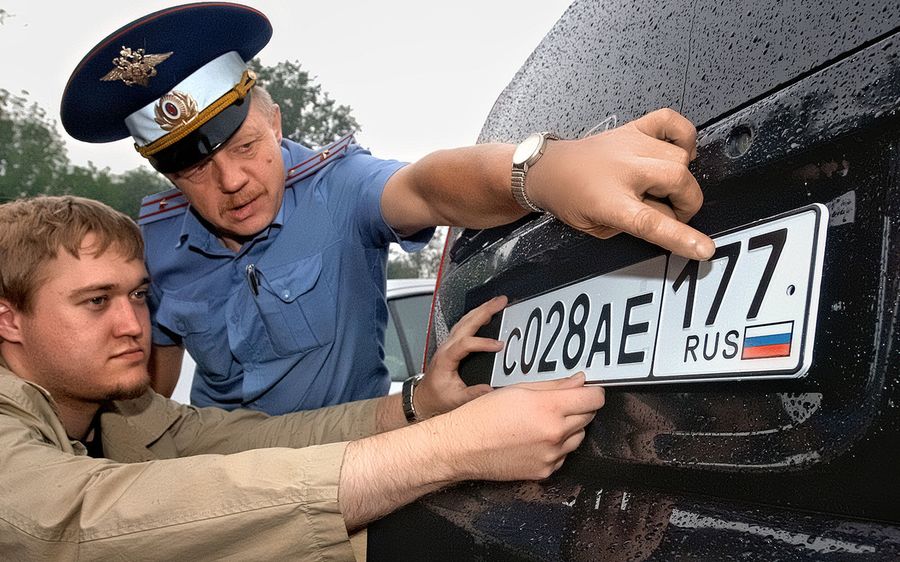
Присваивать средствам передвижения индивидуальные номера первыми начали фискальные органы. Владельцы повозок, занимавшиеся на городских улицах извозом, обязаны были ежегодно уплачивать в городскую казну определенный налог. Выдаваемая взамен бляха с номером являлась всего лишь свидетельством об уплате — чтобы извозчиков лишний раз не «дергали» блюстители закона.
Однако практика наглядной «сертификации» прижилась, и впоследствии, когда возникла необходимость визуализировать регистрацию первых автомобилей, изобретать велосипед не стали — владелец авто получал табличку с номером. И вновь речь шла вовсе не о возможности поиска по «базе данных» некоего конкретного автомобиля среди собратьев.
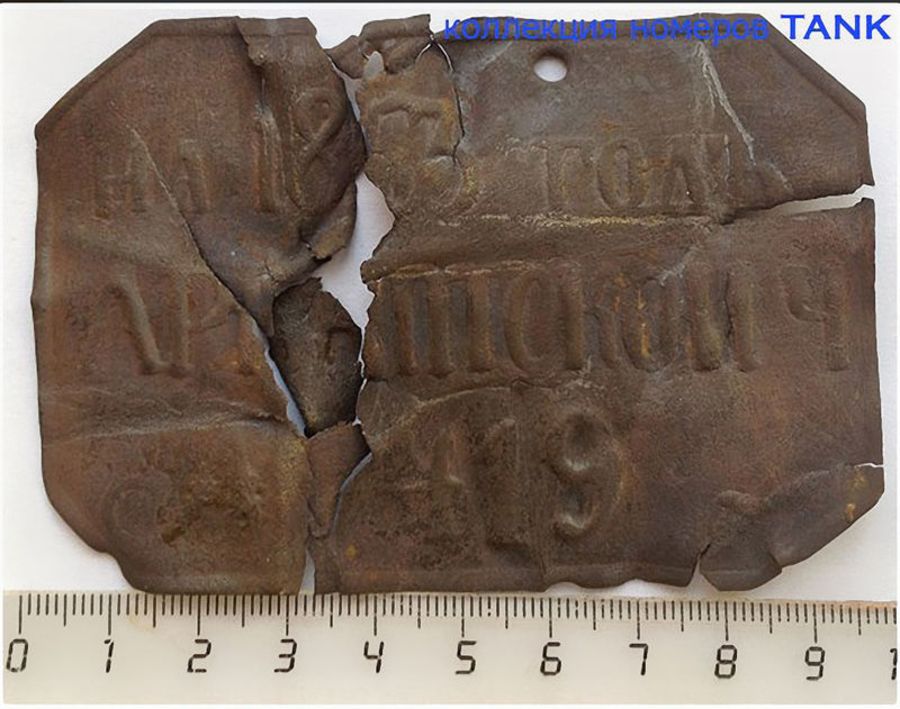
Подобную роль номерные знаки начали играть лишь с распространением массового конвейерного производства машин. На рубеже XIX-XX веков автомобилей было так мало, что в случае правонарушения или иного инцидента установить виновного не составляло труда. Тем не менее регистрация в большинстве крупных городов требовалась — просто для порядка.
Считается, что первенство в выдаче регистрационных номеров принадлежит Мюнхену. Там таблички с номерами начали устанавливать на машины в 1899 году. Эстафету подхватили в крупных городах других стран: Париж (1900 год), Нью-Иорк (1901 год), Лондон (1903 год).

В дореволюционной России решение о необходимости регистрации автомобилей принимали городские власти. 25 июня 1900 года Городской Думой Санкт-Петербурга было принято постановление «О порядке пассажирского и грузового движения по городу Санкт-Петербургу на автомобилях».
В числе прочих регламентирующих положений наличествовал пункт, вводящий обязательное медицинское освидетельствование водителей, ежегодный технический осмотр автомобилей и их обязательную регистрацию с выдачей номерных знаков — «жестянок». Однако ввиду малочисленности машин и «экзотичности» закона нововведение в Санкт-Петербурге не прижилось. Всерьез практику обязательного крепления к авто регистрационного номера первыми в Российской империи освоили рижане в 1904 году.
Серьезные подвижки произошли в конце первого десятилетия XX века. По итогам прошедшей в сентябре 1909 года в Париже первой Международной конференции по проблемам автомобилизма была принята «Международная конвенция относительно передвижения автомобилей», регламентирующая все, что касалось регистрации и эксплуатации автомобилей.
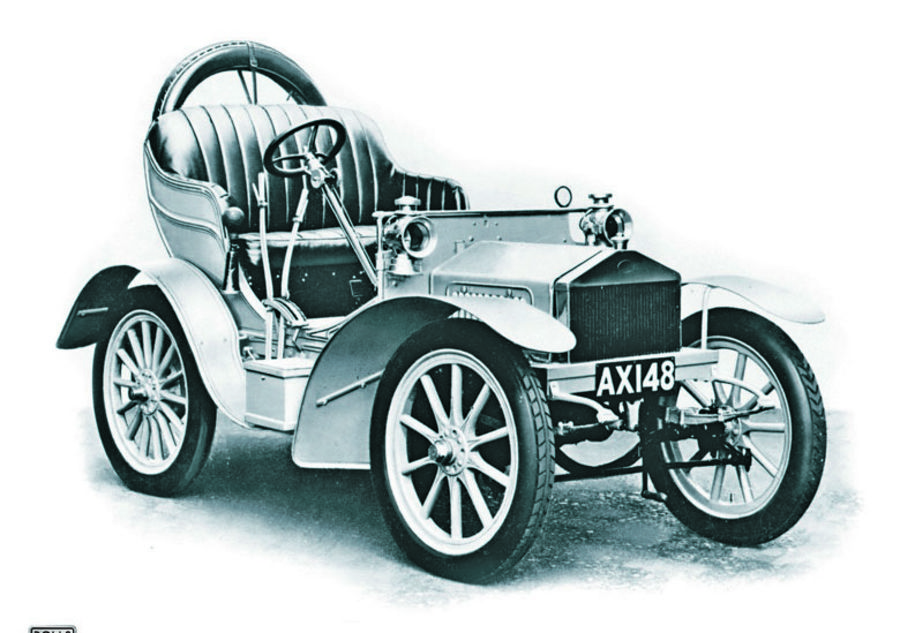
В феврале 1910 года Николай II эти правила ратифицировал, и на территории России вступили в силу новые административные уложения для автомобилистов. В числе прочих нововведений была и обязательная регистрация транспортных средств, однако ведали ею по-прежнему местные власти.
Между тем, автомобилей становилось все больше, и очень скоро «власти» вспомнили о практике «сертификации» извозчиков. Была введена обязательная ежегодная перерегистрация всех машин, в результате которой владелец каждый раз получал новый номерной знак.
Чтобы определить, не задолжал ли автомобилист городской казне, в Москве пошли на хитрость: каждый год выдавались номерные таблички нового цвета. Санкт-петербургские номера начала XX века затейливостью не отличались. Они были белыми, с черными цифрами.
При этом численность автотранспорта в российских городах была столь незначительна, что для учета вполне хватало одних только цифр. Более того, в большинстве населенных пунктов спокойно обходились трехзначными числами. Исключение составляли Санкт-Петербург и Москва, где номерные знаки были четырехзначными. В первопрестольной, например, к 1914 году числилось 2200 официально оформленных автомобилей.
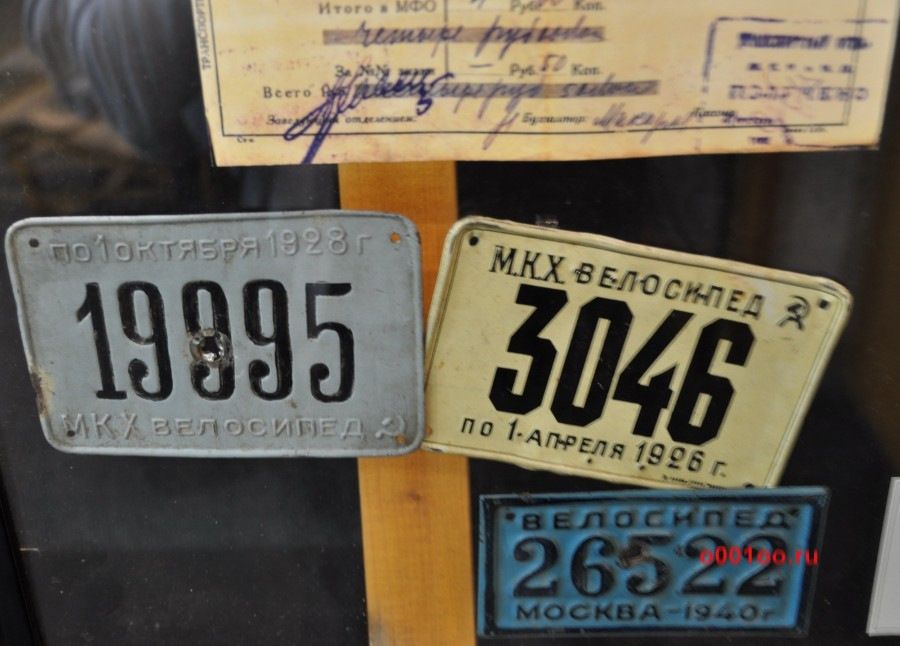
В годы Первой мировой войны и послереволюционный период автотранспорт так часто менял дислокацию, владельцев и назначение, что ни о каком внятном учете не было и речи. А в начале 20-х годов советская власть вернулась к дореволюционной практике регистрации автомобилей органами местного самоуправления.
В Москве к концу 20-х годов число автомобилей заметно увеличилось, и для простоты чтения номеров и удобства их запоминания к цифрам впервые в отечественной истории добавили букву. Московские номера тех лет выглядели так: одна буква и две пары цифр, разделенные между собой черточками. Черные знаки наносились на белый фон. Спереди и сзади такие номера были одинаковыми. Именно этот стандарт и стал некоторое время спустя первым общесоюзным. Произошло это в самом начале 1930-х.

20 марта 1932 года СНК РСФСР, вдохновленный удачным опытом на местах, принял постановление «О централизации учета аварийности и происшествий на местном транспорте в органах рабоче-крестьянской милиции», превращавшее частную практику. После Великой Отечественной войны номерные таблички на автомобилях стали желтого цвета московского ОРУДа в общегосударственную систему. Отныне регистрацией автотранспорта на местах занимались не городские чиновники, а милицейские подразделения.
«Московский» стандарт номерных знаков просуществовал недолго. Уже в 1934 году был введен новый стандарт. Место буквы в начале «шифра» заняла еще одна цифра, а под пятизначным кодом без затей писалось название региона: «Москва», «Ленинград» и т.п. Цвета знаков остались прежними, задний и передний номера ничем не отличались друг от друга.
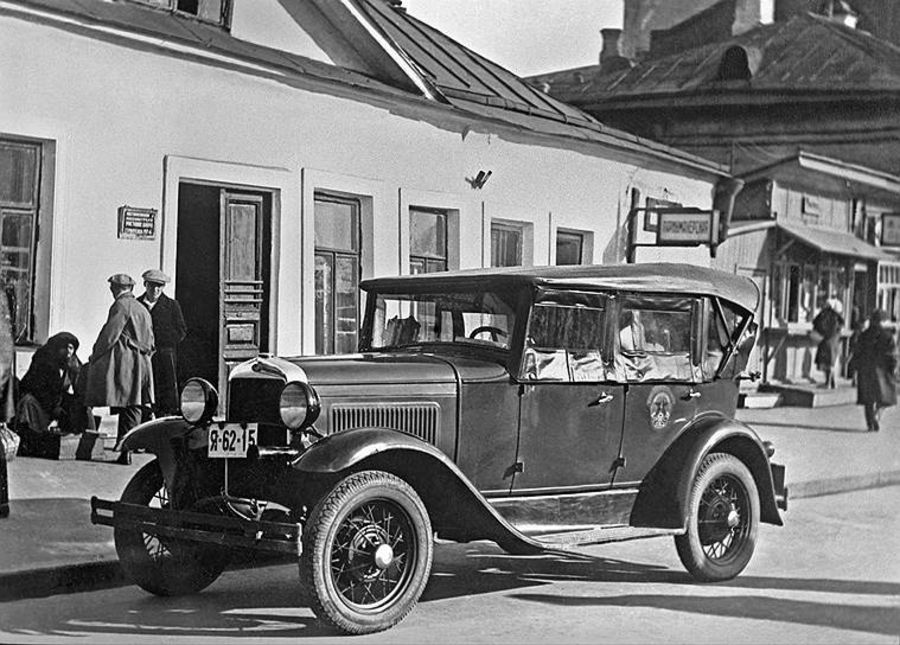
С 1932 по 1936 год регистрацией машин и выдачей номерных знаков ведали ОРУДы. 3 июля 1936 года СНК СССР принял «Положение о Государственной автомобильной инспекции (ГАИ) Главного управления рабоче-крестьянской милиции НКВД СССР». С этого момента и до наших дней административно-технической работой, в том числе и постановкой транспортных средств на учет, занимается ГАИ и её правопреемница — ГИБДД.
Тогда же, в 1936 году, был введен новый стандарт номерных знаков: на черный фон наносились белые символы — две буквы, в первой из которых «зашифровывался» регион, и две пары цифр через черточку. При этом на передних номерах все знаки располагались в одну строку, а на задних — в две, вверху были буквы.

В довоенных задних номерах буквы стояли в центре, а в послевоенных — в левом углу. Тогда же, правда, лишь в Московском регионе, впервые произошло разделение серий по назначению. Немногочисленным автомобилям, находящимся в частной собственности, выделили серию «МИ»; легковым автомобилям госчиновников — серию «МА».
Незадолго до войны номера специального образца получил автотранспорт Красной Армии. Регистрационный код состоял из одной буквы и пяти цифр, сгруппированных так: «А-9-99-99». Этой системы нумерации Вооруженные силы СССР придерживались до начала 60-х годов, когда были введены армейские номерные знаки нового образца: четыре цифры и две буквы, написанные белой краской на черном фоне. Буквенные сочетания но-прежнему не позволяли определить войсковую и географическую принадлежность транспортного средства.
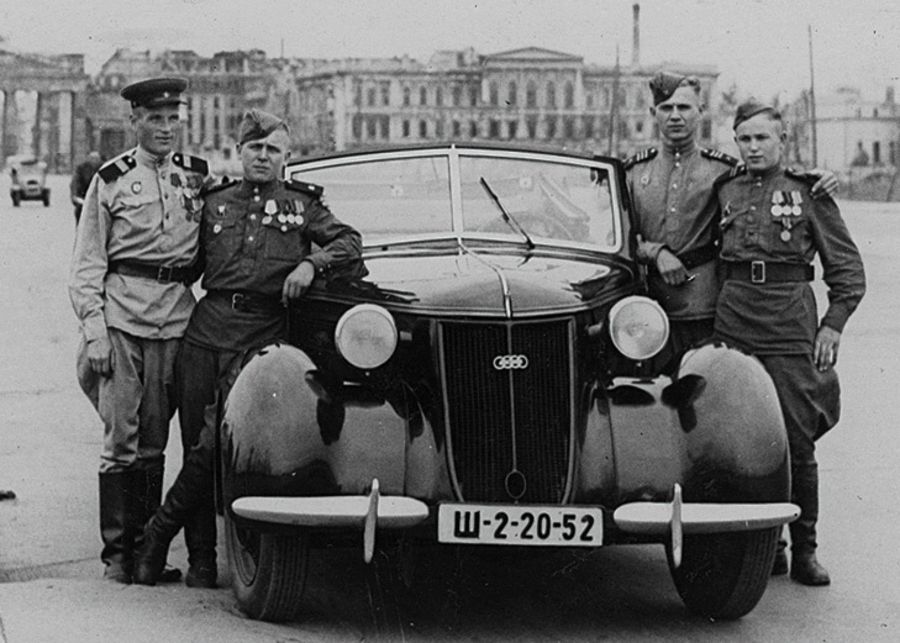
А гражданских номеров очередная реформа коснулась в 1946 году. Номерные знаки нового образца поменяли цвет: черные символы наносились на желтый фон. Буквы но размеру стали меньше, чем цифры, и находились в верхнем левом углу на переднем знаке и в верхней строке посередине — на заднем.
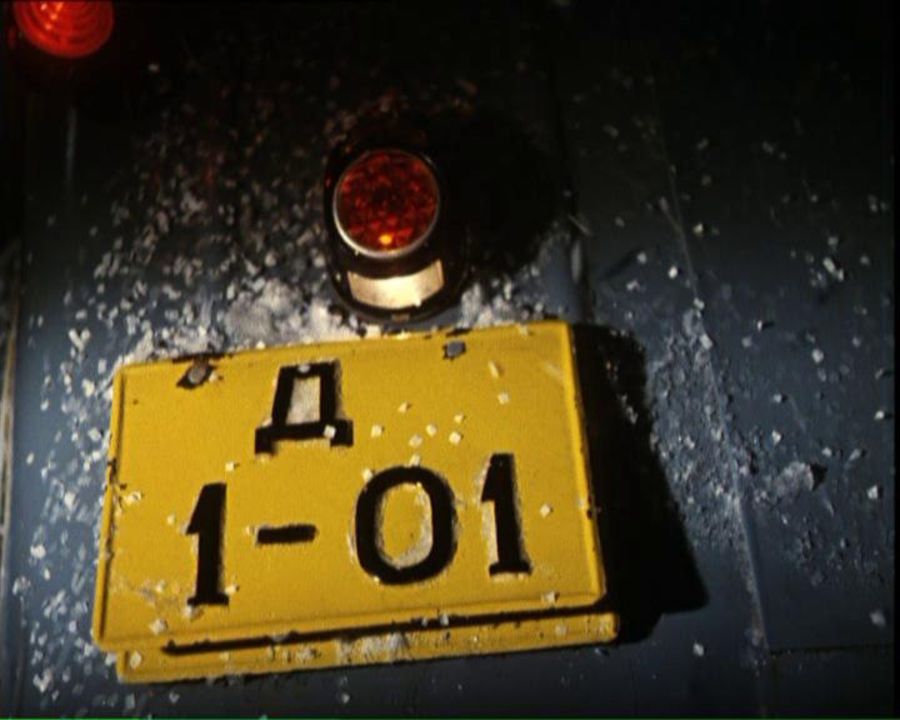
Автопарк страны в послевоенные годы стремительно разрастался, и довольно скоро шифр из двух букв и четырех цифр исчерпал все возможные комбинации. В 1959 году пришлось вводить новый стандарт: белые символы на черном фоне, причем букв стало три. Такие номера выдавали вплоть до 1981-82 годов.

Очередная смена стандарта произошла вскоре после Московской олимпиады 1980 года. Впервые с 1934 года номера украсили черные цифры и буквы на белом фоне. Главным новшеством являлось разделение номерных знаков на «частные» и «казенные».
Две буквы из трех по-прежнему были созвучны названию региона, третья также менялась в алфавитном порядке по сериям, но именно местоположение этой буквы позволяло определить «принадлежность» транспортного средства. На номерах частных автомобилей она стояла первой, перед цифрами, а на номерах гостранспорта — последней, после двух «региональных» литер.
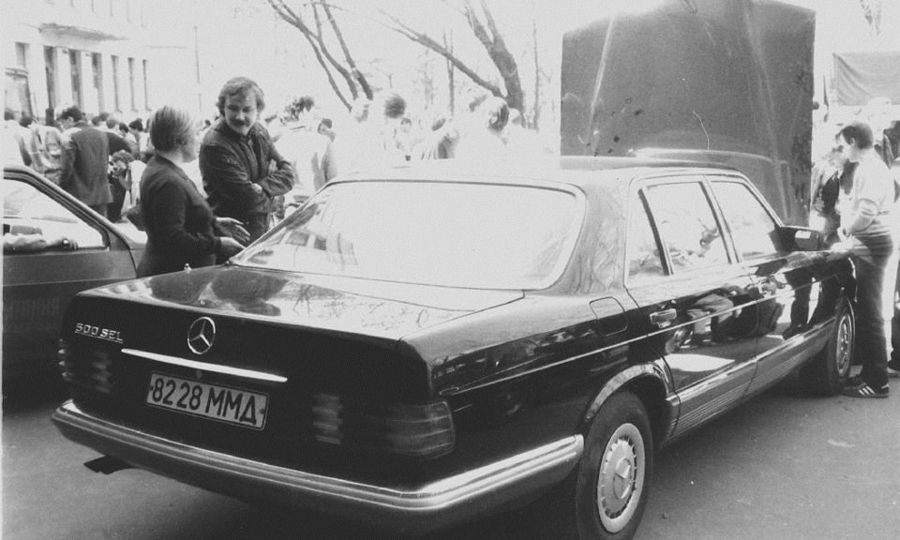
Очередной (ныне действующий) стандарт номерных знаков в России ввели в 1994 году. На новых номерах буквенное обозначение региона заменили цифровым — каждому региону был присвоен двузначный (в исключительных случаях — трехзначный) код. Все три буквы, равно как и цифры, подлежат последовательной ротации.


A governmental vehicle registration plate of the 1982 format. This specific plate is one of the earlier series of this format, as later series have thicker strokes for its numbers and letters.[clarification needed]
Vehicle registration plates (Russian: Регистрационные знаки транспортных средств, Registratsionnye znaki transportnykh sredstv, lit. ‘Registration Plates of Vehicles’) were used in the Soviet Union for registrations of automobiles, motorcycles, heavy machinery, special-use vehicles as well as construction equipment, military vehicles and trailers. Every vehicle registration plate contains a unique registration mark embossed on a metal plate or a plate made of other materials. All vehicles were required to display the plates on the front side and backside, with the exception of trailers and motorcycles, which were only required to display one on the backside.
History[edit]
Russia’s first attempts to hold accounts for horse-drawn carriages driving through cities were taken in the 19th century to only prevent tax evasion by their owners. Sometime in the 19th century, every coachman and his carriage had to have a registration number which was only valid for a year, and they had to pay the tax in order to have a replacement. In the 1890s, after the resolution on the admission of cyclists in traffic was published, bicycles were also made subjects to compulsory registration. Automobiles, which appeared later, also needed such registration.
There was no standard for the registration numbers at that time. Every city had its own plate format and color, and the background color for the plates could vary from year to year in a single city. The plates were required to contain a numbers-only registration number and optionally the name of the city, the year of issue, the type of the vehicle as well as other information as demanded by local authorities. Plates for automobiles were similar to those for bicycles in appearance, but are five to eight times as large. Regular fixation points were not provided for automobiles at that time, so the plates were simply drilled to have two holes, and were suspended with ropes going through them.
In 1920 the first attempt to standardize vehicle registration plates was made. On June 13, 1920, a decree named «On registration plates» was published, which required all vehicles to mount the front license plate on the left wing and the rear one on the backside. In 1927 the standardization proceeded with the introduction of «Rules of the All-Union Registry of Cars and Motorcycles», which standardized the form of the plates, dimensions for front and rear plates, as well as those for motorcycles, the color and height of the characters, and the width of each character stroke, whereas the background color continued to vary annually.
However, these changes did not affect registration plates of carriages and bicycles, which continued to vary in shape and color until their cancellation, which, for the carriages, was in the 1930s and until the publishing of a decree on the cancellation of registration of bicycles by 1970.
By the early 1930s the number of automobiles and motorcycles skyrocketed, with frequent trips from a city to another «on motors». To conduct a full registration of all cars and motorcycles across the country, a unified standard for license plates for cars and motorcycles came into force in 1931.
1931 to 1946[edit]
During the 1930s the format of plates never standardized.

The first Soviet registration plates issued in 1931 had an «L-NN-NN» format, where L represents a Cyrillic letter and N being a number. Every registration is linked to a single vehicle, while motorcycle plates differ from those for cars in terms of dimensions. Two license plates were issued to every vehicle: a frontal plate and a rear plate. Frontal plates for motorcycles were to be mounted along the front wing of a vehicle, while rear ones were to be mounted perpendicular to the rear wing. Registration plates for test-drive vehicles appeared later, which contained the word «проба» (proba, literally «test») on the top, with the first pair of digits absent, therefore forming the format «L-NN». Two major drawbacks of this format were later found, with the first being that the letter was issued in sequential order regardless of any situation, while the second is that a letter could stand for two sparsely populated regions, and on the other hand, a large city could possess a number of letters. These drawbacks caused the termination of this format in 1934.

In 1934, a new replacement standard was set: the letter on the former design was changed to a digit, and there was the name of the registry, or «Dortrans» below the digits. There were at first 45 Dortrans, one for each region, under the administration of the Central management of highways and dirt roads and road transport at the Council of People’s Commissars of the Union of Soviet Socialist Republics, known in short as the TsUDorTranse, and then after a reorganization of administrative divisions, the number went up to 52. The former format was considered temporarily valid and owners must change to the new format before July 1, 1934. The format was not strictly defined, i.e. there need not to be exactly five digits on the plate, and the name of the region could reach up to 8 characters excluding dots and dashes, which made it often written in abbreviated form. Test and transit plates remained their format, except that the name of the Dortran was replaced by the word «транзит» (tranzit, «transit»), or «проба» (proba, «test»). These plates have the same color schemes as ordinary plates, but there were also plates for experimental vehicles in an inverse scheme.
![]()
Frontal plate format in 1936
At the end of 1936 the format changed once more, when the beginning of the sequence switched to a two-letter code of the regional registry, followed by two pairs of numbers separated by a hyphen, which made it an «LL NN-NN» pattern. The code uses letters of the Russian alphabet except for «Ё», «Й», «Ъ», «Ы» and «Ь». There was a single-line frontal plate plus a double-line rear plate for each vehicles, with motorcycle plates bearing the same format, albeit in a smaller size. This difference existed until 1994. Trial and transit numbers also remained, which replaced the region code with the word «транзит» (tranzit, «transit»), below which positioned a factory code.

Rear plate in 1936 format

Military registration from 1940 to 1960; note the arbitrary hyphening
Near the end of the 1930s, in coordination to the current format, there was also a so-called «уменьшенный» (umen’shennyy, literally «reduced») format: The plate was smaller, used a narrower and slimmer font, while the regional code became physically smaller, was placed in the top-left corner, with the numbers down-scaled. At the same time a single format was developed for trailers, but seldom given. Subsequently, this format became the basis for the next change.
Shortly before 1941, all military equipment received a number format different from the civil format, the «L-N-NN-NN» format. Before this there was no system for military plates at all. Moreover, there are a number of documented cases of plate type violations, including arbitrary hyphenation, adding of stars or anchors, and even violations concerning format, such as plates containing 4 to 6 digits, with 4 digits often for motorcycles, but with exceptions.
A GAZ-MM truck showing its 1940-standard military plate.
At the end of the 1930s, the first diplomatic plates were issued. Based on the «reduced format», a single digit replaced the first pair of numbers, with a large letter Д in the upper right corner.
1946 to 1959[edit]
After World War II the registration went into chaos with cars that had lost documentation, «mobilized» machines, war trophy equipment, automobiles and captured re-registered vehicles. All of these had to be taken into account, which prompted a mandatory replacement of old license plates with new ones in 1946.

Front plate format in 1946

Rear motorcycle plate in 1945

The new format was once again based on the old «reduced» format, only changing the color of the background to orange and the color of letters and numbers to black. Diplomatic plates used a different «Д-NN» format for frontal plates, with the Д on the top row and the digits on the bottom row for rear plates. There were also formats for trailers, which formerly bore the same number as the truck attached to it. The format for trailers was the same as the rear version of civil plates, only with the inscription «прицеп» (pritsep, «trailer») next to the regional code.
At that time, there existed a white-on-black format which is to be assigned to business- and privately-owned cars. Later, this color scheme along with diplomatic plates were put into use.
An interesting fact is that this standard did not concern test and transit plates. As «test» plates were common in autonomous regions, plates starting with «00» or «01» were often reserved for them, and the transit plate could be produced in any form on paper.
Front plates for motorcycles ceased to be issued in 1946, ending the trend in which all motorcycles, similar to cars, had to have two plates, of which the front plate was single-lined, and attached to the front fender.
Since the 1940s, large enterprises and car factories were allowed to have their own license plates for test-drive and internal transport, without leaving the territory of the factory. Some enterprises have modified their plates to conform to the standard, while others remained unchanged. For example, cars for internal transport within VAZ in the 1980s have registration plates similar to the Soviet standard, but the three-letter suffix was always the letters «ВАЗ». These plates could still be found in some modern car factories.
1959 to 1982[edit]

Civil vehicle format in 1960
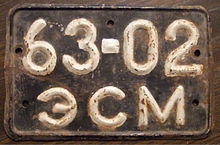
Motorcycle plate of the 1960 format

Military rear plate in 1960 format
In 1959, a reform on the format of registration plates within the USSR began, changing the format to «NN-NN LLL», with the first two letters acting as a regional code, and the last letter simply being a serial, again in a white-on-black scheme. Plates for trailers, as in the previous format, received only two letters, both making up the regional code, with the word «прицеп» added next to it. The introduction of the third letter would cause the numbers and letters to physically exceed the limits of a registration plate in the previous formats, which is another reason for the reform.

Military plate of 1960 format

In the early 1960s, military equipment were issued new types of registration plates, with the format almost identical to the civil type, but dropping the third letter (therefore creating the «NN-NN LL» format). Contrary to previous formats where the letters and numbers carried no information on the unit that was issued plates, the regional code was organized by the Armed Forces of the USSR themselves, which is why military plates don’t actually «collide» with civil ones.

A tractor plate of 1960 format

Trailer plate in the 1960 format
In 1965, two new types of plates were introduced specifically for tractors and tractor trailers. Previously, registration for tractors was not compulsory and motorcycle plates were issued to them instead, while trailers were not subject to registration at all. The color scheme was inherited from the previous format as black-on-orange, but the indication of a tractor and a trailer has been shortened to «ТР-Р» and «ПР-П» (shortened from «трактор» and «прицеп», «tractor» and «trailer») respectively. Sometimes a tractor bearing a plate that has a white-on-black scheme could be seen, which was originally intended for military use. However, this distinction soon faded as civil tractors and military ones soon bore plates of the same format.
In response to a growing car market and the increasing demand of purchasing and selling cars from different regions, the oblong transit plate was introduced, based on paper. When registered, the car was given two plates which should be attached to the inner side of the windshield and the rear glass. The word «транзит» and «передний номер» (perednyy nomer, «front number») or «задний номер» (zadnyy nomer, «rear number») was written on the top row, the second row contained the three-letter regional code (or the two-letter one for military vehicles), and the third row housed the four digits. The oblong metal transit plate was similar to the paper plate, but the regional code contained only 2 letters, which were positioned beneath the word «транзит». This format does not distinguish between civil and military equipment.

Diplomatic plate, frontal, 1960 format

Diplomatic plate, rear, 1960 format
The diplomatic format received a change as well. The color scheme was the inverse of that of normal plates (white-on-black). Initially, it was the same as the previous diplomatic format, only with the letter «Д» moved to the first place (or to the bottom row on rear plates), but later on the Cyrillic letter eventually got replaced by its Latin equivalent, «D». From the mid-1960s onward the standard for plates belonging to foreign entities was in force, which sets the format as «L-NN-NNN», where a «D» in the place of L meant a member of diplomatic representatives, a K for news correspondents, and an M for sales representatives. It is worth noting that there was a slight change for the plates beginning with M, which removed the dash between the letter and the first number. For example, «M51 01-10» where the first two numbers succeeding the M is the country code.
In the same year, three more variants were introduced, which replaced the regional code with the word «проба», «полигон»(poligon, «testing grounds»), «спорт»(sport), or «милиция» (militsia, «police»). The «Testing grounds» and «Sport» plates bore only one digit at the start of the number sequence, which were issued to vehicles meant for testing on the automobile testing grounds and for those taking part in sports events, respectively. All of these had their sequence drawn onto the board instead of embossed on it. Motorcycles belonging to the MVD initially had these three variants, but after a standard was introduced later, motorcycles from MVD began receiving regular plates.
Since this standard was introduced, all vehicles travelling abroad for a short period of time had to receive a «replacement plate» before leaving the USSR. The format of these replacement plates retained the white-on-black scheme, but the letters forming the three-letter code was restricted to those that coincide in shape with Latin letters, and special regional codes for exiting the USSR were reserved. These replacement plates were either valid All-Union or republic-wide. Upon travelling abroad one has to get a replacement plate from the traffic police (with the exception of those who had plates that had no special Cyrillic letters), and must hand the replacement plate over when one returns to acquire his/her original plates.
At first the switch from the 1946 format to the new format was not compulsory, but a decree issued in 1967 required all vehicles to replace their plates. Despite the decree, citizens were not in a hurry to replace the plates, and the traffic police didn’t insist on this much either. In 1970, on the 100th anniversary of the birth of V. I. Lenin, a decision was made regarding restoration of order, which created a stir within areas of the National Traffic Police. One consequence of this spur-of-the-mind decision was the decision to terminate registration of all traffic police mopeds and bicycles. Before this, mopeds had a reduced size of normal license plates, and in a reverse format, and the plates for bicycles differ from city to city with annual re-registration.
1982 to 1991[edit]

Civilian plate of 1980 standard

Government plate of 1980 standard; note the straight tail of 6.

Special-use vehicle plate of 1980 standard; note the rounded tail of 9.

Square plate for buses and trucks; note the straight tail of 9.

Motorcycle plate of 1980 standard; note the straight verticals of 0.
In 1980, on the eve of the Moscow Olympic Games, the next reform of plates was conducted. This standard, developed in 1977, inverted the color scheme again to black-on-white. There were two basic variants: one for civil vehicles which were in the «L NN NN LL» format, and the other for government vehicles that bore the «NN NN LLL» format. Another difference between government plates and civilian plates is that the first letter of civilian plates were smaller than the rest, while the letters of government plates were of equal size. The square plate was used as the rear plate of trucks, buses and motorcycles. Private vehicles initially had only the oblong plate, but in addition to GOST in 1992, production of double-row rear plates of private vehicle standard was allowed, which housed the letters in the top row, the first letter still being smaller than the rest, and the bottom row the digits. In 1989, special plates for special-use vehicles (such as emergency services) were introduced with the format «LLL NNNN».
The standard imposed further restrictions on the use of letters, letter «Щ» was added to the prohibited letters as a result, but this letter continued to appear in tractor and tractor trailer plates, as well as serial beginning with «КЩ». In all other situations this letter is not used. The military plates remain unaffected as they retained the old standard.
The 1980 sample continued to change with time, affecting the designs of the letters and digits. Numbers 6 and 9 initially had straight «tails», but then the tails became arc-shaped. Zero was first with straight vertical lines, later becoming a more «egg-shaped» glyph. In Krasnoyarsk Krai the plates have a capital letter «Э», with all projections formerly of the same length, but the upper and lower arcs of the letter were later lengthened and rounded, the central stroke unaffected. Generally, plates issued later have numbers and letters bolder than earlier ones.
At the same time, vehicles of the Russian mining communities on Svalbard, which were previously unregistered, began to receive plates that had a format similar to government plates: four numerals with leading zeros, followed by «АРБ» (ARB) for Barentsburg or «АРП» (ARP) for Pyramiden (Automachina Rudnika — “mining vehicle” — Barentsburg or Pyramiden). These plates were made locally and thus were either flat painted or with different fonts.
Special plates of the former standard were still left to the armed forces’ vehicles, trailers and tractors, as well as diplomats and foreign residents. The military format remained unchanged since 1959, thus the plates belonging to the military began to stand out against the general population. In the late 1980s to the 1990s an updated type of military plates bearing the same coloring scheme and format, but with an appearance similar to civilian plates was developed. But due to the military being reluctant to switch to the new type and a new Russian standard that was put into use in 1993, this type was never widely used and are very rare to see.

Auto trailer plate of 1980 standard; note the straight tail of 6.

Plate for large tractors, 1980 standard; note the thin strokes.

Tractor trailer plate of 1980 standard; note the rounded tail of 9.
Plates for trailers and tractors also went through changes, coloring scheme was put in sync with the civilian plates, but the shape was modified to a square with a «cut» bottom, sloping towards each other, making it a six-sided shape, and bore the format «NN NN LL», with the letters on the bottom and the shorter side. This format is turned upside-down for trailers and special equipment. Different from civilian plates, the regional codes did not bore relationship with the registration region in the same way as civilian plates. For example, the code «КЭ», used for Krasnoyarsk Krai on civilian plates, was issued to the Kurgan region instead, and for Krasnoyarsk Krai itself the code «ЦЦ» was used.

Foreign Resident plate of 1980 standard

Plates for export vehicles of 1980 standard

Diplomatic plate of 1980 standard for rank-and-file diplomats
![]()
Diplomatic plate for technical staff of embassies
Diplomatic plates changed as well: The format changed to «L NNN NNN», and private vehicled used by consuls had the formal «CMD NNN N». In addition, the plates were distinguished by color: Vehicles belonging to diplomatic missions have a white-on-red scheme, while all others bore a black-on-light-orange scheme. The first three numbers on all red diplomatic plates and light-orange plates starting with letters К or М is the country code, which ranges from 001 to 130, while the first three numbers on other plates (namely the light-orange plates starting with Н or Р) stands for the region in which the vehicle was registered, and starts from 501, with all the codes listed below. The letter in the series have different meanings:
| Letter | Meaning |
|---|---|
| D | Embassy staff with diplomatic status |
| T | Technical staff of embassies |
| K | Foreign correspondents |
| M | Sales representative of a foreign company |
| H | Foreign citizen |
| P | Car for export out of the USSR |
There was also motorcycle and trailer plates for foreigners, with dimensions identical to the ones mentioned above, but with a light-orange background.
In the early 1990s, due to a lack of traffic police regulation, there were frequent plate type violations in certain regions. For example, a plate that was meant for tractor trailers or motorcycles could be issued to a private car, whereas motorcycles themselves could get a plate for trailers instead.
In addition, traffic police since 1989 have been officially allowed to permanently retain a number of plates, which caused cars belonging to different regions to carry plates that were meant for a single region. To stop the corruption, a new standard was introduced, which did not require owners to give up previous plates.
After dissolution[edit]

Lithuanian transit plate; note the modified 3
Since 1990, the former constituent republics of the USSR have begun using Soviet-style plates while adding a «national flavor» to them. For example, those of Ukraine added the letter I to their serials, and in Latvia, Lithuania and Kyrgyzstan the Cyrillic letters have been replaced by Latin ones. «National» license plates have also appeared even in Tatarstan and in Chechnya.
In the Russian Federation, replacing the license plate of the Soviet-style began in 1993, but was not compulsory. Thus, in a few former-USSR countries (mainly in Russia, Belarus and Ukraine), vehicles bearing 1980-format or even 1959-format plates could still be found, while in other countries (such as the Baltic states and Moldova), these plates are considered invalid and could only be found on unused equipment.
The Soviet period has left substantial influence in license plates. Thus, in most ex-USSR republics, such as Armenia, Georgia, military plates have black backgrounds, diplomatic plates have red back grounds, and plates for foreigners have light-orange background color.
Russia almost entirely borrowed the codes for diplomatic plates from the USSR, and Kazakhstan continued the practice of coding regions on light-orange plates until 2012. Trailer and motorcycle plates in Armenia followed the Soviet format until 2010, and until 2012 or 2013 in Turkmenistan. Tractor trailers’ registration ceased to follow the Soviet pattern in Uzbekistan only after February to March 2015. Plates in Mongolia followed the format of Soviet styles up until this day.
Index of registration codes[edit]
Civilian vehicles[edit]
Below is an explanation of alphanumeric codes, used in the USSR and post-Soviet civilian license plates for the 1934 format, 1936 (GOST 3207-36), 1946 (GOST 3207-46), 1959 (GOST 3207-58) and 1980 formats (GOST 3207-77). Regions with dates below are those that no longer exist.
| Registration codes | ||||||||||||
|---|---|---|---|---|---|---|---|---|---|---|---|---|
| Region within the USSR | 1934 | 1936 | 1946 | 1959 | 1980 | |||||||
| Automobiles | Trailers | Tractors | Tractor Trailers | Automobiles | Trailers | Tractors | Tractor Trailers | Foreigner area code | ||||
| Armenian SSR | ||||||||||||
| General series | АРМЕНИЯ | АР, АФ | АО, АП, АР, АШ, ДЯ, ПШ | АР, АД | АП, АР | АР, АТ | — | АД, АР | АП, АР, (ЯЭ), (ЯЮ) | — | — | 676 |
| Azerbaijan SSR | ||||||||||||
| General series | БАКУ | АЖ, АЗ, АИ, АК | АЛ, АМ, АН, АФ, АХ, ВФ, ИУ | АЗ, АГ, АЖ, АВ | АЗ, АУ | — | — | АГ, АЗ, АЖ | АЗ, АУ, (ЗБ), (ЗВ) | АЧ, АЩ, ФУ | АУ, ФУ | 675 |
| Baku | — | — | АК, АУ, АЧ, ВХ, ЯЦ | — | — | — | — | — | — | — | — | — |
| Nagorno-Karabakh | — | — | — | — | — | — | — | НК[a 1] | — | — | — | 675 АзССР |
| Estonian SSR | ||||||||||||
| General series | — | ER, ЭТ | РР, РС, РТ, РУ, РФ, РХ | ЭС, ЕА | ЭС, ЭТ, ЕА, ЕЕ, ЕН | ЭЯ, ЕА, ЕВ, ЕЕ, ЕС, ЕТ, ЕХ, ЭК, ОВ | ЕВ, ЕК, ЭА, [ЭК], ЭН | ЕА, ЭСТ[a 2] | ЕА, ЭС, ЭР, ЭТ, ЭУ, (ЭО) | ЕЕ, ЕМ, ЕН, ЕО, ЕС, ЕТ, ЕХ, ЭК, ЭР | ЕР, ЭЯ | 681 |
| Byelorussian SSR | ||||||||||||
| General series | БССР | БР…БЧ, НЛ, НМ, ОГ, ОД, ОЗ | — | — | — | — | — | — | — | [БЯ] | — | — |
| Baranavichy Voblast 04.12.1939—08.01.1954 | — | ? | БЖ | — | — | — | — | — | — | — | — | — |
| Belastok Voblast 04.12.1939—20.09.1944 | — | ОГ | — | — | — | — | — | — | — | — | — | — |
| Bobruysk Voblast 20.09.1944—08.01.1954 | — | ? | БЗ | — | — | — | — | — | — | — | — | — |
| Brest Voblast | — | ОЗ | БИ, БЭ | БН | БН, БО | — | — | БН, {МИМ} | БН, БО | БЭ | — | 596 |
| Vitebsk Voblast | — | ? | БК, БЮ | ВТ | ВТ, ВУ | — | — | ВТ | ВТ, ВУ | ВМ | БЮ, БХ | 597 |
| Gomel Voblast | — | ? | БЛ, ЖР | ГС | ГМ, ГС, ГТ | — | — | ГС | ГС, ГТ, ГМ | ВЦ, ГБ, ГТ, ГЮ, ГА | БЯ, ГА, ГЮ | 598 |
| Grodno Voblast | — | ? | БМ, ЖС | ГК | ГК, ГЛ | — | — | ГК | ГК, ГЛ, (ЖГ) | БЧ, ГВ, ГЖ | ШЧ, ГГ, ГЖ | 599 |
| Minsk | — | ? | БН, БО, ЖТ | МИ | МЖ, ТМ, МИ | — | — | МИ | МИ, МЖ, ЖМ, ЖН, ЖВ, ЖГ | ДШ, ДЭ, МА, МВ, МЮ, МЖ | МЖ, МЮ | 600 |
| Minsk Voblast | — | ? | БП, БР, ЖУ | МБ | МБ, МЛ, ТМ | — | — | МБ | МБ, МЛ, ЖО, НТ, , (БД), (БЗ) | — | БШ | 601 |
| Mogilev Voblast | — | ? | БС, БЯ | МГ | МГ, МЯ | — | — | МГ | МГ, МХ, (ЯГ), (ЯД) | — | — | 602 |
| Maladzyechna Voblast 04.12.1939—20.01.1960 | — | ? | БТ, БЩ | МЛ | — | — | — | — | — | — | — | — |
| Pinsk Voblast 04.12.1939—08.01.1954 | — | ? | БУ | — | — | — | — | — | — | — | — | — |
| Polesia Voblast 15.01.1938—08.01.1954 | — | ? | БФ | — | — | — | — | — | — | — | — | — |
| Polatsk Voblast 20.09.1944—08.01.1954 | — | ? | БЧ | — | — | — | — | — | — | — | — | — |
| Georgian SSR | ||||||||||||
| General series | ГРУЗИЯ | ГР…ГФ | ГИ…ГП, ГФ…ГШ, ГЮ, ПП, ПР | ГР, ГА, ГГ, ГД | ГР, ГП | ГК, ГЛ, ГН, ШЦ, ШЭ, ШЮ | [ШЮ] | ГА, ГР, ГГ, (ГД), (ГЕ), (ГЗ) | ГВ, ГГ, ГЖ, ГЗ, ГП, ГР, ГЧ | ГЛ, ГР, ЮЦ | ГР, ГЛ | 677 |
| Abkhaz SSR | АБХАЗИЯ | ГА | — | — | — | — | — | АИ[a 3] | АИ, (ЗИ) | — | — | 694 |
| Ajdarian ASSR | — | — | — | — | — | — | — | (АЯ)[a 4] | (ЖР) | — | — | 695 |
| South Ossetian Autonomous Oblast | — | — | — | — | — | — | — | ЮО[a 5] | ЮО | — | — | 677 ГССР |
| Kazakh SSR | ||||||||||||
| Akmola Region | — | — | ШБ, ШШ, ДП, ДЮ | АК | АК, АЕ | — | — | АК, ЦЛ | АК, (ЦЖ), (ЦЗ) | ЦА, ЦБ | ЦА | 621 |
| Aktobe Region | — | КБ | ША, ШЭ, ПЭ | АЮ | АЮ, АЯ | — | — | АЮ | АЮ, АЯ | — | — | 605 |
| Alma-Ata | — | КА, ЩА | — | АТ | АИ, АТ, АЦ | — | — | АТ | АИ, АТ, АЦ | — | ЯЦ | 603 |
| Alma-Ata Region | — | КА, ЩА | ШВ, ШГ, ШД, ДТ, ЯМ | АП | АО | ШГ | — | АП | АО, (ЕД), (ЕЗ) | АК | АК | 604 |
| East Kazakhstan Region | — | КВ | ШЕ, ШХ, ДС, ЭЩ | ВК | ВА, ВК | ШХ, ЖМ, ХВ | ЖМ | ВА, ВК | ВК, (ВЗ) | ВП | ВП | 606 |
| Gur’yev Region | — | — | ШЖ, ДУ | ГУ | ГЕ, ГУ | ШЖ | — | ГТ, ША | ГЕ, ГУ | — | — | 607 |
| Jambyl Region | — | — | ШЗ, ДФ | ДЖ | ДБ, ДЖ | — | — | ДЖ | ДБ, ДЖ | [ЕИ], ЖВ, ЖН | ЖВ | 608 |
| Dzhezkazgan Oblast 20.03.1973—23.05.1997 | — | — | — | ДК | ДЗ | — | — | ДК | ДЗ | — | — | 609 |
| West Kazakhstan Region | — | КЗ | ШИ, ДР | ЗК | ЗК, ЗН | — | — | УТ | ЗН, (ЗК) | УБ | — | 620 |
| Karaganda Region | — | КГ | ШК, ШЛ, ДХ, ИШ, ЖЛ | КГ | КГ, ДВ | ШП | — | КГ | КГ, ДВ, (ДЦ), (ДЧ) | ЕЛ, ЖГ | ЕЛ | 610 |
| Kyzylorda Region | — | — | ШМ | КЗ | КЗ, ДИ | — | — | КЗ | КЗ, ДИ | — | — | 611 |
| Kokshetau Oblast 16.03.1944—23.05.1997 | — | — | ШН, ШЯ, ДЦ, ДМ | КТ | КТ, ЧЭ | — | — | КТ | КТ, ЧЭ | — | — | 612 |
| Kostanay Region | — | — | ШО, ШЧ, ДЧ, ДЩ, ДЭ, ЯИ | КЩ | КЩ, ШН, ШО, ШЧ, ШФ | ХБ, ХФ | — | НЖ | НЖ, НЗ, НЛ, (ТП), ШЧ, ШН | — | — | 613 |
| Mangystau Region | — | — | — | МШ | МШ | — | — | МШ | МШ | — | — | 614 |
| Pavlodar Region | — | — | ШР, ШЮ, ДШ, ПХ | ПА | ПА, ПВ | — | — | ПА | ПА, ПВ, ПФ, (ПЦ) | — | ПД | 615 |
| North Kazakhstan Region | — | КС | ШТ, ШЩ, ЯТ | СК | СЗ, СК | — | — | СК | СК, (СЗ) | ЖЗ | — | 616 |
| Semipalatinsk Region 14.10.1939—23.05.1997 | — | — | ШС, РЭ | СП | СП, СЮ | — | — | СП | СП, СЮ | СП | СУ | 617 |
| Taldy-Kurgan Region 16.03.1944—06.06.1959 23.12.1967—23.05.1997 | — | — | ШУ, РЩ | ТК | ТК, ТЛ | — | — | ТК | ТК, (ТЛ) | ТН | ТН | 618 |
| Torgay Region 23.11.1970—02.06.1988 08.1990—23.05.1997 | — | — | — | ТГ | ТП | — | — | ТГ | — | ТП | — | 619 |
| South Kazakhstan Region | — | КЮ | ШФ, ШЦ, ЯФ | ЮК | ЮК, ЮН | [ЮК] | [ЮК] | ЧМ | ЮК, ЮН, (ЮЦ), (ЮЧ) | — | — | 622 |
| Kirghiz SSR | ||||||||||||
| General series | — | РК, РЛ | — | — | — | — | — | — | — | — | — | — |
| Bishkek from 05.02.1991 | — | — | — | — | — | — | — | БИ | — | — | — | 623 |
| Jalal-Abad Region | — | — | ЦА | — | — | — | — | ЖА | ЖЛ | — | — | 692 |
| Issyk-Kul Region | — | — | ЦБ | ИК | ИК, ИС | — | — | ИК | ИК | — | — | 624 |
| Naryn Region | — | — | ЦЕ | ТЯ, НР | ТЯ, НР | — | — | НР | НФ | — | — | 625 |
| Osh Region | — | — | ЦВ, ЦГ | ОШ | ОШ | ЦГ | — | ОШ | ОШ, (ШК), (ШС) | — | — | 626 |
| Talas Region | — | — | ЦД | — | — | — | — | ТФ | ФБ | — | — | 682 |
| Frunze 27.01.1959—14.12.1990 | — | — | — | ТЯ, ФИ | ТЯ, ФЗ, ФИ | — | УЖ | ФИ | ФИ, ФЗ, ФП, ТЯ | ТШ, УЖ, ФЗ, ФО | ЦВ | 623 |
| Chuy Region 21.11.1939—27.01.1959 from 14.12.1990 | — | — | ЦЖ, ЦЗ, ЦИ | — | — | — | — | ЧС | ЧД, (ЧЮ) | — | — | 693 |
| Latvian SSR | ||||||||||||
| General series | — | RL, ЛР, ЛЦ, МЖ, МЗ | ЛО, ЛП, ЛЦ, ЛМ, ЛФ, ЛХ, ЛР, ЛЯ, ОГ | ЛА, ЛТ | ЛА, ЛК, ЛЛ, ЛМ | ЛЕ, ЛЖ, ЛН, ЛО, ЛП, ЛР, ЛФ, ЛЯ | — | ЛТ, ЛА | ЛА, ЛК, ЛЛ, ЛМ, (ША), (ШБ) | ЗЗ, ЛК, ЛЯ, ЮЛ, ЛН | ЛК, ЛФ, ЮЛ | 678 |
| Traveling series | — | — | — | — | — | — | — | НЕ | — | — | — | — |
| Lithuanian SSR | ||||||||||||
| General series | — | RL, ЛЛ | ЛС, ЛТ, ЛУ, ЛЧ, ЛШ, ЛЭ, ЛЩ, ЛЮ, ЛЛ | ЛИ, ЛЛ, ЛК | ЛИ, ЛТ, ЛЦ, ЛЧ, ЛШ | ЛИ, ЛС, ЛУ, ЛЧ, ЛШ, ТД, ТЕ, ТК, ТЛ, ТС, ТХ | — | ЛИ, ЛК, (ЛЛ) | ЛИ, ЛЦ, ЛЧ, ЛШ | ЛД, ЛЕ, ЛЖ, ЛТ, ЛХ, ЛЦ | ЛИ | 679, 690, 691 |
| Traveling series | — | — | — | — | — | — | — | НX | — | — | — | — |
| Moldavian SSR | ||||||||||||
| General series | — | ? | МШ, МЭ, РЛ, РМ, РН | МД, МВ | МД, МЕ, МЭ, МЩ | МД, МЖ, МС, МШ, МЭ, РН | — | МВ, МД | МД, МЕ, МЭ, ЖА, ЖБ, (ЖЗ) | МП, МХ, МЭ, РН, ЛЧ, МШ, МЯ | МШ | 680 |
| Transnistrian SSR | — | — | — | — | — | — | — | МП[a 6] | ПБ | — | — | 680 МССР |
| Russian SFSR | ||||||||||||
| Adyghe Republic From 1990 | — | — | — | — | — | — | — | АФ | — | ЖА | — | 696 |
| Azov-Black Sea Krai 10.01.1934—13.09.1937 | АЗОВ-ЧЕР | АЧ | — | — | — | — | — | — | — | — | — | — |
| Altai Krai | — | АЛ, АН, АО, ЭА | АА…АГ, АЦ, ВШ, ВЯ, НЩ, НЭ, НЮ, НЦ | АЛ, АБ | АА, АЛ, АБ | АВ, АЕ, АЦ, АЮ, НЩ | АБ, АВ, АГ, АЦ | АБ, АЛ | АА, АБ, АЛ, АЧ, БЭ, (БЮ) | АО, АШ, АЭ, АЮ, ЗЯ, ШЩ | АА, АЕ, АЛ, АУ, АЭ, ЗЯ | 542 |
| Amur Oblast | — | — | АС, АТ, ДВ, ЖЯ | АМ | АМ, АФ | АА, АМ | АА, АБ, АМ | АМ | АМ, АФ, АЭ | АМ, АТ | АТ | 548 |
| Arzamas Oblast 07.01.1954—23.04.1957 | — | — | ОП | — | — | — | — | — | — | — | — | — |
| Arkhangelsk Oblast | — | СР | АД, АЕ, АЖ | АХ | АХ, (АГ)[a 5] | АБ, АР, АХ | — | АХ | АХ, АГ | АР, АД | АД | 549 |
| Astrakhan Oblast | — | — | АЗ, АИ | АС | АД, АС | — | — | АС | АД, АС | — | — | 550 |
| Balashov Oblast 06.01.1954—19.11.1957 | — | — | ОС, ОТ | — | — | — | — | — | — | — | — | — |
| Bashkir ASSR | БАШКИРИЯ | БА, ББ, БВ | БВ, БГ, БХ, БШ, ДГ, ДИ, ДН, ДО | БА, БШ | БА, БВ | БШ, БФ, БТ, БК | БЗ | БА, БШ, ББ | БА, ББ, БВ, БГ, ОА | БА, БС, БТ, БФ, ШЯ, ШД, ЩЯ, БЗ | БС, БК | 526 |
| Belgorod Oblast | — | — | ОУ, ОФ | БЕ, БЛ | БЕ, БК | БГ, БД, БЕ, БК, БЛ, БМ, ЦТ | БГ, БЛ, БМ | БЕ | БЕ, БК | БО, БЦ, БД, ББ, БЛ | БО, БЛ | 551 |
| Bryansk Oblast | — | — | БА, ББ, БЦ, ЗП | БР | БР, БС | БР | БР | БР | БР, БС | — | БР | 552 |
| Buryat ASSR | БУР.МОНГ. | БМ | БД, БЕ, ВЭ | БУ | БУ, БТ | — | — | БУ | БТ, (БУ) | — | — | 527 |
| Belikoluk Oblast 22.08.1944—02.10.1957 | — | — | ВА, ВИ | — | — | — | — | — | — | — | — | — |
| Vladimir Oblast | — | ВД | ВБ, ВЖ, ВЗ, ВУ | ВЛ | ВЛ, ВМ | ВИ, ВМ | — | ВЛ | ВЛ, ВМ | ВБ, ВК, ВЛ, ШВ | ВБ, ШВ | 553 |
| Volgograd Oblast | СТАЛ-ГРАД, СТАЛИН.КР. | СТ, СУ, СХ | СУ, СФ, СЭ, ДД | СГ, ВД, | СГ, СЩ, ВЯ | ВБ, ВП | — | ВД, ВХ | ВО, ВЯ, УС, УТ | ВП…ВХ, ВЧ, ВЩ, ВЭ | ВЭ | 554 |
| Vologda Oblast | — | ВА | ВВ, ВО, ВС, ЖШ | ВО | ВО, ВД | ВЖ, ВО | ВВ | ВО | ВФ, ВД, ВЭ, (ВЮ) | ВВ, ВО, ШО, ВУ, ВЗ | ВО, ВУ, ВЗ, ШВ | 555 |
| Voronezh Oblast | ВОРОНЕЖ | ВО, ВП, ВР, ВЧ | ВГ, ВД, ВЕ, ВП, ВР, ДЗ | ВВ, ВЖ | ВВ, ВЖ | ВД, ВУ, ВЕ, ЦС, ЧО | ВГ, ВЖ, ВЧ | ВВ, (ВЖ) | ВВ, ВЖ, ЖЭ, ЖЮ | ВУ | ВГ | 556 |
| East-Siberian Krai 30.07.1930—05.12.1936 | В.СИБИРЬ | ВС, ВТ | — | — | — | — | — | — | — | — | — | — |
| Gorno-Altai Autonomous OblastFrom 1990 | — | — | — | — | — | — | — | ГЛ, ГЯ | ГЯ | — | — | 542 Алтайский край |
| Gorky | — | — | ГА, ГБ, ГВ, ГД | — | — | — | — | — | — | — | — | — |
| Gorky Oblast | ГОРЬКИЙ | ГК, ГЛ, ГМ | АЩ…АЯ, ГГ, НЧ, ЛН | ГО, ГВ | ГА, ГГ, ГО, ГВ, ГН | АЭ, ГК, ГН, ГА | ГО, ГР | ГО, (ГВ) | ГО, ГН, ГА, ГХ, ГТ | ГО, ГТ, НЖ, ГЩ, ГЭ, ШК, АЧ, НШ, ЮЮ | АЧ, ГЭ, НШ | 557 |
| Dagestan ASSR | ДАГЕСТАН | ? | ДА, ДБ, ЯЩ | ДА | ДА, ДГ | [ДА] | [ДА] | ДА | ДА | ДА, ГХ | ДА | 528 |
| Far-East Krai 04.01.1926—20.10.1938 | ДВК | ДА, ДВ | — | — | — | — | — | — | — | — | — | — |
| Jewish Autonomous OblastС 1990 года | — | — | — | — | — | — | — | ЕЯ | — | — | — | 699 |
| Zapad Oblast 01.10.1929—27.09.1937 | ЗАПАД | ЗА | — | — | — | — | — | — | — | — | — | — |
| Zapad-Siberian Krai 30.07.1930—28.09.1937 | З.СИБИРЬ | ЗС | — | — | — | — | — | — | — | — | — | — |
| Ivanov Oblast | ИВАНОВО | ИВ, ИГ, ИД | ИА, ИБ, ИВ | ИВ | ИВ, ИО | ИВ | — | ИВ | ИВ, ИО | ИВ, ИА | ИА | 558 |
| Ingush Republic | — | — | — | — | — | — | — | (ИН) | — | — | — | 539 ЧИ АССР |
| Irkut Oblast | — | ВС, ВТ, [ВУ] | ИГ…ИЗ, ИЩ, ИЭ, ИЮ | ИР, ИС | ИР, ИТ, ИУ, ИФ | — | — | ИР, (ИС) | ИР, ИТ, ИУ, ИФ, ИХ, РЕ | ИД, ИЗ, ЮН | — | 559 |
| Kabardino-Balkar ASSR | — | РБ | ХС, ХТ | КБ | КБ, ХС | — | — | КБ | КБ, (ХС) | КЯ, ХХ | ХХ | 529 |
| Kazak ASSR15.06.1925—05.12.1936 | КАЗАКСТАН | КА | — | — | — | — | — | — | — | — | — | — |
| Kaliningrad Oblast | — | — | КЕ, ВК, ВЛ | КЛ | КЛ, ВГ | КА, КЕ, КК | — | КЛ | КЛ, ВГ, (ДТ), (ОН) | ИЛ | АУ | 560 |
| Kalinin Oblast | КАЛИНИН | КЛ, КМ | КЗ, КИ, ДК, ДЛ, ПЦ | КА | КА, ДС, ДТ | КИ, КЛ, КО, ЖО | КВ, КН, КО | КА | КА, ДС | ИФ, ИХ, КН, КО | КН, КО | 561 |
| Kalmyts ASSR | — | КЦ | — | КЦ | КЦ, ЦК | — | — | КЦ | КЦ, ЦК, (ЦИ) | КМ | КМ | 530 |
| Kaluga Oblast | — | ДН | КК, ИЛ, ИМ | КЖ | КЖ, ИЛ, ИЗ | КМ, КС, ЖЯ | КЖ, КК, КС, ЖЯ | КЖ | КЖ, (ИЛ), (ИЗ) | КЖ, КК | АЗ, КК | 562 |
| Kamensk Oblast 06.01.1954—19.11.1957 | — | — | ОХ, ОЦ | — | — | — | — | — | — | — | — | — |
| Kamchatka Oblast | — | — | ЯП | КЧ | КЧ, ЧА | — | — | КЧ | КЧ, ЧА | — | — | 563 |
| Karel ASSR | КАРЕЛИЯ | ЛК | КО, КУ, НШ | КС | КС, НШ | — | — | КС, {фЛК}[a 6] | КС, НШ | ЭЛ | — | 531 |
| Kemerov Oblast | — | [ВЖ][a 7], [ЕЖ], КП | КТ, КЦ, ИИ, ИК, ИН, ЖЦ | КЕ, ЦХ | КЕ, ИИ, ИМ | ЕМ, КТ | — | КЕ, ЦХ | КЕ, ИИ, ИМ, ИП | КА, КЛ, КТ, ЦФ | КА, КЛ | 564 |
| Kirgiz SSR01.02.1926—05.12.1936 | КИРГИЗИЯ | — | — | — | — | — | — | — | — | — | — | — |
| Kirov Oblast | КИРОВ | КИ, ИК | КН, КШ, ИС, ИТ, ЕШ | КВ | КВ, ИА, ИН | КБ, КИ, КЩ, ЖИ, ЖЗ | — | КВ | КВ, ИА, ИН | КИ, КН, КЩ, ЦУ, ПЯ, [ХЭ] | ИН, КН, КШ, КЩ | 565 |
| Komi ASSR | — | ОА | ХП, ХФ, ХШ | КМ | КМ, ХП | КП | — | КМ | КМ, (ХП) | ГЗ, КП | КП | 532, 684-686 |
| Kostroma Oblast | — | ДП | КП, ИФ, ИХ | КО | КО | — | — | КО | КО, ИС | ЛЩ | КЦ | 566 |
| Krasnodarsk Krai | — | КЧ, КШ | КА, КБ, КВ, КГ, ЦО, ЦП, ЦЦ, ЦЭ, ЦЮ, ЦЯ, ЦК, ЭЮ | КК, ЦП, ЦВ | КК, ЦН, ЦО, ЦП, ЦВ | КВ, ЖА, ЖБ, ЖЖ | ЖА | КК, ЦП, ЦВ | КК, ЦН, ЦО, ЦП, ЦВ, ЦГ, ЦТ, (ЦЕ) | КБ, КГ, КО, ЦТ, ЮХ, ГШ | ГШ | 543, 700 |
| Krasnoyarsk Krai | КРАС-ЯРСК | КР, КЭ, ЭЛ | ВЮ, КД, КЖ, КЛ, КЮ, ЦФ, ЦХ, ЦЩ, ВЩ, ЖЧ, ЖЩ | КЯ, КЭ, {КАЯ} | КЮ, КЯ, ЦХ, ЦЦ, ЕХ | КМ, ЦЭ | — | КЭ, КЯ | КЮ, КЯ, ЦХ, ЦЦ, ЦЧ, ЦШ | КЭ, КЮ, ШЕ, ШЖ | — | 544 |
| Kuybyshev | — | — | ВМ, ВН, ВТ | — | — | — | — | — | — | — | — | — |
| Kuybushev Oblast | КУЙБЫШЕВ | ВК, ВЛ, ВМ, ВН | КР, КС, КЩ, ИО, ИП, ИР | КШ, УК | КШ, ВБ, ВЕ | КР | ГЧ | КШ, УК | КШ, ВЕ, ВБ, ЕЭ, ЕЮ | — | — | 567 |
| Kurgan Oblast | — | ?[a 8] | КФ, КЭ, ИЦ, ИЧ | КН | КН, КЭ | КУ, ЦХ | КГ | КН | КН, КЭ, УО | КФ | ЮО | 568 |
| Kursk Oblast | КУРСК | КО, ОК, ИО | КХ, КЧ, ЦТ, ЦУ, ЦШ, ПЩ | КУ | КУ, РС | КХ, КЧ, ЦУ, ЦФ | КР | КУ | КУ, РС, (РЦ), (РЧ) | ИИ | КГ, КХ, КЧ | 569 |
| Leningrad | ЛЕН-ГРАД | ЛА…ЛИ | ЛА…ЛК, ЛН | ЛЕ, ЛД, ЛО | ЛГ, ЛД, ЛЕ, ЛЖ, ЛЗ | ЧМ, ЧР | — | ЛД, ЛЕ, СР | ЛГ, ЛД, ЛЕ, ЛЖ, ЛЗ, УХ | ЩБ, ЧМ, ЧР, ЧЗ, ЮЧ | ЧЗ | 570, 687-689 |
| Leningrad Oblast | ЛЕН-ГРАД | ЛО…ЛТ | ЗИ…ЗН, ЗР | ЛО | ЛН, ЛО, ЛР, ЛЮ | ЛБ, ЛВ, ЛГ | ЛБ | ЛО, ЛГ, СР | ЛН, ЛО, ЛР, ЛЭ | ЛВ, ЛГ, ЛО | ЛГ | 570, 687-689 |
| Lipetsk Oblast | — | — | ОЧ, ОШ | ЛП | ЛП, ЛЯ | ЛТ, ЛЦ | ЛП, ЛТ, ЛЦ | ЛП | ЛП, ЛЯ | ДИ, ЛИ, ЛТ | ЛТ, ЛИ, ЛЦ | 571 |
| Magadan Oblast | — | — | ЯК, ЯН, ЯО | МА | МА, МН | — | — | МА | УГ, МФ | МГ | — | 572 |
| Mari ASSR | — | МЦ | МЦ, ХЦ | МС | МС, МЦ | — | — | МС | МС, (МЦ) | МУ, МЦ | — | 533 |
| Molotov | — | — | МС, МТ | — | — | — | — | — | — | — | — | — |
| Mordov ASSR | [МОРДОВИЯ] | МЯ | МЧ, ХЧ | МР | МР, МЧ | — | МЛ | МР | МЧ | МН, МЧ | МН | 534 |
| Moscow | МОСКВА | МА…МИ, МЛ | МА…МР, МУ, МЩ, МЮ, МЯ, ЭА, ЭВ…ЭП | МО, МК, ММ, МН, МТ, {МАC} | МО, МК, МВ, МЗ, ММ, МП, МТ, МЮ, МХ, НВ | ЧХ | — | МО, МК, ММ, МН, МТ, {МАС}, {ЕАТ} | МВ, ММ, МО,[a 9]МЗ, МК, МП, МТ, МЮ, МЯ, ЭА…ЭК, ОО | ВЯ, МТ | ММ | 501-520 |
| Moscow Oblast | МОСКВА | МН…МС, МФ, МХ | ЮА…ЮЯ | ЮА, ЮМ, ЮБ, ЮВ, ЮГ, МЕ | ЮА…ЮЗ, ОА | МЗ, МВ, МА, МО, МК | МА, МБ, МВ | МЖ, МЕ, МЗ, МЛ, {МОМ}, {ЕАХ} | МА, ЮА…ЮИ, ЮЛ, ЮМ, ЮП, ЮР, ЮС, УК | МВ, МЗ, МО, ЩВ, ЩЛ, ЯФ, ОЯ, МЮ | МО, МЗ | 521-525 |
| Murmansk Oblast | — | МЮ, ЭД | МФ, МХ | МУ | МУ, МФ | МУ, МФ | МП | МУ | МН, МУ, (УА), (УБ) | МФ | МП, МФ | 573 |
| Nemtsev-Povolzhya ASSR 19.10.1918—28.08.1941 | [Н-ПОВОЛЖЬЯ] | НП | — | — | — | — | — | — | — | — | — | — |
| Novgorod Oblast | — | НВ | НА, НО, НС | НО | НО, НП | НБ, НВ, НЕ, НО | НВ, НА, НГ | НО | НО, НП | НБ, НЕ | НЕ, ЧК | 574 |
| Novosibirsk | — | — | НБ, НВ, ОН, НР | — | — | — | — | — | — | — | — | — |
| Novosibirsk Oblast | — | ЗТ, ЗУ | ОК, ОЛ, ОМ, ЖН | НС, НБ | НБ, НГ, НД, НС | НА, [НГ], НЛ, [НС] | НА, НМ | НБ, НС | НС, НГ, НД, НУ, НЦ | НД, НГ, НЛ, НМ, НН | НЛ, НС | 575 |
| Obsko-Irtysh Oblast 17.01.1934—07.12.1934 | ОБЬ-ИРТЫШ | — | — | — | — | — | — | — | — | — | — | — |
| Omsk | — | — | ОА, ОБ, ОВ | — | — | — | — | — | — | — | — | — |
| Omsk Oblast | ОМСК | ОМ, ОН, ОП | ЕР, ЕС, ЕЩ, ЕЯ, ЯБ | ОМ | ОК, ОЛ, ОМ | ОС, ОА, ОН | ОБ, ОН, ОС | ОМ | ОИ, ОК, ОЛ, ОМ | ОВ, ОЕ, ОН, ОР, ОС, ЧК, ЦЭ, ОЩ, ША | ОЩ, АФ, ША, ОР | 576 |
| Orenburg Oblast | ОРЕНБУРГ | ОР, ОС, ОТ | ЧК, ЧЛ, ЧМ, ЧЦ, ЧШ, ЧЩ | ОБ, ОГ | ОБ, ОВ, ОЗ | ОШ | — | ОБ, {дОА} | ОБ, ОВ, ОЗ, ОЦ, (ОЧ) | ОВ, ОЛ | ОГ, ОЛ | 578 |
| Oryol Oblast | — | ОЦ | ОД, ОЕ, ОЖ | ОР | ОР, ОС | ОР | ОВ | ОР | ОР, ОЖ, (ОУ), (ОФ) | ОВ, ОД, ОР, ШЗ | ОД | 577 |
| Penza Oblast | — | ? | ПЕ, ПЖ, ПМ, ПН | ПЕ | ПЕ, ПН | ПН | — | ПЕ | ПЕ, ПН, ПД | ПН, ПМ, НШ, ЮЕ | ПА, ПН, ШД | 579 |
| Perm Oblast | — | ПА, ПБ | НИ…НН, НХ, ПО, ЦМ | ПМ, ПТ | ПЛ, ПМ | ПД, ПК | ПГ, ПР | ПМ, ПТ | ПМ, ПЛ, ПЗ | ПК, ПУ, ПГ, ШЮ | ПУ, ШК | 580 |
| Primorsky Krai | — | ПН, ПО | ПА…ПД, ПК, ПЛ | ПР, ПК | ПК, ПР, ПЮ, ПЯ | ПД, ПЗ | ПР | ПК, ПР | ПК, ПР, ПЮ, ПЯ | ПА, ПР, ПЮ, ПЦ, МТ | ПА, ПР | 545 |
| Pskov Oblast | — | ? | ПЗ, ПИ, НФ | ПС | ПС, ПХ | ПС, ПА | — | ПС | ПС, ПХ, (ПП), (ПУ) | ПС, ПТ, ПВ, ДР | ПВ, ПС | 581 |
| Rostov-on-Don | — | — | ГР, ГС, ГТ | — | — | — | — | — | — | — | — | — |
| Rostov Oblast | — | АГ, АЧ, АЭ | РА…РД, РО, РП, ЯР, ОИ | РО, РД, РП | РА, РБ, РГ, РД, РЕ, РК, РН | РА…РМ, РО…РЧ, РЩ…РЯ, ОЕ, ОИ, ЧК, ЧШ | РА, РВ, РГ, РЗ, РИ, РО | РД, РО, РП, {чРА} | РА, РБ, РГ, РД, РЖ, РЛ, (РП), (РУ) | РБ, РВ, РД, РЕ, РЖ, ФВ | РА, РД, РЕ | 582 |
| Ryazan Oblast | — | РО, РС | РЕ, РЖ, РЗ, РИ, РЯ | РЯ | РЯ, РЗ, РН | РС | РЯ | РЯ | РЯ, РН, (РЗ) | РЗ, РС | РЯ, РЗ | 583 |
| Saratov | — | — | СД, СЕ, СЖ, СЗ | — | — | — | — | — | — | — | — | — |
| Saratov Oblast | САРАТОВ | СА, СЧ | ЗС, ЗТ, ЗУ, ЗФ | СА, СЖ | СА, СЧ | — | — | СА, СЖ | СА, СБ, СЧ | СС, СЩ | СИ, СЩ | 584 |
| Sakhalin Oblast | — | — | СП, СЧ[2], СШ | СХ | СХ | — | — | СХ | СХ | СЛ | — | 585 |
| Sverdlovsk | — | — | СЛ, СМ, СН, ОЯ | — | — | — | — | — | — | — | — | — |
| Sverdlovsk Oblast | УРАЛ, СВЕРДЛОВСК | СВ, СГ, СД, СЕ, СЖ | ЗХ…ЗЯ, ИЯ | СВ, СФ | СВ, ЗУ, ЗФ, ЗЧ | СЗ, ЧУ, ОЮ | СЮ, СМ | СВ, СФ | СВ, ЗУ, ЗФ, ЗЧ, ЕЦ | СЗ, СХ, СШ, СЭ, РЭ | СЗ, СХ, СШ, ФЛ, ГХ | 586 |
| Northern Krai14.01.1929—05.12.1936Northern Oblast 05.12.1936—23.09.1937 | СЕВЕР | СР | — | — | — | — | — | — | — | — | — | — |
| Severo-Ossetia ASSR | — | ? | СХ, СЦ, РК | СЕ | СЕ, СЦ | — | — | СЕ | СЦ, (СЕ) | ШФ, ШВ | — | 535 |
| Smolensk Oblast | — | ЗБ | СР, СС, СИ, СК | СМ | СМ, СР | СЖ, СЧ | СГ, СЧ | СМ | СМ, УВ | СГ, СК, ИР | СК | 587 |
| Sochi | — | — | СО | СО | СО | СЧ | — | СО | СО | КГ | — | 543, 700 Краснодарский край |
| Sredne-Volzhsky Oblast 20.10.1929—05.12.1936 | СР.ВОЛГА | — | — | — | — | — | — | — | — | — | — | — |
| Stavropol Krai | С-КАВКАЗ, ОРДЖ.КРАЙ | СК, СМ, СН, СО | ЕИ, СА, СБ, СВ, СГ, СЯ, ЯЭ | СС, СТ | СТ, СФ, СШ, ЕИ | СА, СБ, СЕ, СЖ, СП, СЯ, ЖД | СЖ, СТ | СС, СТ | СТ, СФ, СШ, СЯ, (СЭ) | КЩ, ПХ, ПЦ, СА, СБ, СВ, СН, СО, КЧ | КЩ, СА, СБ | 546 |
| Stalingrad | — | — | СТ, СЩ, СЮ, ЯС | — | — | — | — | — | — | — | — | — |
| Tambov Oblast | — | ТА | ТА, ТБ, ТП, РШ | ТА | ТА, ТБ | ТА, ТБ, ТН | ТА, ТБ, ТД | ТА | ТА, ТЧ, (ТБ) | ТА, ТН | ТН | 588 |
| Tatar ASSR | ТАТАРИЯ | ТТ, ТУ | ТИ, ТК, ТЛ, ТР, ТС, РЧ | ТТ, ТБ | ТД, ТТ, ТЦ | ТО, ТП | ТК | ТБ, ТТ | ТТ, ТД, ТЦ, ПБ, (ПГ) | ТК, ТМ, ТР, ТС, ИС, ЮЭ | ТК, ТС | 536 |
| Tomsk Oblast | — | ? | ТВ, ТН | ТО | ТО, ТМ | ТС | — | ТО | ТО, ИЦ, (ИЧ), (ИШ) | ТВ, ТЦ | ТВ | 589 |
| Tuvan ASSR | — | ? | ТГ | ТВ | ТВ, ТГ | ТГ | — | ТВ | ТВ, (ТГ) | — | — | 537 |
| Tula Oblast | — | ТО | ТД, ТЕ, ТЖ, ТО, РЦ | ТУ, ТЛ | ТИ, ТУ, ТФ | ТУ, ТВ | ТФ | ТУ, ТЛ | ТУ, ТФ, ТИ | ТЕ, ТИ, ТУ, ЮЮ | ТИ, ЮЮ | 590 |
| Tyumen Oblast | — | ТЮ | ТЗ, ТМ, РЮ | ТЮ, ТМ | ТХ, ТЭ, ТЮ | — | — | ТЮ, ТМ | ТХ, ТЭ, ТЮ, ЮТ, ЮУ, ЮФ, ЮЮ | ЖШ, ТЗ | ТЕ | 591 |
| Udmurt ASSR | УДМУРТИЯ | УЯ | ХИ, ХК, ХЕ | УД | УД, УМ | — | УМ | УД | УД, УМ | УВ, ЮШ | — | 538 |
| Ulyanovsk Oblast | — | ВЭ | ХЛ, ХМ, ХН, ХР | УЛ | УЛ, УН | УЛ, УЕ | УЕ | УЛ | УЛ, УН | УЛ, УО, УЕ, ЮЩ | УЛ, УО, ЮЩ | 592 |
| Khabarovsk Krai | — | ДГ, ДЕ, ДИ, ДК | ХА…ХД, ХЗ | ХБ | ХБ, ХК | ХС | — | ХБ | ХБ, ХК | ХС, ХЧ | ХС | 547 |
| Khakas Autonomous Oblast From 1991 | — | — | — | — | — | — | — | ХГ | БМ | ХО | — | 697 |
| Tsentralno-Chernozyom Oblast 14.05.1928—13.06.1934 | ЦЧО | — | — | — | — | — | — | — | — | — | — | — |
| Chelyabinsk | — | — | ЧА, ЧБ, ЧВ | — | — | — | — | — | — | — | — | — |
| Chelyabinsk Oblast | ЧЕЛЯБИНСК | ЧБ, ЧВ, ЧГ, ЧЕ, ЧЖ | НГ…НЗ, НТ, НУ | ЧЕ, ЧБ | ЧБ, ЧГ, ЧЕ, ЧХ, ЧД | ЧЕ | ЧВ | ЧБ, ЧД, ЧЕ | ЧБ, ЧГ, ЧЕ, ЧХ, ЧЧ, ШО, ШП | ЧВ, ЧГ, ЧЭ, ЧЛ, ГС, ЧЦ, ЧЕ, КВ, ЩЧ | ЧВ, ЧГ, ЧЛ, ШИ | 593 |
| Chechen-Ingush ASSR05.12.1936—07.03.194409.01.1957—10.12.1992Grozny Oblast22.03.1944—09.01.1957 | — | ЧИ | ГЕ, ГЖ, ГЗ | ЧИ | ЧИ | ЧВ, ЧИ | ЧВ | ЧИ | ЧИ, (ЧЖ) | ЧИ, ЧА, НП, ЮИ | ЧИ | 539 |
| Chita Oblast | — | ЧО | ЧЖ, ЧЗ, ЧИ, ЧЧ | ЧТ | ЧТ, ЧЗ | ЧА | — | ЧТ | ЧЗ, ЧТ | ЧА, ЧТ | — | 594 |
| Chuvash ASSR | ЧУВАШИЯ | ЧА | ЧН, ЧО | ЧУ | ЧУ, ЧФ | ЧН | — | ЧУ | ЧУ, (ЧФ) | ЧН, ЧТ | ЧГ, ЧН | 540 |
| Chukotka Autonomous Okrug From 1992 | — | — | — | — | — | — | — | ЧА | МФ, УГ | — | — | 572 Магаданская область |
| Yakut ASSR | ЯКУТИЯ | ЯР | ЯЗ, ЯГ, ЯД | ЯК | ЯА, ЯК, ЯТ | ЯК | [ЯГ] | ЯК | ЯА, (ЯК), (ЯТ) | — | — | 541 |
| Yaroslavl Oblast | — | ЯО, ЯЩ | ЯА, ЯВ, ЯЖ, ЯЕ | ЯР | ЯО, ЯР | ЯА, ЯГ | [ЯА] | ЯР | ЯР, ЯО | ЯА, ЯР, НШ, ШИ, ШН, ОУ, ЯУ | ЯА, ОУ | 595 |
| Tajik SSR | ||||||||||||
| General series | [ТАДЖ-СТАН] | ТД, ТЕ | — | — | — | — | — | — | — | — | — | — |
| Gharm Oblast 27.10.1939—24.08.1955 | — | — | ЖА | — | — | — | — | — | — | — | — | — |
| Gorno-Badakhshan Autonomous Region | — | — | ЖБ | ГБ | ГБ, ГД | — | — | ГБ | ГБ, ГД | — | — | 630 |
| Districts of Republican Subordination | — | — | ЖЗ (Душанбе); ЖИ, ЖК (районы) | СБ, ДБ | ЖА, СБ | — | — | ДБ | ДБ, ДУ | — | — | 627 |
| Kulob Oblast 27.10.1939—24.08.1955 29.12.1973—09.1988 | — | — | ЖВ | КЮ | ЖЖ | — | — | КЮ | ЖЖ | — | — | 628 |
| Kurgan-Tiube Oblast 07.01.1944—23.01.1947 29.12.1973—09.1988 | — | — | ЖГ | ТД | ЖЕ | — | — | ТД | ЖЕ | — | ТФ | 683 |
| Leninabad Oblast | — | — | ЖД, ЖЕ | ЛБ | ЛБ, ЛХ | — | — | ЛБ | ЛХ, (ЛБ) | ЛТ | — | 629 |
| Stalinabad Oblast 27.10.1939—10.04.1951 | — | — | ЖЖ, ЖЗ | — | — | — | — | — | — | — | — | — |
| Khatlon Region since 09.1988 | — | — | — | — | — | — | — | ХТ | — | — | — | 628, 683 |
| Turkmen SSR | ||||||||||||
| General series | ТУРК-СТАН | ТР, ПЛ | — | — | — | — | — | — | — | — | — | — |
| Districts of TSSR 25.05.1959—27.12.1973 | — | — | — | ТР | ТР | ЖК | — | — | — | — | — | — |
| Ashgabat Region | — | — | ЗА, ЗБ, ЗВ | АШ | АШ | — | — | АШ | АШ | — | — | 631 |
| Krasnovodsk Oblast | — | — | ЗГ | НТ | НТ | — | — | НТ, БЛ | БЛ | — | — | 632, 698 |
| Mary Oblast | — | — | ЗД | МХ | МЦ, ТС | — | — | МХ | — | — | — | 633 |
| Tashauz Oblast | — | — | ЗЕ | ТЗ | ТЗ | — | — | ТЗ | ТЗ | — | — | 634 |
| Chardzhou Oblast | — | — | ЗЖ | ЧР | ЧР | — | — | ЧР | ЧР | — | — | 635 |
| Ukrainian SSR | ||||||||||||
| Vinnytsia Oblast | ВИННИЦА | УВ, УГ | УА, УЦ, ЩК, ЩЦ, ЖЮ | ВИ | ВИ, ВЦ | — | — | ВИ | ВИ, ВЦ | УЗ, УК | ВА | 649 |
| Volyn Oblast | — | ФЖ | УВ, ЩШ | ВН | ВН, ВС | — | ВЛ, УВ | ВН | ВН, ВЧ | ВИ, ВШ | ВИ, ВШ | 650 |
| Dnipropetrovsk | — | — | УИ, ЧЮ, ЧЯ | — | — | — | — | — | — | — | — | — |
| Dnipropetrovsk Oblast | ДНЕПР | УП, УР, УФ, ЦД | УК, ФЩ, ЩО, ЩЮ, ЧГ, ГЩ, ХЯ | ДН, ДП | ДН, ДО, ДП | — | — | ДН, ДП | ДН, ДО, ДР, ДМ, ДП, (ДХ), (ДЭ) | ЕВ | — | 652 |
| Donetsk Oblast | ДОНЕЦ | УД, УЕ, УЖ, ФЧ | УУ, УФ, УХ, УЩ, ЩЖ, ЩЕ, ЩЗ, ЩИ, ЩХ, ЧЕ, ЧУ, ЧФ, ДЕ, ХХ, ПУ, ПФ, ПЮ | СЛ, ДО, ДЦ | СЖ, СЛ, ДЕ, ДЦ | — | УЯ | ДО, ДЦ | СЛ, СЖ, ДЕ, (ДЛ), (ДФ) | ДЦ, ШУ | — | 653 |
| Drohobych Oblast 04.12.1939—21.05.1959 | — | ШБ | УЖ, УЗ | ДР | ДР | — | — | — | — | — | — | — |
| Zhytomyr Oblast | — | УЭ, ФМ | УМ, УН, ЩЯ | ЖИ | ЖИ, ЖК | — | — | ЖИ, ЖЖ, ЖБ | ЖИ, ЖК | ЖА, ЖБ, ЖЦ | ЖА, ЖБ | 654 |
| Transcarpatian Oblast | — | — | УЛ, ЩР, ЯХ | ЗА | ЗА, ЗТ | ЗГ | — | ЗА | ЗА, (ЗТ) | ЗД | ЗА | 655 |
| Zaporizhia Oblast | — | ХА | УО, УП, ЩТ, ЩУ | ЗП, ЗР | ЗП, ЗР | УО | — | ЗП, ЗН, (ЗР) | ЗП, ЗР, ЗО, (ЗС) | ЗЕ, ЗЖ, ЗП | ЗЕ, ЗЖ | 656 |
| Ivano-Frankivsk Oblast | — | ФВ | ФУ, ТЦ | СЯ, ИФ | СЭ, СЯ, ИГ, ИД | ЦМ | — | ИФ | ИД, (ИГ) | ИК | ИЕ | 657 |
| Izmail Oblast 07.08.1940—15.02.1954 | — | ЮЮ | УР, ЩФ | — | — | — | — | — | — | — | — | — |
| Kyiv | КИЕВ | УК, УЛ, ФО, ФП | УЧ, УШ, УЭ, УЮ, ЩА, ЩБ, ЯЮ, ЯЯ | КИ, ХТ | КИ, УЧ, УШ | — | — | КИ, ХТ | КИ, УЧ, УШ | — | — | 658 |
| Kyiv Oblast | КИЕВ | УЭ, УЮ, ФС | ФН, ФО, ФП, ФР, ЩС | КХ | КХ, УС, ФН | ФА, ФН, ФО, КВ | ФА, ФН, ФО | КХ | КХ, ФЛ, ФМ, ФН | КВ, КД, УМ, ФН | КД | 659 |
| Kirovohrad Oblast | — | ХК | ФА, ФБ, ТФ, ХЭ | КД | КД, ФА, [ША][a 7] | — | — | КД | КД, ФА | ФГ, ФД | ФГ, ФД | 660 |
| Crimean Oblast | КРЫМ | КТ, КД, КЕ | КМ, КЯ, ЦР, ЦС, ЦЧ, ЦЛ | КР, ЦС | КР, ЦС, ЦР | ХЖ | ХЖ | КР | КР, ЦР, ЦС, ЦД | ЗГ, ФЕ, ФМ, ФЖ | ФЕ | 661 |
| Luhansk Oblast | — | ФГ | УБ, УГ, УД, УЕ, ЩД, ЩЛ, ЩМ | ЛУ, ВГ | ЛУ, ЛФ, ВП, ВР | УГ | — | ВГ, (ЛУ) | ВР, ВП, ЛУ, (ЛФ) | ВЖ, ВЧ, ВШ | ВЖ | 651 |
| Lviv | — | — | ФВ, ЩВ, ЩГ | — | — | — | — | — | — | — | — | — |
| Lviv Oblast | — | ФК, [АЕ] | УЯ, ТХ | ЛВ, ДР | ЛВ, ЛС, ДЧ | — | — | ЛВ | ЛВ, ЛС | ЛА, ЛБ | ЛБ | 662 |
| Moldavian ASSR 12.10.1924—02.08.1940 | МОЛДАВИЯ | УМ | — | — | — | — | — | — | — | — | — | — |
| Mykolaiv Oblast | — | УН, УБ | ФЕ, ФД, ЩП | НИ | НИ, НК | — | — | НИ | НИ, НК | НИ, НА, ОЭ | НА, НИ | 663 |
| Odessa | — | — | ФЖ, ЧТ, ЧС, ЧД | — | — | — | — | — | — | — | — | — |
| Odessa Oblast | ОДЕССА | УО, УС, ФФ, ФХ | ФГ, ФЗ, ФИ, УР (пр) | ОД, ОЕ | ОГ, ОД, ОЕ | ЗВ, ОВ, ОГ, ОИ | — | ОД | ОГ, ОД, ОЕ, ОЭ | ОА, ОБ, ОО, ОП | ОА, ОБ | 664 |
| Poltava Oblast | — | УУ, ЮА | ФК, ФЛ, ТУ, ХЩ | ПО | ПО, ПТ | ПУ | ПЛ | ПО | ПО, ПТ | ПЛ, ПГ | УХ | 665 |
| Rivne Oblast | — | ФЕ, ФЩ | ФМ, ЩН, ТЮ | РВ | РВ | РК | ЦМ | РВ | РВ, РИ | РБ, РД | РБ | 666 |
| Sumy Oblast | — | УЩ, ХС | ФС, ФТ, ЩЧ | СУ | СУ, СИ | — | СК, ФП | СУ | СУ, (СИ) | СД, СЕ | СД, ШР | 667 |
| Ternopil Oblast | — | ? | ФФ, ТЧ | ТЕ | ТЕ, ТЖ | — | — | ТЕ | ТЕ, ТЖ | ТЖ, ТД, ЛЄ | — | 668 |
| Kharkiv | — | — | ФХ, ЧП, ЧР, ЧХ | — | — | — | — | — | — | — | — | — |
| Kharkiv Oblast | ХАРЬКОВ | УХ, УЦ, УШ, ФЮ | ФЦ, ФЧ, ХО | ХА, ХК | ХА, ХВ, ХГ | ХА, ФХ, ФЧ, ХЧ, [АГ] | ФХ, ХА, ХР | ХА, ХК | ХА, ХГ, ХЦ, ХЮ, ХЕ | ХБ, ХК, ХИ | ХА | 669 |
| Kherson Oblast | — | ХН | ФШ, ЩЩ, ТЭ | ХО | ХН, ХО | ХЕ, ХЛ | — | ХО | ХН, ХД, ХЖ, ХШ, (ХИ) | ХГ, ХП | ХГ, ХЕ | 670 |
| Khmelnytskyi Oblast | — | УТ | УС, УТ, ЩЭ, ЯШ | ХМ, ХЛ | УЗ, УС, УТ, [ХЦ] | УЗ, ХН | — | ХМ | ХМ, ХЛ, ХФ | ХД, ХЕ, ШТ | ХД | 671 |
| Cherkasy Oblast | — | — | ТТ, ОЩ, ТЯ | ЧК | ЧК, ЧС | — | — | ЧК | ЧК, ЧС, (ЧЛ), (ЧМ) | ЧБ, ЧД, [ХФ] | ЧГ, ЧБ | 672 |
| Chernivtsi Oblast | ЧЕРНИГОВ | УЧ | ФЭ, ФЮ, ЦН | ЧН | ЧН, ЧО | ФЭ, ЧГ | ЧТ | ЧН | ЧН, ЧО | ФЮ, УУ, УХ | ФЭ | 673 |
| Chernihiv Oblast | — | ЮЧ | ФЯ, ТЯ | ЧВ | ЧВ, ЧЦ | ЧЕ | — | ЧВ | ЧЦ, (ЧВ), (ОЯ) | ЧС | ЧС | 674 |
| Uzbek SSR | ||||||||||||
| General series | УЗБ-СТАН | УЗ, УА | — | — | — | — | — | — | — | — | — | — |
| Andijan Region | — | ? | ЕА, ЕТ | АН | АЖ, АН | — | — | АН, (АУ) | АЖ, (АН) | — | — | 637 |
| Bukhara Region | — | ? | ЕО | БХ | БХ, БЦ | — | — | БХ, (БО) | БХ, БЦ | БВ, БХ | — | 638 |
| Jizzakh Region | — | — | — | ДД | ДД | — | — | ДД, (ДЗ) | ДД | — | — | 639 |
| Karakalpak ASSR[a 8] | КАРА-КАЛП | КК | ЕГ | КП | КП, ЕГ | ЕЮ | — | КП, (НУ) | КП, (ЕГ) | — | — | 636 |
| Kashkadarya Region | — | ? | ЕВ | КФ | КФ, ЕВ | — | — | КФ, (ДР) | КФ, ЕВ | — | — | 640 |
| Navoiy Region | — | — | — | — | — | — | — | НВ, (НЯ) | НЮ | — | — | 638 Бухарская область |
| Namangan Region | — | ? | ЕД | НА | НА, НН | — | — | НА, (НГ) | НА | НО | — | 641 |
| Samarkand Region | — | РП | ЕЕ, ЕЧ | СН | СН | СА | — | СН | СН, НЯ | СЖ | [ЕЧ] | 642 |
| Surkhandarya Region | — | ? | ЕЖ | СД | СД, ЕЖ | — | — | СД, (СЯ) | СД, ЕЖ | — | — | 643 |
| Sirdaryo Region | — | — | — | СИ | СС, ДК | — | — | СИ, (СЛ) | СС, (ДК) | — | — | 644 |
| Tashkent | — | РУ | ЕЗ, ЕФ, ЕХ, ЕЭ | ТН | ТН, ЕФ | РШ | — | ТН, (ТЖ), (УЗ) | ТН, ЕФ, (УЕ), (УЗ) | ЕР | ЕР, ЕМ | 645 |
| Tashkent Region | — | РХ | ЕК, ЕЛ, ЕУ, ЕЮ | ТШ | ТШ, ЕК | — | — | ТШ, (ТЭ) | ТШ, ЕК | — | — | 646 |
| Fergana Region | — | РФ | ЕМ, ЕЦ | ФЕ | ФГ, ФЕ | — | — | ФЕ, (ФГ) | ФЕ, (ФГ) | — | — | 647 |
| Khorezm Region | — | ? | ЕН | ХЗ | ХЗ, ХЧ | — | — | ХЗ, (ХЯ), ({ХЕА}) | ХЗ, (ХЧ) | ХЖ | — | 648 |
Notes[edit]
- ^ This series began to be issued only after the independence self-proclamation of the republic and continued to be issued until introduction of Armenia new registrations in 1996. For private cars рНК series was used, and НКР used for state cars.
- ^ The serie was issued only for Estonian SSR state cars
- ^ This serie was reserved for the republic, but began to be issued only after the self-proclamation of independence of Abkhazia and continued to be issued until the introduction of its own license plates.
- ^ This serie was reserved for the republic, but was never issued due to the refuse of Georgian authorities.
- ^ This serie began to be issued only after the indepencance self-proclamation of the republic and continued to be issued until the introduction of its own license plates. For private cars, рЮО was used, ЮОР used for state cars.
- ^ This series began to be issued only after the independence self-proclamation of the republic and continued to be issued until introduction of its own license plates..
- ^ Курсивом отмечены серии, существование которых под вопросом.
- ^ In Russian SFSR until 05.12.1936.
References[edit]

A governmental vehicle registration plate of the 1982 format. This specific plate is one of the earlier series of this format, as later series have thicker strokes for its numbers and letters.[clarification needed]
Vehicle registration plates (Russian: Регистрационные знаки транспортных средств, Registratsionnye znaki transportnykh sredstv, lit. ‘Registration Plates of Vehicles’) were used in the Soviet Union for registrations of automobiles, motorcycles, heavy machinery, special-use vehicles as well as construction equipment, military vehicles and trailers. Every vehicle registration plate contains a unique registration mark embossed on a metal plate or a plate made of other materials. All vehicles were required to display the plates on the front side and backside, with the exception of trailers and motorcycles, which were only required to display one on the backside.
History[edit]
Russia’s first attempts to hold accounts for horse-drawn carriages driving through cities were taken in the 19th century to only prevent tax evasion by their owners. Sometime in the 19th century, every coachman and his carriage had to have a registration number which was only valid for a year, and they had to pay the tax in order to have a replacement. In the 1890s, after the resolution on the admission of cyclists in traffic was published, bicycles were also made subjects to compulsory registration. Automobiles, which appeared later, also needed such registration.
There was no standard for the registration numbers at that time. Every city had its own plate format and color, and the background color for the plates could vary from year to year in a single city. The plates were required to contain a numbers-only registration number and optionally the name of the city, the year of issue, the type of the vehicle as well as other information as demanded by local authorities. Plates for automobiles were similar to those for bicycles in appearance, but are five to eight times as large. Regular fixation points were not provided for automobiles at that time, so the plates were simply drilled to have two holes, and were suspended with ropes going through them.
In 1920 the first attempt to standardize vehicle registration plates was made. On June 13, 1920, a decree named «On registration plates» was published, which required all vehicles to mount the front license plate on the left wing and the rear one on the backside. In 1927 the standardization proceeded with the introduction of «Rules of the All-Union Registry of Cars and Motorcycles», which standardized the form of the plates, dimensions for front and rear plates, as well as those for motorcycles, the color and height of the characters, and the width of each character stroke, whereas the background color continued to vary annually.
However, these changes did not affect registration plates of carriages and bicycles, which continued to vary in shape and color until their cancellation, which, for the carriages, was in the 1930s and until the publishing of a decree on the cancellation of registration of bicycles by 1970.
By the early 1930s the number of automobiles and motorcycles skyrocketed, with frequent trips from a city to another «on motors». To conduct a full registration of all cars and motorcycles across the country, a unified standard for license plates for cars and motorcycles came into force in 1931.
1931 to 1946[edit]
During the 1930s the format of plates never standardized.

The first Soviet registration plates issued in 1931 had an «L-NN-NN» format, where L represents a Cyrillic letter and N being a number. Every registration is linked to a single vehicle, while motorcycle plates differ from those for cars in terms of dimensions. Two license plates were issued to every vehicle: a frontal plate and a rear plate. Frontal plates for motorcycles were to be mounted along the front wing of a vehicle, while rear ones were to be mounted perpendicular to the rear wing. Registration plates for test-drive vehicles appeared later, which contained the word «проба» (proba, literally «test») on the top, with the first pair of digits absent, therefore forming the format «L-NN». Two major drawbacks of this format were later found, with the first being that the letter was issued in sequential order regardless of any situation, while the second is that a letter could stand for two sparsely populated regions, and on the other hand, a large city could possess a number of letters. These drawbacks caused the termination of this format in 1934.

In 1934, a new replacement standard was set: the letter on the former design was changed to a digit, and there was the name of the registry, or «Dortrans» below the digits. There were at first 45 Dortrans, one for each region, under the administration of the Central management of highways and dirt roads and road transport at the Council of People’s Commissars of the Union of Soviet Socialist Republics, known in short as the TsUDorTranse, and then after a reorganization of administrative divisions, the number went up to 52. The former format was considered temporarily valid and owners must change to the new format before July 1, 1934. The format was not strictly defined, i.e. there need not to be exactly five digits on the plate, and the name of the region could reach up to 8 characters excluding dots and dashes, which made it often written in abbreviated form. Test and transit plates remained their format, except that the name of the Dortran was replaced by the word «транзит» (tranzit, «transit»), or «проба» (proba, «test»). These plates have the same color schemes as ordinary plates, but there were also plates for experimental vehicles in an inverse scheme.
![]()
Frontal plate format in 1936
At the end of 1936 the format changed once more, when the beginning of the sequence switched to a two-letter code of the regional registry, followed by two pairs of numbers separated by a hyphen, which made it an «LL NN-NN» pattern. The code uses letters of the Russian alphabet except for «Ё», «Й», «Ъ», «Ы» and «Ь». There was a single-line frontal plate plus a double-line rear plate for each vehicles, with motorcycle plates bearing the same format, albeit in a smaller size. This difference existed until 1994. Trial and transit numbers also remained, which replaced the region code with the word «транзит» (tranzit, «transit»), below which positioned a factory code.

Rear plate in 1936 format

Military registration from 1940 to 1960; note the arbitrary hyphening
Near the end of the 1930s, in coordination to the current format, there was also a so-called «уменьшенный» (umen’shennyy, literally «reduced») format: The plate was smaller, used a narrower and slimmer font, while the regional code became physically smaller, was placed in the top-left corner, with the numbers down-scaled. At the same time a single format was developed for trailers, but seldom given. Subsequently, this format became the basis for the next change.
Shortly before 1941, all military equipment received a number format different from the civil format, the «L-N-NN-NN» format. Before this there was no system for military plates at all. Moreover, there are a number of documented cases of plate type violations, including arbitrary hyphenation, adding of stars or anchors, and even violations concerning format, such as plates containing 4 to 6 digits, with 4 digits often for motorcycles, but with exceptions.
A GAZ-MM truck showing its 1940-standard military plate.
At the end of the 1930s, the first diplomatic plates were issued. Based on the «reduced format», a single digit replaced the first pair of numbers, with a large letter Д in the upper right corner.
1946 to 1959[edit]
After World War II the registration went into chaos with cars that had lost documentation, «mobilized» machines, war trophy equipment, automobiles and captured re-registered vehicles. All of these had to be taken into account, which prompted a mandatory replacement of old license plates with new ones in 1946.

Front plate format in 1946

Rear motorcycle plate in 1945

The new format was once again based on the old «reduced» format, only changing the color of the background to orange and the color of letters and numbers to black. Diplomatic plates used a different «Д-NN» format for frontal plates, with the Д on the top row and the digits on the bottom row for rear plates. There were also formats for trailers, which formerly bore the same number as the truck attached to it. The format for trailers was the same as the rear version of civil plates, only with the inscription «прицеп» (pritsep, «trailer») next to the regional code.
At that time, there existed a white-on-black format which is to be assigned to business- and privately-owned cars. Later, this color scheme along with diplomatic plates were put into use.
An interesting fact is that this standard did not concern test and transit plates. As «test» plates were common in autonomous regions, plates starting with «00» or «01» were often reserved for them, and the transit plate could be produced in any form on paper.
Front plates for motorcycles ceased to be issued in 1946, ending the trend in which all motorcycles, similar to cars, had to have two plates, of which the front plate was single-lined, and attached to the front fender.
Since the 1940s, large enterprises and car factories were allowed to have their own license plates for test-drive and internal transport, without leaving the territory of the factory. Some enterprises have modified their plates to conform to the standard, while others remained unchanged. For example, cars for internal transport within VAZ in the 1980s have registration plates similar to the Soviet standard, but the three-letter suffix was always the letters «ВАЗ». These plates could still be found in some modern car factories.
1959 to 1982[edit]

Civil vehicle format in 1960

Motorcycle plate of the 1960 format

Military rear plate in 1960 format
In 1959, a reform on the format of registration plates within the USSR began, changing the format to «NN-NN LLL», with the first two letters acting as a regional code, and the last letter simply being a serial, again in a white-on-black scheme. Plates for trailers, as in the previous format, received only two letters, both making up the regional code, with the word «прицеп» added next to it. The introduction of the third letter would cause the numbers and letters to physically exceed the limits of a registration plate in the previous formats, which is another reason for the reform.

Military plate of 1960 format

In the early 1960s, military equipment were issued new types of registration plates, with the format almost identical to the civil type, but dropping the third letter (therefore creating the «NN-NN LL» format). Contrary to previous formats where the letters and numbers carried no information on the unit that was issued plates, the regional code was organized by the Armed Forces of the USSR themselves, which is why military plates don’t actually «collide» with civil ones.

A tractor plate of 1960 format

Trailer plate in the 1960 format
In 1965, two new types of plates were introduced specifically for tractors and tractor trailers. Previously, registration for tractors was not compulsory and motorcycle plates were issued to them instead, while trailers were not subject to registration at all. The color scheme was inherited from the previous format as black-on-orange, but the indication of a tractor and a trailer has been shortened to «ТР-Р» and «ПР-П» (shortened from «трактор» and «прицеп», «tractor» and «trailer») respectively. Sometimes a tractor bearing a plate that has a white-on-black scheme could be seen, which was originally intended for military use. However, this distinction soon faded as civil tractors and military ones soon bore plates of the same format.
In response to a growing car market and the increasing demand of purchasing and selling cars from different regions, the oblong transit plate was introduced, based on paper. When registered, the car was given two plates which should be attached to the inner side of the windshield and the rear glass. The word «транзит» and «передний номер» (perednyy nomer, «front number») or «задний номер» (zadnyy nomer, «rear number») was written on the top row, the second row contained the three-letter regional code (or the two-letter one for military vehicles), and the third row housed the four digits. The oblong metal transit plate was similar to the paper plate, but the regional code contained only 2 letters, which were positioned beneath the word «транзит». This format does not distinguish between civil and military equipment.

Diplomatic plate, frontal, 1960 format

Diplomatic plate, rear, 1960 format
The diplomatic format received a change as well. The color scheme was the inverse of that of normal plates (white-on-black). Initially, it was the same as the previous diplomatic format, only with the letter «Д» moved to the first place (or to the bottom row on rear plates), but later on the Cyrillic letter eventually got replaced by its Latin equivalent, «D». From the mid-1960s onward the standard for plates belonging to foreign entities was in force, which sets the format as «L-NN-NNN», where a «D» in the place of L meant a member of diplomatic representatives, a K for news correspondents, and an M for sales representatives. It is worth noting that there was a slight change for the plates beginning with M, which removed the dash between the letter and the first number. For example, «M51 01-10» where the first two numbers succeeding the M is the country code.
In the same year, three more variants were introduced, which replaced the regional code with the word «проба», «полигон»(poligon, «testing grounds»), «спорт»(sport), or «милиция» (militsia, «police»). The «Testing grounds» and «Sport» plates bore only one digit at the start of the number sequence, which were issued to vehicles meant for testing on the automobile testing grounds and for those taking part in sports events, respectively. All of these had their sequence drawn onto the board instead of embossed on it. Motorcycles belonging to the MVD initially had these three variants, but after a standard was introduced later, motorcycles from MVD began receiving regular plates.
Since this standard was introduced, all vehicles travelling abroad for a short period of time had to receive a «replacement plate» before leaving the USSR. The format of these replacement plates retained the white-on-black scheme, but the letters forming the three-letter code was restricted to those that coincide in shape with Latin letters, and special regional codes for exiting the USSR were reserved. These replacement plates were either valid All-Union or republic-wide. Upon travelling abroad one has to get a replacement plate from the traffic police (with the exception of those who had plates that had no special Cyrillic letters), and must hand the replacement plate over when one returns to acquire his/her original plates.
At first the switch from the 1946 format to the new format was not compulsory, but a decree issued in 1967 required all vehicles to replace their plates. Despite the decree, citizens were not in a hurry to replace the plates, and the traffic police didn’t insist on this much either. In 1970, on the 100th anniversary of the birth of V. I. Lenin, a decision was made regarding restoration of order, which created a stir within areas of the National Traffic Police. One consequence of this spur-of-the-mind decision was the decision to terminate registration of all traffic police mopeds and bicycles. Before this, mopeds had a reduced size of normal license plates, and in a reverse format, and the plates for bicycles differ from city to city with annual re-registration.
1982 to 1991[edit]

Civilian plate of 1980 standard

Government plate of 1980 standard; note the straight tail of 6.

Special-use vehicle plate of 1980 standard; note the rounded tail of 9.

Square plate for buses and trucks; note the straight tail of 9.

Motorcycle plate of 1980 standard; note the straight verticals of 0.
In 1980, on the eve of the Moscow Olympic Games, the next reform of plates was conducted. This standard, developed in 1977, inverted the color scheme again to black-on-white. There were two basic variants: one for civil vehicles which were in the «L NN NN LL» format, and the other for government vehicles that bore the «NN NN LLL» format. Another difference between government plates and civilian plates is that the first letter of civilian plates were smaller than the rest, while the letters of government plates were of equal size. The square plate was used as the rear plate of trucks, buses and motorcycles. Private vehicles initially had only the oblong plate, but in addition to GOST in 1992, production of double-row rear plates of private vehicle standard was allowed, which housed the letters in the top row, the first letter still being smaller than the rest, and the bottom row the digits. In 1989, special plates for special-use vehicles (such as emergency services) were introduced with the format «LLL NNNN».
The standard imposed further restrictions on the use of letters, letter «Щ» was added to the prohibited letters as a result, but this letter continued to appear in tractor and tractor trailer plates, as well as serial beginning with «КЩ». In all other situations this letter is not used. The military plates remain unaffected as they retained the old standard.
The 1980 sample continued to change with time, affecting the designs of the letters and digits. Numbers 6 and 9 initially had straight «tails», but then the tails became arc-shaped. Zero was first with straight vertical lines, later becoming a more «egg-shaped» glyph. In Krasnoyarsk Krai the plates have a capital letter «Э», with all projections formerly of the same length, but the upper and lower arcs of the letter were later lengthened and rounded, the central stroke unaffected. Generally, plates issued later have numbers and letters bolder than earlier ones.
At the same time, vehicles of the Russian mining communities on Svalbard, which were previously unregistered, began to receive plates that had a format similar to government plates: four numerals with leading zeros, followed by «АРБ» (ARB) for Barentsburg or «АРП» (ARP) for Pyramiden (Automachina Rudnika — “mining vehicle” — Barentsburg or Pyramiden). These plates were made locally and thus were either flat painted or with different fonts.
Special plates of the former standard were still left to the armed forces’ vehicles, trailers and tractors, as well as diplomats and foreign residents. The military format remained unchanged since 1959, thus the plates belonging to the military began to stand out against the general population. In the late 1980s to the 1990s an updated type of military plates bearing the same coloring scheme and format, but with an appearance similar to civilian plates was developed. But due to the military being reluctant to switch to the new type and a new Russian standard that was put into use in 1993, this type was never widely used and are very rare to see.

Auto trailer plate of 1980 standard; note the straight tail of 6.

Plate for large tractors, 1980 standard; note the thin strokes.

Tractor trailer plate of 1980 standard; note the rounded tail of 9.
Plates for trailers and tractors also went through changes, coloring scheme was put in sync with the civilian plates, but the shape was modified to a square with a «cut» bottom, sloping towards each other, making it a six-sided shape, and bore the format «NN NN LL», with the letters on the bottom and the shorter side. This format is turned upside-down for trailers and special equipment. Different from civilian plates, the regional codes did not bore relationship with the registration region in the same way as civilian plates. For example, the code «КЭ», used for Krasnoyarsk Krai on civilian plates, was issued to the Kurgan region instead, and for Krasnoyarsk Krai itself the code «ЦЦ» was used.

Foreign Resident plate of 1980 standard

Plates for export vehicles of 1980 standard

Diplomatic plate of 1980 standard for rank-and-file diplomats
![]()
Diplomatic plate for technical staff of embassies
Diplomatic plates changed as well: The format changed to «L NNN NNN», and private vehicled used by consuls had the formal «CMD NNN N». In addition, the plates were distinguished by color: Vehicles belonging to diplomatic missions have a white-on-red scheme, while all others bore a black-on-light-orange scheme. The first three numbers on all red diplomatic plates and light-orange plates starting with letters К or М is the country code, which ranges from 001 to 130, while the first three numbers on other plates (namely the light-orange plates starting with Н or Р) stands for the region in which the vehicle was registered, and starts from 501, with all the codes listed below. The letter in the series have different meanings:
| Letter | Meaning |
|---|---|
| D | Embassy staff with diplomatic status |
| T | Technical staff of embassies |
| K | Foreign correspondents |
| M | Sales representative of a foreign company |
| H | Foreign citizen |
| P | Car for export out of the USSR |
There was also motorcycle and trailer plates for foreigners, with dimensions identical to the ones mentioned above, but with a light-orange background.
In the early 1990s, due to a lack of traffic police regulation, there were frequent plate type violations in certain regions. For example, a plate that was meant for tractor trailers or motorcycles could be issued to a private car, whereas motorcycles themselves could get a plate for trailers instead.
In addition, traffic police since 1989 have been officially allowed to permanently retain a number of plates, which caused cars belonging to different regions to carry plates that were meant for a single region. To stop the corruption, a new standard was introduced, which did not require owners to give up previous plates.
After dissolution[edit]

Lithuanian transit plate; note the modified 3
Since 1990, the former constituent republics of the USSR have begun using Soviet-style plates while adding a «national flavor» to them. For example, those of Ukraine added the letter I to their serials, and in Latvia, Lithuania and Kyrgyzstan the Cyrillic letters have been replaced by Latin ones. «National» license plates have also appeared even in Tatarstan and in Chechnya.
In the Russian Federation, replacing the license plate of the Soviet-style began in 1993, but was not compulsory. Thus, in a few former-USSR countries (mainly in Russia, Belarus and Ukraine), vehicles bearing 1980-format or even 1959-format plates could still be found, while in other countries (such as the Baltic states and Moldova), these plates are considered invalid and could only be found on unused equipment.
The Soviet period has left substantial influence in license plates. Thus, in most ex-USSR republics, such as Armenia, Georgia, military plates have black backgrounds, diplomatic plates have red back grounds, and plates for foreigners have light-orange background color.
Russia almost entirely borrowed the codes for diplomatic plates from the USSR, and Kazakhstan continued the practice of coding regions on light-orange plates until 2012. Trailer and motorcycle plates in Armenia followed the Soviet format until 2010, and until 2012 or 2013 in Turkmenistan. Tractor trailers’ registration ceased to follow the Soviet pattern in Uzbekistan only after February to March 2015. Plates in Mongolia followed the format of Soviet styles up until this day.
Index of registration codes[edit]
Civilian vehicles[edit]
Below is an explanation of alphanumeric codes, used in the USSR and post-Soviet civilian license plates for the 1934 format, 1936 (GOST 3207-36), 1946 (GOST 3207-46), 1959 (GOST 3207-58) and 1980 formats (GOST 3207-77). Regions with dates below are those that no longer exist.
| Registration codes | ||||||||||||
|---|---|---|---|---|---|---|---|---|---|---|---|---|
| Region within the USSR | 1934 | 1936 | 1946 | 1959 | 1980 | |||||||
| Automobiles | Trailers | Tractors | Tractor Trailers | Automobiles | Trailers | Tractors | Tractor Trailers | Foreigner area code | ||||
| Armenian SSR | ||||||||||||
| General series | АРМЕНИЯ | АР, АФ | АО, АП, АР, АШ, ДЯ, ПШ | АР, АД | АП, АР | АР, АТ | — | АД, АР | АП, АР, (ЯЭ), (ЯЮ) | — | — | 676 |
| Azerbaijan SSR | ||||||||||||
| General series | БАКУ | АЖ, АЗ, АИ, АК | АЛ, АМ, АН, АФ, АХ, ВФ, ИУ | АЗ, АГ, АЖ, АВ | АЗ, АУ | — | — | АГ, АЗ, АЖ | АЗ, АУ, (ЗБ), (ЗВ) | АЧ, АЩ, ФУ | АУ, ФУ | 675 |
| Baku | — | — | АК, АУ, АЧ, ВХ, ЯЦ | — | — | — | — | — | — | — | — | — |
| Nagorno-Karabakh | — | — | — | — | — | — | — | НК[a 1] | — | — | — | 675 АзССР |
| Estonian SSR | ||||||||||||
| General series | — | ER, ЭТ | РР, РС, РТ, РУ, РФ, РХ | ЭС, ЕА | ЭС, ЭТ, ЕА, ЕЕ, ЕН | ЭЯ, ЕА, ЕВ, ЕЕ, ЕС, ЕТ, ЕХ, ЭК, ОВ | ЕВ, ЕК, ЭА, [ЭК], ЭН | ЕА, ЭСТ[a 2] | ЕА, ЭС, ЭР, ЭТ, ЭУ, (ЭО) | ЕЕ, ЕМ, ЕН, ЕО, ЕС, ЕТ, ЕХ, ЭК, ЭР | ЕР, ЭЯ | 681 |
| Byelorussian SSR | ||||||||||||
| General series | БССР | БР…БЧ, НЛ, НМ, ОГ, ОД, ОЗ | — | — | — | — | — | — | — | [БЯ] | — | — |
| Baranavichy Voblast 04.12.1939—08.01.1954 | — | ? | БЖ | — | — | — | — | — | — | — | — | — |
| Belastok Voblast 04.12.1939—20.09.1944 | — | ОГ | — | — | — | — | — | — | — | — | — | — |
| Bobruysk Voblast 20.09.1944—08.01.1954 | — | ? | БЗ | — | — | — | — | — | — | — | — | — |
| Brest Voblast | — | ОЗ | БИ, БЭ | БН | БН, БО | — | — | БН, {МИМ} | БН, БО | БЭ | — | 596 |
| Vitebsk Voblast | — | ? | БК, БЮ | ВТ | ВТ, ВУ | — | — | ВТ | ВТ, ВУ | ВМ | БЮ, БХ | 597 |
| Gomel Voblast | — | ? | БЛ, ЖР | ГС | ГМ, ГС, ГТ | — | — | ГС | ГС, ГТ, ГМ | ВЦ, ГБ, ГТ, ГЮ, ГА | БЯ, ГА, ГЮ | 598 |
| Grodno Voblast | — | ? | БМ, ЖС | ГК | ГК, ГЛ | — | — | ГК | ГК, ГЛ, (ЖГ) | БЧ, ГВ, ГЖ | ШЧ, ГГ, ГЖ | 599 |
| Minsk | — | ? | БН, БО, ЖТ | МИ | МЖ, ТМ, МИ | — | — | МИ | МИ, МЖ, ЖМ, ЖН, ЖВ, ЖГ | ДШ, ДЭ, МА, МВ, МЮ, МЖ | МЖ, МЮ | 600 |
| Minsk Voblast | — | ? | БП, БР, ЖУ | МБ | МБ, МЛ, ТМ | — | — | МБ | МБ, МЛ, ЖО, НТ, , (БД), (БЗ) | — | БШ | 601 |
| Mogilev Voblast | — | ? | БС, БЯ | МГ | МГ, МЯ | — | — | МГ | МГ, МХ, (ЯГ), (ЯД) | — | — | 602 |
| Maladzyechna Voblast 04.12.1939—20.01.1960 | — | ? | БТ, БЩ | МЛ | — | — | — | — | — | — | — | — |
| Pinsk Voblast 04.12.1939—08.01.1954 | — | ? | БУ | — | — | — | — | — | — | — | — | — |
| Polesia Voblast 15.01.1938—08.01.1954 | — | ? | БФ | — | — | — | — | — | — | — | — | — |
| Polatsk Voblast 20.09.1944—08.01.1954 | — | ? | БЧ | — | — | — | — | — | — | — | — | — |
| Georgian SSR | ||||||||||||
| General series | ГРУЗИЯ | ГР…ГФ | ГИ…ГП, ГФ…ГШ, ГЮ, ПП, ПР | ГР, ГА, ГГ, ГД | ГР, ГП | ГК, ГЛ, ГН, ШЦ, ШЭ, ШЮ | [ШЮ] | ГА, ГР, ГГ, (ГД), (ГЕ), (ГЗ) | ГВ, ГГ, ГЖ, ГЗ, ГП, ГР, ГЧ | ГЛ, ГР, ЮЦ | ГР, ГЛ | 677 |
| Abkhaz SSR | АБХАЗИЯ | ГА | — | — | — | — | — | АИ[a 3] | АИ, (ЗИ) | — | — | 694 |
| Ajdarian ASSR | — | — | — | — | — | — | — | (АЯ)[a 4] | (ЖР) | — | — | 695 |
| South Ossetian Autonomous Oblast | — | — | — | — | — | — | — | ЮО[a 5] | ЮО | — | — | 677 ГССР |
| Kazakh SSR | ||||||||||||
| Akmola Region | — | — | ШБ, ШШ, ДП, ДЮ | АК | АК, АЕ | — | — | АК, ЦЛ | АК, (ЦЖ), (ЦЗ) | ЦА, ЦБ | ЦА | 621 |
| Aktobe Region | — | КБ | ША, ШЭ, ПЭ | АЮ | АЮ, АЯ | — | — | АЮ | АЮ, АЯ | — | — | 605 |
| Alma-Ata | — | КА, ЩА | — | АТ | АИ, АТ, АЦ | — | — | АТ | АИ, АТ, АЦ | — | ЯЦ | 603 |
| Alma-Ata Region | — | КА, ЩА | ШВ, ШГ, ШД, ДТ, ЯМ | АП | АО | ШГ | — | АП | АО, (ЕД), (ЕЗ) | АК | АК | 604 |
| East Kazakhstan Region | — | КВ | ШЕ, ШХ, ДС, ЭЩ | ВК | ВА, ВК | ШХ, ЖМ, ХВ | ЖМ | ВА, ВК | ВК, (ВЗ) | ВП | ВП | 606 |
| Gur’yev Region | — | — | ШЖ, ДУ | ГУ | ГЕ, ГУ | ШЖ | — | ГТ, ША | ГЕ, ГУ | — | — | 607 |
| Jambyl Region | — | — | ШЗ, ДФ | ДЖ | ДБ, ДЖ | — | — | ДЖ | ДБ, ДЖ | [ЕИ], ЖВ, ЖН | ЖВ | 608 |
| Dzhezkazgan Oblast 20.03.1973—23.05.1997 | — | — | — | ДК | ДЗ | — | — | ДК | ДЗ | — | — | 609 |
| West Kazakhstan Region | — | КЗ | ШИ, ДР | ЗК | ЗК, ЗН | — | — | УТ | ЗН, (ЗК) | УБ | — | 620 |
| Karaganda Region | — | КГ | ШК, ШЛ, ДХ, ИШ, ЖЛ | КГ | КГ, ДВ | ШП | — | КГ | КГ, ДВ, (ДЦ), (ДЧ) | ЕЛ, ЖГ | ЕЛ | 610 |
| Kyzylorda Region | — | — | ШМ | КЗ | КЗ, ДИ | — | — | КЗ | КЗ, ДИ | — | — | 611 |
| Kokshetau Oblast 16.03.1944—23.05.1997 | — | — | ШН, ШЯ, ДЦ, ДМ | КТ | КТ, ЧЭ | — | — | КТ | КТ, ЧЭ | — | — | 612 |
| Kostanay Region | — | — | ШО, ШЧ, ДЧ, ДЩ, ДЭ, ЯИ | КЩ | КЩ, ШН, ШО, ШЧ, ШФ | ХБ, ХФ | — | НЖ | НЖ, НЗ, НЛ, (ТП), ШЧ, ШН | — | — | 613 |
| Mangystau Region | — | — | — | МШ | МШ | — | — | МШ | МШ | — | — | 614 |
| Pavlodar Region | — | — | ШР, ШЮ, ДШ, ПХ | ПА | ПА, ПВ | — | — | ПА | ПА, ПВ, ПФ, (ПЦ) | — | ПД | 615 |
| North Kazakhstan Region | — | КС | ШТ, ШЩ, ЯТ | СК | СЗ, СК | — | — | СК | СК, (СЗ) | ЖЗ | — | 616 |
| Semipalatinsk Region 14.10.1939—23.05.1997 | — | — | ШС, РЭ | СП | СП, СЮ | — | — | СП | СП, СЮ | СП | СУ | 617 |
| Taldy-Kurgan Region 16.03.1944—06.06.1959 23.12.1967—23.05.1997 | — | — | ШУ, РЩ | ТК | ТК, ТЛ | — | — | ТК | ТК, (ТЛ) | ТН | ТН | 618 |
| Torgay Region 23.11.1970—02.06.1988 08.1990—23.05.1997 | — | — | — | ТГ | ТП | — | — | ТГ | — | ТП | — | 619 |
| South Kazakhstan Region | — | КЮ | ШФ, ШЦ, ЯФ | ЮК | ЮК, ЮН | [ЮК] | [ЮК] | ЧМ | ЮК, ЮН, (ЮЦ), (ЮЧ) | — | — | 622 |
| Kirghiz SSR | ||||||||||||
| General series | — | РК, РЛ | — | — | — | — | — | — | — | — | — | — |
| Bishkek from 05.02.1991 | — | — | — | — | — | — | — | БИ | — | — | — | 623 |
| Jalal-Abad Region | — | — | ЦА | — | — | — | — | ЖА | ЖЛ | — | — | 692 |
| Issyk-Kul Region | — | — | ЦБ | ИК | ИК, ИС | — | — | ИК | ИК | — | — | 624 |
| Naryn Region | — | — | ЦЕ | ТЯ, НР | ТЯ, НР | — | — | НР | НФ | — | — | 625 |
| Osh Region | — | — | ЦВ, ЦГ | ОШ | ОШ | ЦГ | — | ОШ | ОШ, (ШК), (ШС) | — | — | 626 |
| Talas Region | — | — | ЦД | — | — | — | — | ТФ | ФБ | — | — | 682 |
| Frunze 27.01.1959—14.12.1990 | — | — | — | ТЯ, ФИ | ТЯ, ФЗ, ФИ | — | УЖ | ФИ | ФИ, ФЗ, ФП, ТЯ | ТШ, УЖ, ФЗ, ФО | ЦВ | 623 |
| Chuy Region 21.11.1939—27.01.1959 from 14.12.1990 | — | — | ЦЖ, ЦЗ, ЦИ | — | — | — | — | ЧС | ЧД, (ЧЮ) | — | — | 693 |
| Latvian SSR | ||||||||||||
| General series | — | RL, ЛР, ЛЦ, МЖ, МЗ | ЛО, ЛП, ЛЦ, ЛМ, ЛФ, ЛХ, ЛР, ЛЯ, ОГ | ЛА, ЛТ | ЛА, ЛК, ЛЛ, ЛМ | ЛЕ, ЛЖ, ЛН, ЛО, ЛП, ЛР, ЛФ, ЛЯ | — | ЛТ, ЛА | ЛА, ЛК, ЛЛ, ЛМ, (ША), (ШБ) | ЗЗ, ЛК, ЛЯ, ЮЛ, ЛН | ЛК, ЛФ, ЮЛ | 678 |
| Traveling series | — | — | — | — | — | — | — | НЕ | — | — | — | — |
| Lithuanian SSR | ||||||||||||
| General series | — | RL, ЛЛ | ЛС, ЛТ, ЛУ, ЛЧ, ЛШ, ЛЭ, ЛЩ, ЛЮ, ЛЛ | ЛИ, ЛЛ, ЛК | ЛИ, ЛТ, ЛЦ, ЛЧ, ЛШ | ЛИ, ЛС, ЛУ, ЛЧ, ЛШ, ТД, ТЕ, ТК, ТЛ, ТС, ТХ | — | ЛИ, ЛК, (ЛЛ) | ЛИ, ЛЦ, ЛЧ, ЛШ | ЛД, ЛЕ, ЛЖ, ЛТ, ЛХ, ЛЦ | ЛИ | 679, 690, 691 |
| Traveling series | — | — | — | — | — | — | — | НX | — | — | — | — |
| Moldavian SSR | ||||||||||||
| General series | — | ? | МШ, МЭ, РЛ, РМ, РН | МД, МВ | МД, МЕ, МЭ, МЩ | МД, МЖ, МС, МШ, МЭ, РН | — | МВ, МД | МД, МЕ, МЭ, ЖА, ЖБ, (ЖЗ) | МП, МХ, МЭ, РН, ЛЧ, МШ, МЯ | МШ | 680 |
| Transnistrian SSR | — | — | — | — | — | — | — | МП[a 6] | ПБ | — | — | 680 МССР |
| Russian SFSR | ||||||||||||
| Adyghe Republic From 1990 | — | — | — | — | — | — | — | АФ | — | ЖА | — | 696 |
| Azov-Black Sea Krai 10.01.1934—13.09.1937 | АЗОВ-ЧЕР | АЧ | — | — | — | — | — | — | — | — | — | — |
| Altai Krai | — | АЛ, АН, АО, ЭА | АА…АГ, АЦ, ВШ, ВЯ, НЩ, НЭ, НЮ, НЦ | АЛ, АБ | АА, АЛ, АБ | АВ, АЕ, АЦ, АЮ, НЩ | АБ, АВ, АГ, АЦ | АБ, АЛ | АА, АБ, АЛ, АЧ, БЭ, (БЮ) | АО, АШ, АЭ, АЮ, ЗЯ, ШЩ | АА, АЕ, АЛ, АУ, АЭ, ЗЯ | 542 |
| Amur Oblast | — | — | АС, АТ, ДВ, ЖЯ | АМ | АМ, АФ | АА, АМ | АА, АБ, АМ | АМ | АМ, АФ, АЭ | АМ, АТ | АТ | 548 |
| Arzamas Oblast 07.01.1954—23.04.1957 | — | — | ОП | — | — | — | — | — | — | — | — | — |
| Arkhangelsk Oblast | — | СР | АД, АЕ, АЖ | АХ | АХ, (АГ)[a 5] | АБ, АР, АХ | — | АХ | АХ, АГ | АР, АД | АД | 549 |
| Astrakhan Oblast | — | — | АЗ, АИ | АС | АД, АС | — | — | АС | АД, АС | — | — | 550 |
| Balashov Oblast 06.01.1954—19.11.1957 | — | — | ОС, ОТ | — | — | — | — | — | — | — | — | — |
| Bashkir ASSR | БАШКИРИЯ | БА, ББ, БВ | БВ, БГ, БХ, БШ, ДГ, ДИ, ДН, ДО | БА, БШ | БА, БВ | БШ, БФ, БТ, БК | БЗ | БА, БШ, ББ | БА, ББ, БВ, БГ, ОА | БА, БС, БТ, БФ, ШЯ, ШД, ЩЯ, БЗ | БС, БК | 526 |
| Belgorod Oblast | — | — | ОУ, ОФ | БЕ, БЛ | БЕ, БК | БГ, БД, БЕ, БК, БЛ, БМ, ЦТ | БГ, БЛ, БМ | БЕ | БЕ, БК | БО, БЦ, БД, ББ, БЛ | БО, БЛ | 551 |
| Bryansk Oblast | — | — | БА, ББ, БЦ, ЗП | БР | БР, БС | БР | БР | БР | БР, БС | — | БР | 552 |
| Buryat ASSR | БУР.МОНГ. | БМ | БД, БЕ, ВЭ | БУ | БУ, БТ | — | — | БУ | БТ, (БУ) | — | — | 527 |
| Belikoluk Oblast 22.08.1944—02.10.1957 | — | — | ВА, ВИ | — | — | — | — | — | — | — | — | — |
| Vladimir Oblast | — | ВД | ВБ, ВЖ, ВЗ, ВУ | ВЛ | ВЛ, ВМ | ВИ, ВМ | — | ВЛ | ВЛ, ВМ | ВБ, ВК, ВЛ, ШВ | ВБ, ШВ | 553 |
| Volgograd Oblast | СТАЛ-ГРАД, СТАЛИН.КР. | СТ, СУ, СХ | СУ, СФ, СЭ, ДД | СГ, ВД, | СГ, СЩ, ВЯ | ВБ, ВП | — | ВД, ВХ | ВО, ВЯ, УС, УТ | ВП…ВХ, ВЧ, ВЩ, ВЭ | ВЭ | 554 |
| Vologda Oblast | — | ВА | ВВ, ВО, ВС, ЖШ | ВО | ВО, ВД | ВЖ, ВО | ВВ | ВО | ВФ, ВД, ВЭ, (ВЮ) | ВВ, ВО, ШО, ВУ, ВЗ | ВО, ВУ, ВЗ, ШВ | 555 |
| Voronezh Oblast | ВОРОНЕЖ | ВО, ВП, ВР, ВЧ | ВГ, ВД, ВЕ, ВП, ВР, ДЗ | ВВ, ВЖ | ВВ, ВЖ | ВД, ВУ, ВЕ, ЦС, ЧО | ВГ, ВЖ, ВЧ | ВВ, (ВЖ) | ВВ, ВЖ, ЖЭ, ЖЮ | ВУ | ВГ | 556 |
| East-Siberian Krai 30.07.1930—05.12.1936 | В.СИБИРЬ | ВС, ВТ | — | — | — | — | — | — | — | — | — | — |
| Gorno-Altai Autonomous OblastFrom 1990 | — | — | — | — | — | — | — | ГЛ, ГЯ | ГЯ | — | — | 542 Алтайский край |
| Gorky | — | — | ГА, ГБ, ГВ, ГД | — | — | — | — | — | — | — | — | — |
| Gorky Oblast | ГОРЬКИЙ | ГК, ГЛ, ГМ | АЩ…АЯ, ГГ, НЧ, ЛН | ГО, ГВ | ГА, ГГ, ГО, ГВ, ГН | АЭ, ГК, ГН, ГА | ГО, ГР | ГО, (ГВ) | ГО, ГН, ГА, ГХ, ГТ | ГО, ГТ, НЖ, ГЩ, ГЭ, ШК, АЧ, НШ, ЮЮ | АЧ, ГЭ, НШ | 557 |
| Dagestan ASSR | ДАГЕСТАН | ? | ДА, ДБ, ЯЩ | ДА | ДА, ДГ | [ДА] | [ДА] | ДА | ДА | ДА, ГХ | ДА | 528 |
| Far-East Krai 04.01.1926—20.10.1938 | ДВК | ДА, ДВ | — | — | — | — | — | — | — | — | — | — |
| Jewish Autonomous OblastС 1990 года | — | — | — | — | — | — | — | ЕЯ | — | — | — | 699 |
| Zapad Oblast 01.10.1929—27.09.1937 | ЗАПАД | ЗА | — | — | — | — | — | — | — | — | — | — |
| Zapad-Siberian Krai 30.07.1930—28.09.1937 | З.СИБИРЬ | ЗС | — | — | — | — | — | — | — | — | — | — |
| Ivanov Oblast | ИВАНОВО | ИВ, ИГ, ИД | ИА, ИБ, ИВ | ИВ | ИВ, ИО | ИВ | — | ИВ | ИВ, ИО | ИВ, ИА | ИА | 558 |
| Ingush Republic | — | — | — | — | — | — | — | (ИН) | — | — | — | 539 ЧИ АССР |
| Irkut Oblast | — | ВС, ВТ, [ВУ] | ИГ…ИЗ, ИЩ, ИЭ, ИЮ | ИР, ИС | ИР, ИТ, ИУ, ИФ | — | — | ИР, (ИС) | ИР, ИТ, ИУ, ИФ, ИХ, РЕ | ИД, ИЗ, ЮН | — | 559 |
| Kabardino-Balkar ASSR | — | РБ | ХС, ХТ | КБ | КБ, ХС | — | — | КБ | КБ, (ХС) | КЯ, ХХ | ХХ | 529 |
| Kazak ASSR15.06.1925—05.12.1936 | КАЗАКСТАН | КА | — | — | — | — | — | — | — | — | — | — |
| Kaliningrad Oblast | — | — | КЕ, ВК, ВЛ | КЛ | КЛ, ВГ | КА, КЕ, КК | — | КЛ | КЛ, ВГ, (ДТ), (ОН) | ИЛ | АУ | 560 |
| Kalinin Oblast | КАЛИНИН | КЛ, КМ | КЗ, КИ, ДК, ДЛ, ПЦ | КА | КА, ДС, ДТ | КИ, КЛ, КО, ЖО | КВ, КН, КО | КА | КА, ДС | ИФ, ИХ, КН, КО | КН, КО | 561 |
| Kalmyts ASSR | — | КЦ | — | КЦ | КЦ, ЦК | — | — | КЦ | КЦ, ЦК, (ЦИ) | КМ | КМ | 530 |
| Kaluga Oblast | — | ДН | КК, ИЛ, ИМ | КЖ | КЖ, ИЛ, ИЗ | КМ, КС, ЖЯ | КЖ, КК, КС, ЖЯ | КЖ | КЖ, (ИЛ), (ИЗ) | КЖ, КК | АЗ, КК | 562 |
| Kamensk Oblast 06.01.1954—19.11.1957 | — | — | ОХ, ОЦ | — | — | — | — | — | — | — | — | — |
| Kamchatka Oblast | — | — | ЯП | КЧ | КЧ, ЧА | — | — | КЧ | КЧ, ЧА | — | — | 563 |
| Karel ASSR | КАРЕЛИЯ | ЛК | КО, КУ, НШ | КС | КС, НШ | — | — | КС, {фЛК}[a 6] | КС, НШ | ЭЛ | — | 531 |
| Kemerov Oblast | — | [ВЖ][a 7], [ЕЖ], КП | КТ, КЦ, ИИ, ИК, ИН, ЖЦ | КЕ, ЦХ | КЕ, ИИ, ИМ | ЕМ, КТ | — | КЕ, ЦХ | КЕ, ИИ, ИМ, ИП | КА, КЛ, КТ, ЦФ | КА, КЛ | 564 |
| Kirgiz SSR01.02.1926—05.12.1936 | КИРГИЗИЯ | — | — | — | — | — | — | — | — | — | — | — |
| Kirov Oblast | КИРОВ | КИ, ИК | КН, КШ, ИС, ИТ, ЕШ | КВ | КВ, ИА, ИН | КБ, КИ, КЩ, ЖИ, ЖЗ | — | КВ | КВ, ИА, ИН | КИ, КН, КЩ, ЦУ, ПЯ, [ХЭ] | ИН, КН, КШ, КЩ | 565 |
| Komi ASSR | — | ОА | ХП, ХФ, ХШ | КМ | КМ, ХП | КП | — | КМ | КМ, (ХП) | ГЗ, КП | КП | 532, 684-686 |
| Kostroma Oblast | — | ДП | КП, ИФ, ИХ | КО | КО | — | — | КО | КО, ИС | ЛЩ | КЦ | 566 |
| Krasnodarsk Krai | — | КЧ, КШ | КА, КБ, КВ, КГ, ЦО, ЦП, ЦЦ, ЦЭ, ЦЮ, ЦЯ, ЦК, ЭЮ | КК, ЦП, ЦВ | КК, ЦН, ЦО, ЦП, ЦВ | КВ, ЖА, ЖБ, ЖЖ | ЖА | КК, ЦП, ЦВ | КК, ЦН, ЦО, ЦП, ЦВ, ЦГ, ЦТ, (ЦЕ) | КБ, КГ, КО, ЦТ, ЮХ, ГШ | ГШ | 543, 700 |
| Krasnoyarsk Krai | КРАС-ЯРСК | КР, КЭ, ЭЛ | ВЮ, КД, КЖ, КЛ, КЮ, ЦФ, ЦХ, ЦЩ, ВЩ, ЖЧ, ЖЩ | КЯ, КЭ, {КАЯ} | КЮ, КЯ, ЦХ, ЦЦ, ЕХ | КМ, ЦЭ | — | КЭ, КЯ | КЮ, КЯ, ЦХ, ЦЦ, ЦЧ, ЦШ | КЭ, КЮ, ШЕ, ШЖ | — | 544 |
| Kuybyshev | — | — | ВМ, ВН, ВТ | — | — | — | — | — | — | — | — | — |
| Kuybushev Oblast | КУЙБЫШЕВ | ВК, ВЛ, ВМ, ВН | КР, КС, КЩ, ИО, ИП, ИР | КШ, УК | КШ, ВБ, ВЕ | КР | ГЧ | КШ, УК | КШ, ВЕ, ВБ, ЕЭ, ЕЮ | — | — | 567 |
| Kurgan Oblast | — | ?[a 8] | КФ, КЭ, ИЦ, ИЧ | КН | КН, КЭ | КУ, ЦХ | КГ | КН | КН, КЭ, УО | КФ | ЮО | 568 |
| Kursk Oblast | КУРСК | КО, ОК, ИО | КХ, КЧ, ЦТ, ЦУ, ЦШ, ПЩ | КУ | КУ, РС | КХ, КЧ, ЦУ, ЦФ | КР | КУ | КУ, РС, (РЦ), (РЧ) | ИИ | КГ, КХ, КЧ | 569 |
| Leningrad | ЛЕН-ГРАД | ЛА…ЛИ | ЛА…ЛК, ЛН | ЛЕ, ЛД, ЛО | ЛГ, ЛД, ЛЕ, ЛЖ, ЛЗ | ЧМ, ЧР | — | ЛД, ЛЕ, СР | ЛГ, ЛД, ЛЕ, ЛЖ, ЛЗ, УХ | ЩБ, ЧМ, ЧР, ЧЗ, ЮЧ | ЧЗ | 570, 687-689 |
| Leningrad Oblast | ЛЕН-ГРАД | ЛО…ЛТ | ЗИ…ЗН, ЗР | ЛО | ЛН, ЛО, ЛР, ЛЮ | ЛБ, ЛВ, ЛГ | ЛБ | ЛО, ЛГ, СР | ЛН, ЛО, ЛР, ЛЭ | ЛВ, ЛГ, ЛО | ЛГ | 570, 687-689 |
| Lipetsk Oblast | — | — | ОЧ, ОШ | ЛП | ЛП, ЛЯ | ЛТ, ЛЦ | ЛП, ЛТ, ЛЦ | ЛП | ЛП, ЛЯ | ДИ, ЛИ, ЛТ | ЛТ, ЛИ, ЛЦ | 571 |
| Magadan Oblast | — | — | ЯК, ЯН, ЯО | МА | МА, МН | — | — | МА | УГ, МФ | МГ | — | 572 |
| Mari ASSR | — | МЦ | МЦ, ХЦ | МС | МС, МЦ | — | — | МС | МС, (МЦ) | МУ, МЦ | — | 533 |
| Molotov | — | — | МС, МТ | — | — | — | — | — | — | — | — | — |
| Mordov ASSR | [МОРДОВИЯ] | МЯ | МЧ, ХЧ | МР | МР, МЧ | — | МЛ | МР | МЧ | МН, МЧ | МН | 534 |
| Moscow | МОСКВА | МА…МИ, МЛ | МА…МР, МУ, МЩ, МЮ, МЯ, ЭА, ЭВ…ЭП | МО, МК, ММ, МН, МТ, {МАC} | МО, МК, МВ, МЗ, ММ, МП, МТ, МЮ, МХ, НВ | ЧХ | — | МО, МК, ММ, МН, МТ, {МАС}, {ЕАТ} | МВ, ММ, МО,[a 9]МЗ, МК, МП, МТ, МЮ, МЯ, ЭА…ЭК, ОО | ВЯ, МТ | ММ | 501-520 |
| Moscow Oblast | МОСКВА | МН…МС, МФ, МХ | ЮА…ЮЯ | ЮА, ЮМ, ЮБ, ЮВ, ЮГ, МЕ | ЮА…ЮЗ, ОА | МЗ, МВ, МА, МО, МК | МА, МБ, МВ | МЖ, МЕ, МЗ, МЛ, {МОМ}, {ЕАХ} | МА, ЮА…ЮИ, ЮЛ, ЮМ, ЮП, ЮР, ЮС, УК | МВ, МЗ, МО, ЩВ, ЩЛ, ЯФ, ОЯ, МЮ | МО, МЗ | 521-525 |
| Murmansk Oblast | — | МЮ, ЭД | МФ, МХ | МУ | МУ, МФ | МУ, МФ | МП | МУ | МН, МУ, (УА), (УБ) | МФ | МП, МФ | 573 |
| Nemtsev-Povolzhya ASSR 19.10.1918—28.08.1941 | [Н-ПОВОЛЖЬЯ] | НП | — | — | — | — | — | — | — | — | — | — |
| Novgorod Oblast | — | НВ | НА, НО, НС | НО | НО, НП | НБ, НВ, НЕ, НО | НВ, НА, НГ | НО | НО, НП | НБ, НЕ | НЕ, ЧК | 574 |
| Novosibirsk | — | — | НБ, НВ, ОН, НР | — | — | — | — | — | — | — | — | — |
| Novosibirsk Oblast | — | ЗТ, ЗУ | ОК, ОЛ, ОМ, ЖН | НС, НБ | НБ, НГ, НД, НС | НА, [НГ], НЛ, [НС] | НА, НМ | НБ, НС | НС, НГ, НД, НУ, НЦ | НД, НГ, НЛ, НМ, НН | НЛ, НС | 575 |
| Obsko-Irtysh Oblast 17.01.1934—07.12.1934 | ОБЬ-ИРТЫШ | — | — | — | — | — | — | — | — | — | — | — |
| Omsk | — | — | ОА, ОБ, ОВ | — | — | — | — | — | — | — | — | — |
| Omsk Oblast | ОМСК | ОМ, ОН, ОП | ЕР, ЕС, ЕЩ, ЕЯ, ЯБ | ОМ | ОК, ОЛ, ОМ | ОС, ОА, ОН | ОБ, ОН, ОС | ОМ | ОИ, ОК, ОЛ, ОМ | ОВ, ОЕ, ОН, ОР, ОС, ЧК, ЦЭ, ОЩ, ША | ОЩ, АФ, ША, ОР | 576 |
| Orenburg Oblast | ОРЕНБУРГ | ОР, ОС, ОТ | ЧК, ЧЛ, ЧМ, ЧЦ, ЧШ, ЧЩ | ОБ, ОГ | ОБ, ОВ, ОЗ | ОШ | — | ОБ, {дОА} | ОБ, ОВ, ОЗ, ОЦ, (ОЧ) | ОВ, ОЛ | ОГ, ОЛ | 578 |
| Oryol Oblast | — | ОЦ | ОД, ОЕ, ОЖ | ОР | ОР, ОС | ОР | ОВ | ОР | ОР, ОЖ, (ОУ), (ОФ) | ОВ, ОД, ОР, ШЗ | ОД | 577 |
| Penza Oblast | — | ? | ПЕ, ПЖ, ПМ, ПН | ПЕ | ПЕ, ПН | ПН | — | ПЕ | ПЕ, ПН, ПД | ПН, ПМ, НШ, ЮЕ | ПА, ПН, ШД | 579 |
| Perm Oblast | — | ПА, ПБ | НИ…НН, НХ, ПО, ЦМ | ПМ, ПТ | ПЛ, ПМ | ПД, ПК | ПГ, ПР | ПМ, ПТ | ПМ, ПЛ, ПЗ | ПК, ПУ, ПГ, ШЮ | ПУ, ШК | 580 |
| Primorsky Krai | — | ПН, ПО | ПА…ПД, ПК, ПЛ | ПР, ПК | ПК, ПР, ПЮ, ПЯ | ПД, ПЗ | ПР | ПК, ПР | ПК, ПР, ПЮ, ПЯ | ПА, ПР, ПЮ, ПЦ, МТ | ПА, ПР | 545 |
| Pskov Oblast | — | ? | ПЗ, ПИ, НФ | ПС | ПС, ПХ | ПС, ПА | — | ПС | ПС, ПХ, (ПП), (ПУ) | ПС, ПТ, ПВ, ДР | ПВ, ПС | 581 |
| Rostov-on-Don | — | — | ГР, ГС, ГТ | — | — | — | — | — | — | — | — | — |
| Rostov Oblast | — | АГ, АЧ, АЭ | РА…РД, РО, РП, ЯР, ОИ | РО, РД, РП | РА, РБ, РГ, РД, РЕ, РК, РН | РА…РМ, РО…РЧ, РЩ…РЯ, ОЕ, ОИ, ЧК, ЧШ | РА, РВ, РГ, РЗ, РИ, РО | РД, РО, РП, {чРА} | РА, РБ, РГ, РД, РЖ, РЛ, (РП), (РУ) | РБ, РВ, РД, РЕ, РЖ, ФВ | РА, РД, РЕ | 582 |
| Ryazan Oblast | — | РО, РС | РЕ, РЖ, РЗ, РИ, РЯ | РЯ | РЯ, РЗ, РН | РС | РЯ | РЯ | РЯ, РН, (РЗ) | РЗ, РС | РЯ, РЗ | 583 |
| Saratov | — | — | СД, СЕ, СЖ, СЗ | — | — | — | — | — | — | — | — | — |
| Saratov Oblast | САРАТОВ | СА, СЧ | ЗС, ЗТ, ЗУ, ЗФ | СА, СЖ | СА, СЧ | — | — | СА, СЖ | СА, СБ, СЧ | СС, СЩ | СИ, СЩ | 584 |
| Sakhalin Oblast | — | — | СП, СЧ[2], СШ | СХ | СХ | — | — | СХ | СХ | СЛ | — | 585 |
| Sverdlovsk | — | — | СЛ, СМ, СН, ОЯ | — | — | — | — | — | — | — | — | — |
| Sverdlovsk Oblast | УРАЛ, СВЕРДЛОВСК | СВ, СГ, СД, СЕ, СЖ | ЗХ…ЗЯ, ИЯ | СВ, СФ | СВ, ЗУ, ЗФ, ЗЧ | СЗ, ЧУ, ОЮ | СЮ, СМ | СВ, СФ | СВ, ЗУ, ЗФ, ЗЧ, ЕЦ | СЗ, СХ, СШ, СЭ, РЭ | СЗ, СХ, СШ, ФЛ, ГХ | 586 |
| Northern Krai14.01.1929—05.12.1936Northern Oblast 05.12.1936—23.09.1937 | СЕВЕР | СР | — | — | — | — | — | — | — | — | — | — |
| Severo-Ossetia ASSR | — | ? | СХ, СЦ, РК | СЕ | СЕ, СЦ | — | — | СЕ | СЦ, (СЕ) | ШФ, ШВ | — | 535 |
| Smolensk Oblast | — | ЗБ | СР, СС, СИ, СК | СМ | СМ, СР | СЖ, СЧ | СГ, СЧ | СМ | СМ, УВ | СГ, СК, ИР | СК | 587 |
| Sochi | — | — | СО | СО | СО | СЧ | — | СО | СО | КГ | — | 543, 700 Краснодарский край |
| Sredne-Volzhsky Oblast 20.10.1929—05.12.1936 | СР.ВОЛГА | — | — | — | — | — | — | — | — | — | — | — |
| Stavropol Krai | С-КАВКАЗ, ОРДЖ.КРАЙ | СК, СМ, СН, СО | ЕИ, СА, СБ, СВ, СГ, СЯ, ЯЭ | СС, СТ | СТ, СФ, СШ, ЕИ | СА, СБ, СЕ, СЖ, СП, СЯ, ЖД | СЖ, СТ | СС, СТ | СТ, СФ, СШ, СЯ, (СЭ) | КЩ, ПХ, ПЦ, СА, СБ, СВ, СН, СО, КЧ | КЩ, СА, СБ | 546 |
| Stalingrad | — | — | СТ, СЩ, СЮ, ЯС | — | — | — | — | — | — | — | — | — |
| Tambov Oblast | — | ТА | ТА, ТБ, ТП, РШ | ТА | ТА, ТБ | ТА, ТБ, ТН | ТА, ТБ, ТД | ТА | ТА, ТЧ, (ТБ) | ТА, ТН | ТН | 588 |
| Tatar ASSR | ТАТАРИЯ | ТТ, ТУ | ТИ, ТК, ТЛ, ТР, ТС, РЧ | ТТ, ТБ | ТД, ТТ, ТЦ | ТО, ТП | ТК | ТБ, ТТ | ТТ, ТД, ТЦ, ПБ, (ПГ) | ТК, ТМ, ТР, ТС, ИС, ЮЭ | ТК, ТС | 536 |
| Tomsk Oblast | — | ? | ТВ, ТН | ТО | ТО, ТМ | ТС | — | ТО | ТО, ИЦ, (ИЧ), (ИШ) | ТВ, ТЦ | ТВ | 589 |
| Tuvan ASSR | — | ? | ТГ | ТВ | ТВ, ТГ | ТГ | — | ТВ | ТВ, (ТГ) | — | — | 537 |
| Tula Oblast | — | ТО | ТД, ТЕ, ТЖ, ТО, РЦ | ТУ, ТЛ | ТИ, ТУ, ТФ | ТУ, ТВ | ТФ | ТУ, ТЛ | ТУ, ТФ, ТИ | ТЕ, ТИ, ТУ, ЮЮ | ТИ, ЮЮ | 590 |
| Tyumen Oblast | — | ТЮ | ТЗ, ТМ, РЮ | ТЮ, ТМ | ТХ, ТЭ, ТЮ | — | — | ТЮ, ТМ | ТХ, ТЭ, ТЮ, ЮТ, ЮУ, ЮФ, ЮЮ | ЖШ, ТЗ | ТЕ | 591 |
| Udmurt ASSR | УДМУРТИЯ | УЯ | ХИ, ХК, ХЕ | УД | УД, УМ | — | УМ | УД | УД, УМ | УВ, ЮШ | — | 538 |
| Ulyanovsk Oblast | — | ВЭ | ХЛ, ХМ, ХН, ХР | УЛ | УЛ, УН | УЛ, УЕ | УЕ | УЛ | УЛ, УН | УЛ, УО, УЕ, ЮЩ | УЛ, УО, ЮЩ | 592 |
| Khabarovsk Krai | — | ДГ, ДЕ, ДИ, ДК | ХА…ХД, ХЗ | ХБ | ХБ, ХК | ХС | — | ХБ | ХБ, ХК | ХС, ХЧ | ХС | 547 |
| Khakas Autonomous Oblast From 1991 | — | — | — | — | — | — | — | ХГ | БМ | ХО | — | 697 |
| Tsentralno-Chernozyom Oblast 14.05.1928—13.06.1934 | ЦЧО | — | — | — | — | — | — | — | — | — | — | — |
| Chelyabinsk | — | — | ЧА, ЧБ, ЧВ | — | — | — | — | — | — | — | — | — |
| Chelyabinsk Oblast | ЧЕЛЯБИНСК | ЧБ, ЧВ, ЧГ, ЧЕ, ЧЖ | НГ…НЗ, НТ, НУ | ЧЕ, ЧБ | ЧБ, ЧГ, ЧЕ, ЧХ, ЧД | ЧЕ | ЧВ | ЧБ, ЧД, ЧЕ | ЧБ, ЧГ, ЧЕ, ЧХ, ЧЧ, ШО, ШП | ЧВ, ЧГ, ЧЭ, ЧЛ, ГС, ЧЦ, ЧЕ, КВ, ЩЧ | ЧВ, ЧГ, ЧЛ, ШИ | 593 |
| Chechen-Ingush ASSR05.12.1936—07.03.194409.01.1957—10.12.1992Grozny Oblast22.03.1944—09.01.1957 | — | ЧИ | ГЕ, ГЖ, ГЗ | ЧИ | ЧИ | ЧВ, ЧИ | ЧВ | ЧИ | ЧИ, (ЧЖ) | ЧИ, ЧА, НП, ЮИ | ЧИ | 539 |
| Chita Oblast | — | ЧО | ЧЖ, ЧЗ, ЧИ, ЧЧ | ЧТ | ЧТ, ЧЗ | ЧА | — | ЧТ | ЧЗ, ЧТ | ЧА, ЧТ | — | 594 |
| Chuvash ASSR | ЧУВАШИЯ | ЧА | ЧН, ЧО | ЧУ | ЧУ, ЧФ | ЧН | — | ЧУ | ЧУ, (ЧФ) | ЧН, ЧТ | ЧГ, ЧН | 540 |
| Chukotka Autonomous Okrug From 1992 | — | — | — | — | — | — | — | ЧА | МФ, УГ | — | — | 572 Магаданская область |
| Yakut ASSR | ЯКУТИЯ | ЯР | ЯЗ, ЯГ, ЯД | ЯК | ЯА, ЯК, ЯТ | ЯК | [ЯГ] | ЯК | ЯА, (ЯК), (ЯТ) | — | — | 541 |
| Yaroslavl Oblast | — | ЯО, ЯЩ | ЯА, ЯВ, ЯЖ, ЯЕ | ЯР | ЯО, ЯР | ЯА, ЯГ | [ЯА] | ЯР | ЯР, ЯО | ЯА, ЯР, НШ, ШИ, ШН, ОУ, ЯУ | ЯА, ОУ | 595 |
| Tajik SSR | ||||||||||||
| General series | [ТАДЖ-СТАН] | ТД, ТЕ | — | — | — | — | — | — | — | — | — | — |
| Gharm Oblast 27.10.1939—24.08.1955 | — | — | ЖА | — | — | — | — | — | — | — | — | — |
| Gorno-Badakhshan Autonomous Region | — | — | ЖБ | ГБ | ГБ, ГД | — | — | ГБ | ГБ, ГД | — | — | 630 |
| Districts of Republican Subordination | — | — | ЖЗ (Душанбе); ЖИ, ЖК (районы) | СБ, ДБ | ЖА, СБ | — | — | ДБ | ДБ, ДУ | — | — | 627 |
| Kulob Oblast 27.10.1939—24.08.1955 29.12.1973—09.1988 | — | — | ЖВ | КЮ | ЖЖ | — | — | КЮ | ЖЖ | — | — | 628 |
| Kurgan-Tiube Oblast 07.01.1944—23.01.1947 29.12.1973—09.1988 | — | — | ЖГ | ТД | ЖЕ | — | — | ТД | ЖЕ | — | ТФ | 683 |
| Leninabad Oblast | — | — | ЖД, ЖЕ | ЛБ | ЛБ, ЛХ | — | — | ЛБ | ЛХ, (ЛБ) | ЛТ | — | 629 |
| Stalinabad Oblast 27.10.1939—10.04.1951 | — | — | ЖЖ, ЖЗ | — | — | — | — | — | — | — | — | — |
| Khatlon Region since 09.1988 | — | — | — | — | — | — | — | ХТ | — | — | — | 628, 683 |
| Turkmen SSR | ||||||||||||
| General series | ТУРК-СТАН | ТР, ПЛ | — | — | — | — | — | — | — | — | — | — |
| Districts of TSSR 25.05.1959—27.12.1973 | — | — | — | ТР | ТР | ЖК | — | — | — | — | — | — |
| Ashgabat Region | — | — | ЗА, ЗБ, ЗВ | АШ | АШ | — | — | АШ | АШ | — | — | 631 |
| Krasnovodsk Oblast | — | — | ЗГ | НТ | НТ | — | — | НТ, БЛ | БЛ | — | — | 632, 698 |
| Mary Oblast | — | — | ЗД | МХ | МЦ, ТС | — | — | МХ | — | — | — | 633 |
| Tashauz Oblast | — | — | ЗЕ | ТЗ | ТЗ | — | — | ТЗ | ТЗ | — | — | 634 |
| Chardzhou Oblast | — | — | ЗЖ | ЧР | ЧР | — | — | ЧР | ЧР | — | — | 635 |
| Ukrainian SSR | ||||||||||||
| Vinnytsia Oblast | ВИННИЦА | УВ, УГ | УА, УЦ, ЩК, ЩЦ, ЖЮ | ВИ | ВИ, ВЦ | — | — | ВИ | ВИ, ВЦ | УЗ, УК | ВА | 649 |
| Volyn Oblast | — | ФЖ | УВ, ЩШ | ВН | ВН, ВС | — | ВЛ, УВ | ВН | ВН, ВЧ | ВИ, ВШ | ВИ, ВШ | 650 |
| Dnipropetrovsk | — | — | УИ, ЧЮ, ЧЯ | — | — | — | — | — | — | — | — | — |
| Dnipropetrovsk Oblast | ДНЕПР | УП, УР, УФ, ЦД | УК, ФЩ, ЩО, ЩЮ, ЧГ, ГЩ, ХЯ | ДН, ДП | ДН, ДО, ДП | — | — | ДН, ДП | ДН, ДО, ДР, ДМ, ДП, (ДХ), (ДЭ) | ЕВ | — | 652 |
| Donetsk Oblast | ДОНЕЦ | УД, УЕ, УЖ, ФЧ | УУ, УФ, УХ, УЩ, ЩЖ, ЩЕ, ЩЗ, ЩИ, ЩХ, ЧЕ, ЧУ, ЧФ, ДЕ, ХХ, ПУ, ПФ, ПЮ | СЛ, ДО, ДЦ | СЖ, СЛ, ДЕ, ДЦ | — | УЯ | ДО, ДЦ | СЛ, СЖ, ДЕ, (ДЛ), (ДФ) | ДЦ, ШУ | — | 653 |
| Drohobych Oblast 04.12.1939—21.05.1959 | — | ШБ | УЖ, УЗ | ДР | ДР | — | — | — | — | — | — | — |
| Zhytomyr Oblast | — | УЭ, ФМ | УМ, УН, ЩЯ | ЖИ | ЖИ, ЖК | — | — | ЖИ, ЖЖ, ЖБ | ЖИ, ЖК | ЖА, ЖБ, ЖЦ | ЖА, ЖБ | 654 |
| Transcarpatian Oblast | — | — | УЛ, ЩР, ЯХ | ЗА | ЗА, ЗТ | ЗГ | — | ЗА | ЗА, (ЗТ) | ЗД | ЗА | 655 |
| Zaporizhia Oblast | — | ХА | УО, УП, ЩТ, ЩУ | ЗП, ЗР | ЗП, ЗР | УО | — | ЗП, ЗН, (ЗР) | ЗП, ЗР, ЗО, (ЗС) | ЗЕ, ЗЖ, ЗП | ЗЕ, ЗЖ | 656 |
| Ivano-Frankivsk Oblast | — | ФВ | ФУ, ТЦ | СЯ, ИФ | СЭ, СЯ, ИГ, ИД | ЦМ | — | ИФ | ИД, (ИГ) | ИК | ИЕ | 657 |
| Izmail Oblast 07.08.1940—15.02.1954 | — | ЮЮ | УР, ЩФ | — | — | — | — | — | — | — | — | — |
| Kyiv | КИЕВ | УК, УЛ, ФО, ФП | УЧ, УШ, УЭ, УЮ, ЩА, ЩБ, ЯЮ, ЯЯ | КИ, ХТ | КИ, УЧ, УШ | — | — | КИ, ХТ | КИ, УЧ, УШ | — | — | 658 |
| Kyiv Oblast | КИЕВ | УЭ, УЮ, ФС | ФН, ФО, ФП, ФР, ЩС | КХ | КХ, УС, ФН | ФА, ФН, ФО, КВ | ФА, ФН, ФО | КХ | КХ, ФЛ, ФМ, ФН | КВ, КД, УМ, ФН | КД | 659 |
| Kirovohrad Oblast | — | ХК | ФА, ФБ, ТФ, ХЭ | КД | КД, ФА, [ША][a 7] | — | — | КД | КД, ФА | ФГ, ФД | ФГ, ФД | 660 |
| Crimean Oblast | КРЫМ | КТ, КД, КЕ | КМ, КЯ, ЦР, ЦС, ЦЧ, ЦЛ | КР, ЦС | КР, ЦС, ЦР | ХЖ | ХЖ | КР | КР, ЦР, ЦС, ЦД | ЗГ, ФЕ, ФМ, ФЖ | ФЕ | 661 |
| Luhansk Oblast | — | ФГ | УБ, УГ, УД, УЕ, ЩД, ЩЛ, ЩМ | ЛУ, ВГ | ЛУ, ЛФ, ВП, ВР | УГ | — | ВГ, (ЛУ) | ВР, ВП, ЛУ, (ЛФ) | ВЖ, ВЧ, ВШ | ВЖ | 651 |
| Lviv | — | — | ФВ, ЩВ, ЩГ | — | — | — | — | — | — | — | — | — |
| Lviv Oblast | — | ФК, [АЕ] | УЯ, ТХ | ЛВ, ДР | ЛВ, ЛС, ДЧ | — | — | ЛВ | ЛВ, ЛС | ЛА, ЛБ | ЛБ | 662 |
| Moldavian ASSR 12.10.1924—02.08.1940 | МОЛДАВИЯ | УМ | — | — | — | — | — | — | — | — | — | — |
| Mykolaiv Oblast | — | УН, УБ | ФЕ, ФД, ЩП | НИ | НИ, НК | — | — | НИ | НИ, НК | НИ, НА, ОЭ | НА, НИ | 663 |
| Odessa | — | — | ФЖ, ЧТ, ЧС, ЧД | — | — | — | — | — | — | — | — | — |
| Odessa Oblast | ОДЕССА | УО, УС, ФФ, ФХ | ФГ, ФЗ, ФИ, УР (пр) | ОД, ОЕ | ОГ, ОД, ОЕ | ЗВ, ОВ, ОГ, ОИ | — | ОД | ОГ, ОД, ОЕ, ОЭ | ОА, ОБ, ОО, ОП | ОА, ОБ | 664 |
| Poltava Oblast | — | УУ, ЮА | ФК, ФЛ, ТУ, ХЩ | ПО | ПО, ПТ | ПУ | ПЛ | ПО | ПО, ПТ | ПЛ, ПГ | УХ | 665 |
| Rivne Oblast | — | ФЕ, ФЩ | ФМ, ЩН, ТЮ | РВ | РВ | РК | ЦМ | РВ | РВ, РИ | РБ, РД | РБ | 666 |
| Sumy Oblast | — | УЩ, ХС | ФС, ФТ, ЩЧ | СУ | СУ, СИ | — | СК, ФП | СУ | СУ, (СИ) | СД, СЕ | СД, ШР | 667 |
| Ternopil Oblast | — | ? | ФФ, ТЧ | ТЕ | ТЕ, ТЖ | — | — | ТЕ | ТЕ, ТЖ | ТЖ, ТД, ЛЄ | — | 668 |
| Kharkiv | — | — | ФХ, ЧП, ЧР, ЧХ | — | — | — | — | — | — | — | — | — |
| Kharkiv Oblast | ХАРЬКОВ | УХ, УЦ, УШ, ФЮ | ФЦ, ФЧ, ХО | ХА, ХК | ХА, ХВ, ХГ | ХА, ФХ, ФЧ, ХЧ, [АГ] | ФХ, ХА, ХР | ХА, ХК | ХА, ХГ, ХЦ, ХЮ, ХЕ | ХБ, ХК, ХИ | ХА | 669 |
| Kherson Oblast | — | ХН | ФШ, ЩЩ, ТЭ | ХО | ХН, ХО | ХЕ, ХЛ | — | ХО | ХН, ХД, ХЖ, ХШ, (ХИ) | ХГ, ХП | ХГ, ХЕ | 670 |
| Khmelnytskyi Oblast | — | УТ | УС, УТ, ЩЭ, ЯШ | ХМ, ХЛ | УЗ, УС, УТ, [ХЦ] | УЗ, ХН | — | ХМ | ХМ, ХЛ, ХФ | ХД, ХЕ, ШТ | ХД | 671 |
| Cherkasy Oblast | — | — | ТТ, ОЩ, ТЯ | ЧК | ЧК, ЧС | — | — | ЧК | ЧК, ЧС, (ЧЛ), (ЧМ) | ЧБ, ЧД, [ХФ] | ЧГ, ЧБ | 672 |
| Chernivtsi Oblast | ЧЕРНИГОВ | УЧ | ФЭ, ФЮ, ЦН | ЧН | ЧН, ЧО | ФЭ, ЧГ | ЧТ | ЧН | ЧН, ЧО | ФЮ, УУ, УХ | ФЭ | 673 |
| Chernihiv Oblast | — | ЮЧ | ФЯ, ТЯ | ЧВ | ЧВ, ЧЦ | ЧЕ | — | ЧВ | ЧЦ, (ЧВ), (ОЯ) | ЧС | ЧС | 674 |
| Uzbek SSR | ||||||||||||
| General series | УЗБ-СТАН | УЗ, УА | — | — | — | — | — | — | — | — | — | — |
| Andijan Region | — | ? | ЕА, ЕТ | АН | АЖ, АН | — | — | АН, (АУ) | АЖ, (АН) | — | — | 637 |
| Bukhara Region | — | ? | ЕО | БХ | БХ, БЦ | — | — | БХ, (БО) | БХ, БЦ | БВ, БХ | — | 638 |
| Jizzakh Region | — | — | — | ДД | ДД | — | — | ДД, (ДЗ) | ДД | — | — | 639 |
| Karakalpak ASSR[a 8] | КАРА-КАЛП | КК | ЕГ | КП | КП, ЕГ | ЕЮ | — | КП, (НУ) | КП, (ЕГ) | — | — | 636 |
| Kashkadarya Region | — | ? | ЕВ | КФ | КФ, ЕВ | — | — | КФ, (ДР) | КФ, ЕВ | — | — | 640 |
| Navoiy Region | — | — | — | — | — | — | — | НВ, (НЯ) | НЮ | — | — | 638 Бухарская область |
| Namangan Region | — | ? | ЕД | НА | НА, НН | — | — | НА, (НГ) | НА | НО | — | 641 |
| Samarkand Region | — | РП | ЕЕ, ЕЧ | СН | СН | СА | — | СН | СН, НЯ | СЖ | [ЕЧ] | 642 |
| Surkhandarya Region | — | ? | ЕЖ | СД | СД, ЕЖ | — | — | СД, (СЯ) | СД, ЕЖ | — | — | 643 |
| Sirdaryo Region | — | — | — | СИ | СС, ДК | — | — | СИ, (СЛ) | СС, (ДК) | — | — | 644 |
| Tashkent | — | РУ | ЕЗ, ЕФ, ЕХ, ЕЭ | ТН | ТН, ЕФ | РШ | — | ТН, (ТЖ), (УЗ) | ТН, ЕФ, (УЕ), (УЗ) | ЕР | ЕР, ЕМ | 645 |
| Tashkent Region | — | РХ | ЕК, ЕЛ, ЕУ, ЕЮ | ТШ | ТШ, ЕК | — | — | ТШ, (ТЭ) | ТШ, ЕК | — | — | 646 |
| Fergana Region | — | РФ | ЕМ, ЕЦ | ФЕ | ФГ, ФЕ | — | — | ФЕ, (ФГ) | ФЕ, (ФГ) | — | — | 647 |
| Khorezm Region | — | ? | ЕН | ХЗ | ХЗ, ХЧ | — | — | ХЗ, (ХЯ), ({ХЕА}) | ХЗ, (ХЧ) | ХЖ | — | 648 |
Notes[edit]
- ^ This series began to be issued only after the independence self-proclamation of the republic and continued to be issued until introduction of Armenia new registrations in 1996. For private cars рНК series was used, and НКР used for state cars.
- ^ The serie was issued only for Estonian SSR state cars
- ^ This serie was reserved for the republic, but began to be issued only after the self-proclamation of independence of Abkhazia and continued to be issued until the introduction of its own license plates.
- ^ This serie was reserved for the republic, but was never issued due to the refuse of Georgian authorities.
- ^ This serie began to be issued only after the indepencance self-proclamation of the republic and continued to be issued until the introduction of its own license plates. For private cars, рЮО was used, ЮОР used for state cars.
- ^ This series began to be issued only after the independence self-proclamation of the republic and continued to be issued until introduction of its own license plates..
- ^ Курсивом отмечены серии, существование которых под вопросом.
- ^ In Russian SFSR until 05.12.1936.
References[edit]
Что тебе в имени моем: история автомобильных номеров
Автор:
18 ноября 2020 07:00
Буквально через пару месяцев автомобильному номеру исполнится 120 лет. Датой его рождения принято считать 1901 год, хотя номера для опознания использовали еще раньше, выдавая их конным экипажам. Но потом появилось имя…
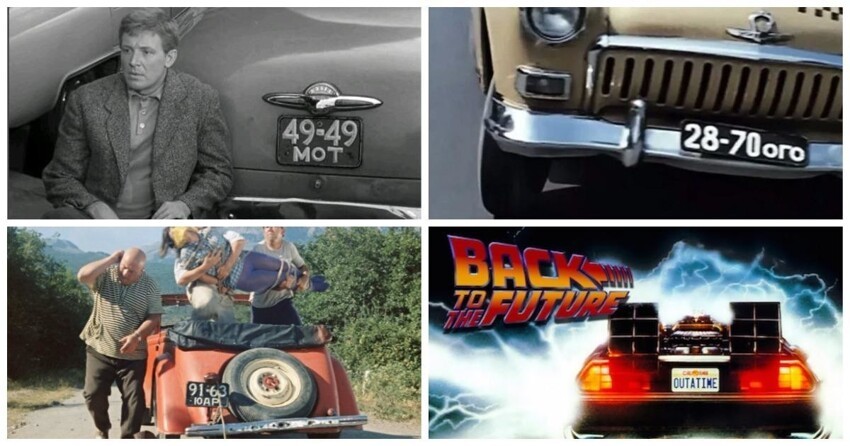
Правда официально первый автомобильный номер был выдан в Мюнхене 14 апреля 1899 года, но именно 1901 год, год регистрации всех автомобилей Нью-Йорка поголовно, считается годом рождения «имени» авто
Изначально автомобили ездили без особых опознавательных знаков- машин было мало и все и так знали владельца
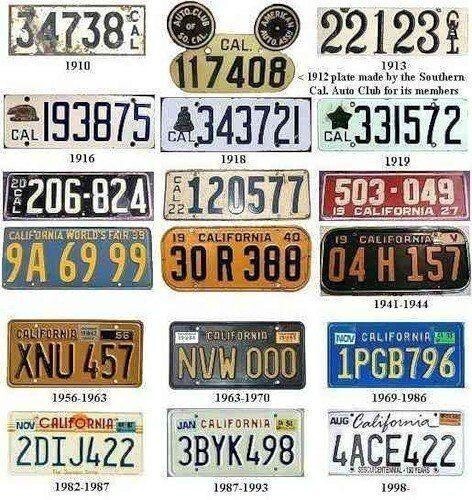
Источник:
Но все возрастающее их количество, а также создаваемые ими аварийные ситуации, вынудили дать каждому автомобилю имя — имя его владельца
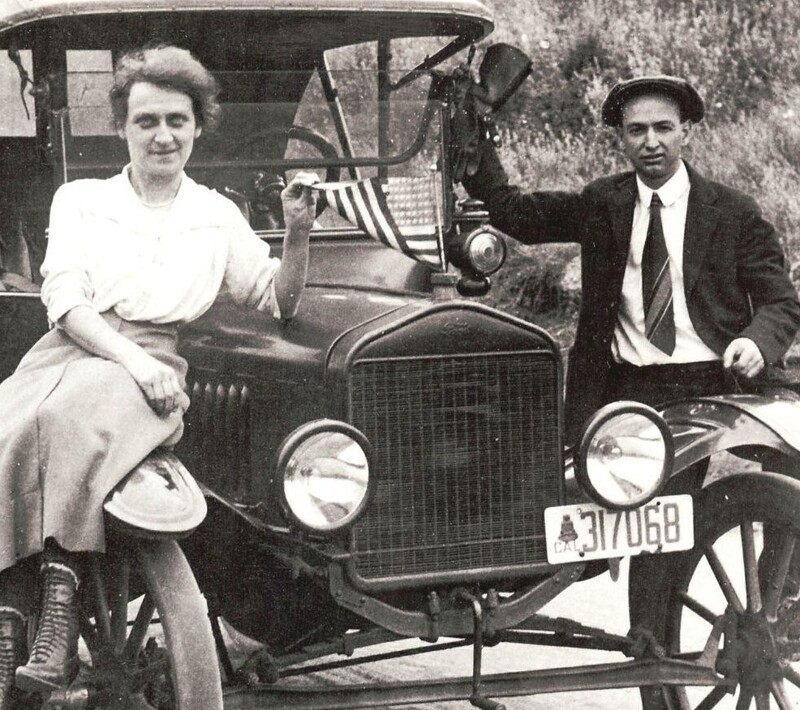
Источник:
В 1901 году в Нью-Йорке была введена обязательная регистрация автотранспорта, а владельцу выдавали табличку с его инициалами. Это было рождение автомобильного номера
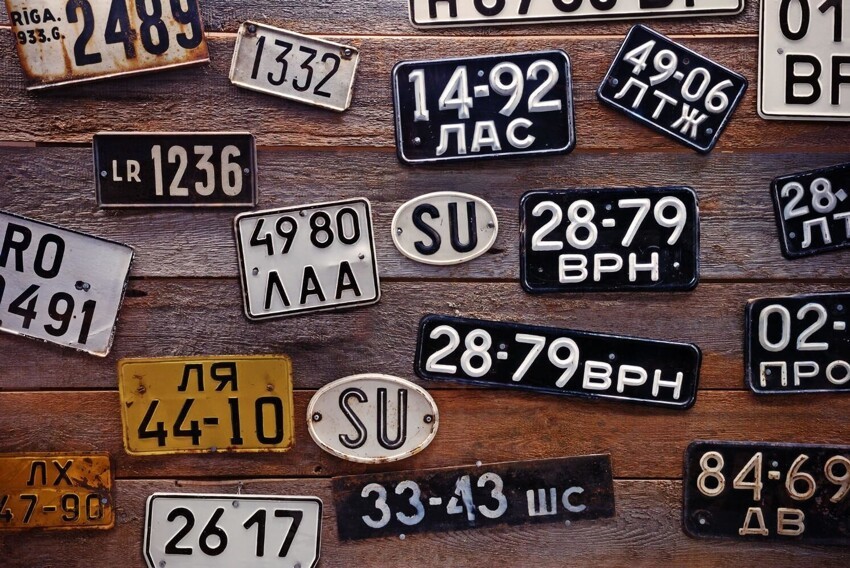
Источник:
Цифры в номерном знаке появились благодаря Рудольфу Херцогу (г. Берлин) — он пожелал вписать в номер инициалы своей невесты и добавил цифру 1 — первая и единственная любовь.
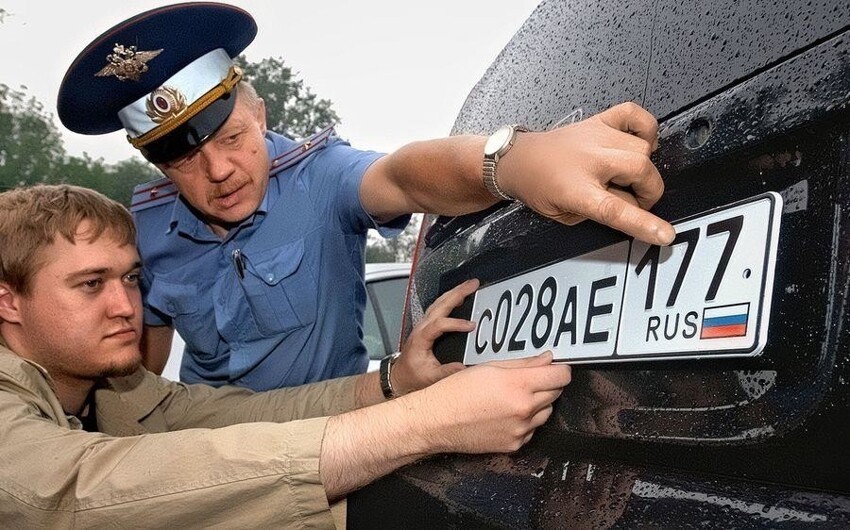
Источник:
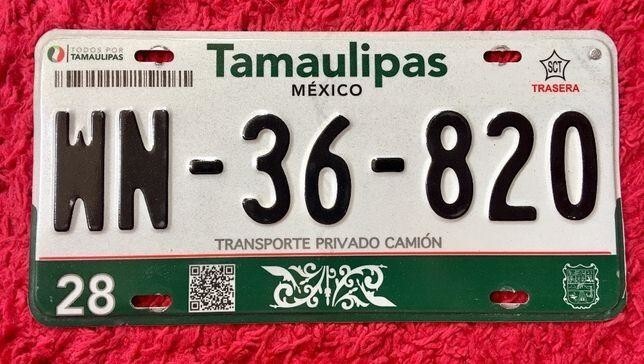
Источник:
Невесту звали Иоганна Анкор и номерной знак выглядел как IA 1
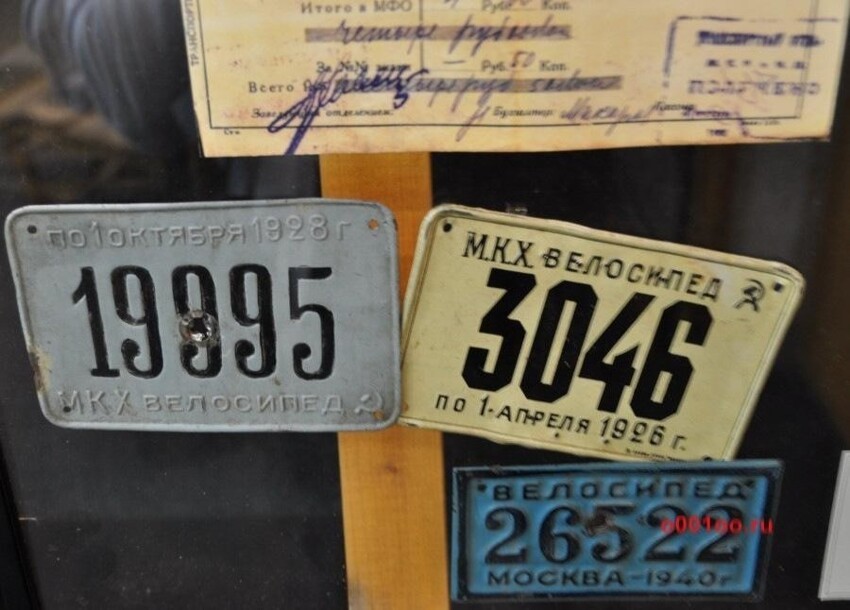
Источник:
А в США, в начале 20-го века, номера изготовлялись самими владельцами
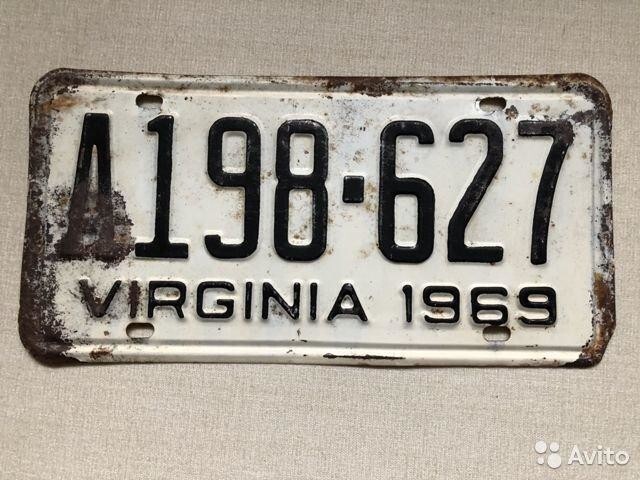
Источник:
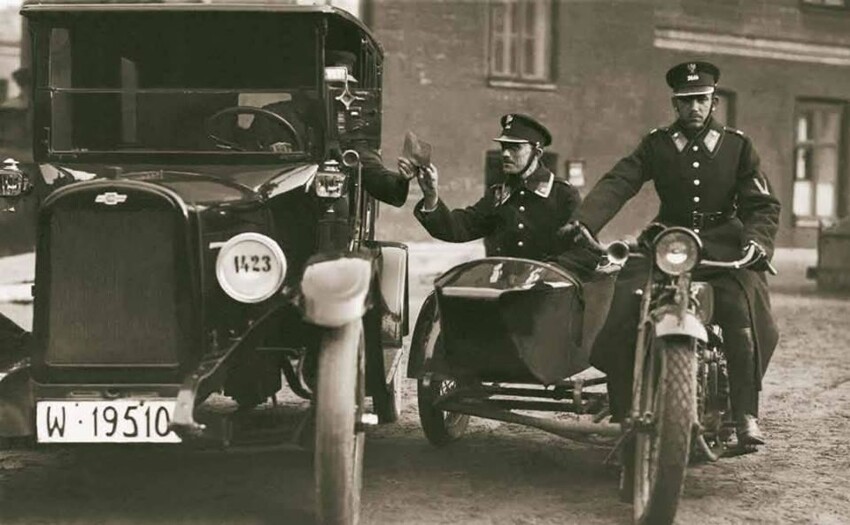
Источник:
В России первый автомобильный номер — был выдан в 1904 году в Риге, а стандартизация номеров в СССР пришлась на тридцатые годы 20-го века.
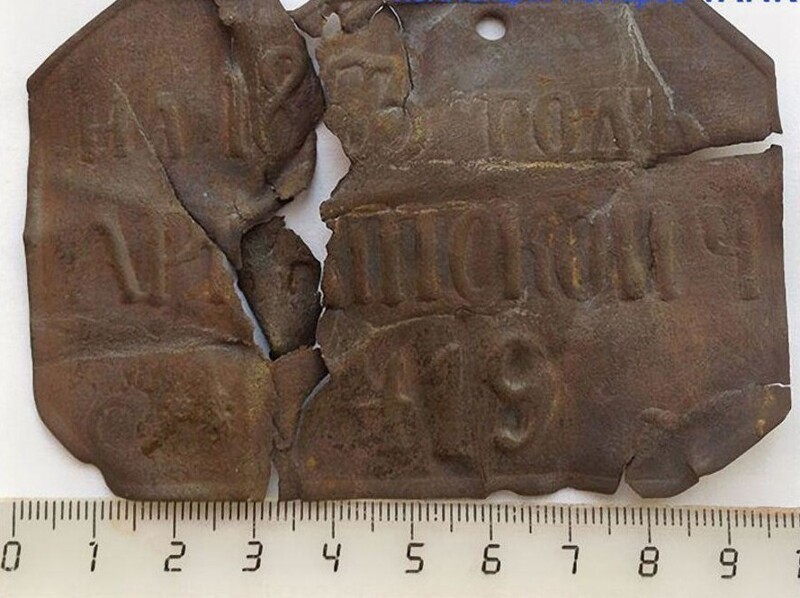
Источник:
Интересный факт: чтобы определить, не задолжал ли автомобилист городской казне, в Москве пошли на хитрость: каждый год выдавались номерные таблички нового цвета.
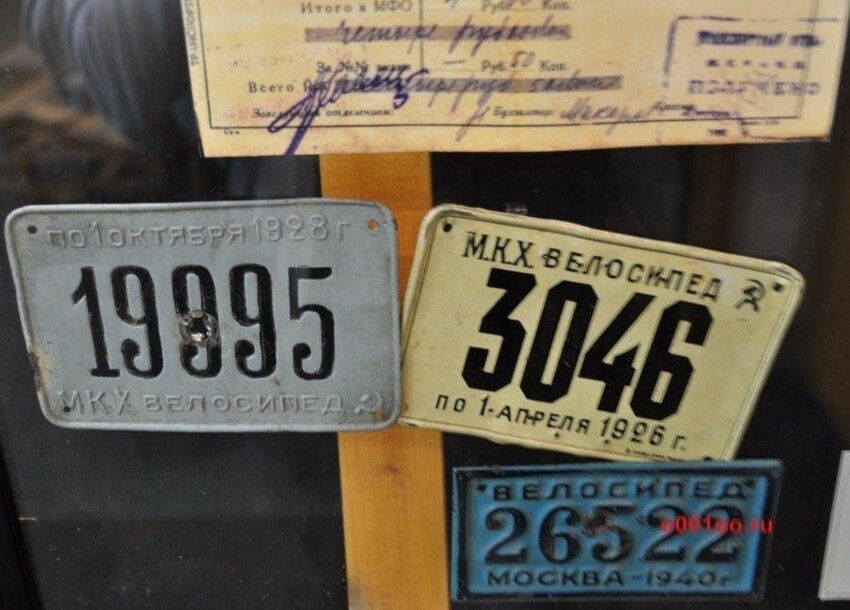
Источник:
Московский номер, 1930е годы — одна буква и две пары цифр
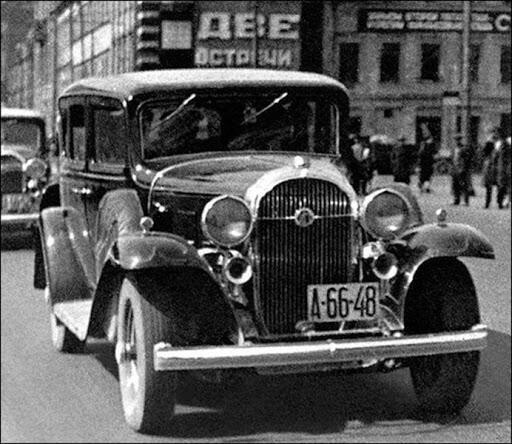
Источник:
В 1936 году, был введен новый стандарт номерных знаков: на черный фон наносились белые символы — две буквы, в первой из которых «зашифровывался» регион, и две пары цифр через черточку.
Регистрационный код автомобилей Красной армии состоял из одной буквы и пяти цифр, сгруппированных так: «А-9-99-99»
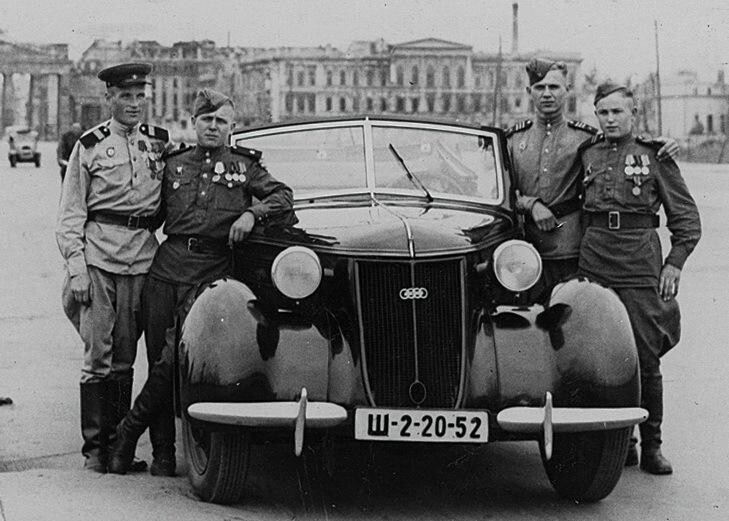
Источник:
Кстати говоря «блатные» номера появились чуть не сразу после их стандартизации
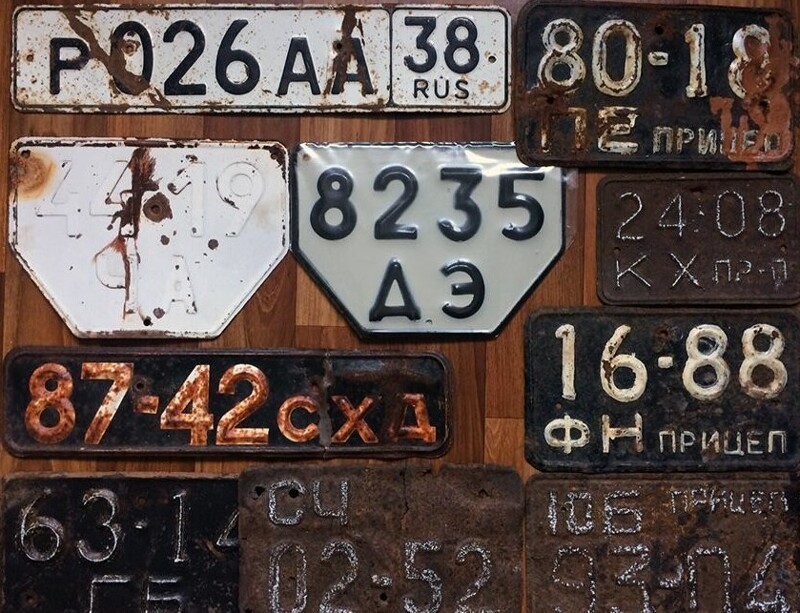
Источник:
Говорят что номера КГБ были узнаваемы сведущими людьми сразу — четыре цифры, поделенные дефисом и если сумма первой пары совпадала с суммой второй — это было авто КГБ
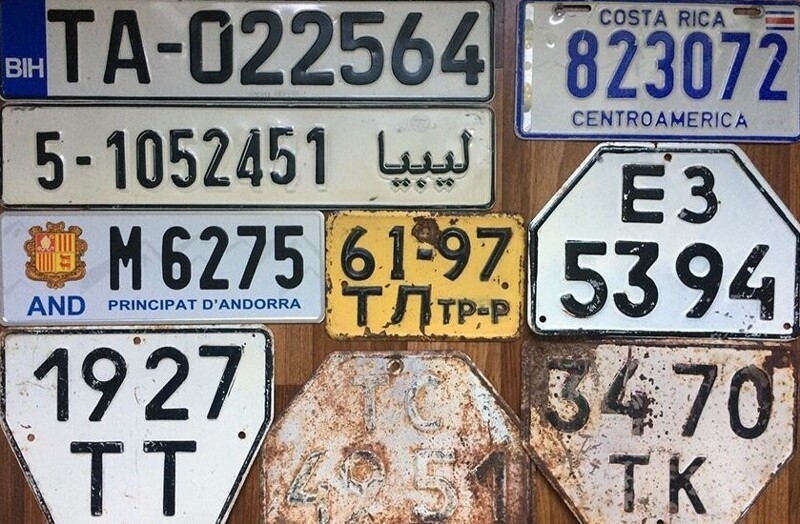
Источник:
В 80-х годах автомобили различных ведомств МВД обозначались номерами с буквами ОЛМ. Спец ведомства получили обозначение МАА и МАС
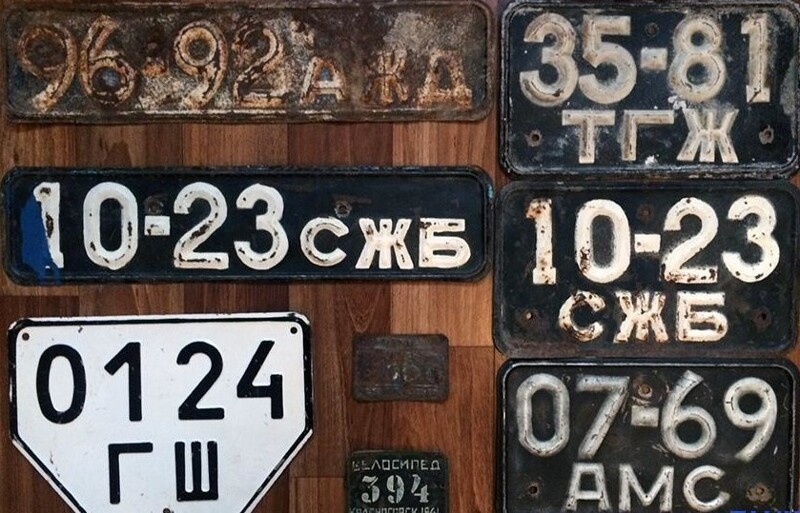
Источник:
Юрий Гагарин получил в подарок за свой первый полет Волгу ГАЗ-21 с номерами 12-04 ЮАГ — дата полета и его инициалы
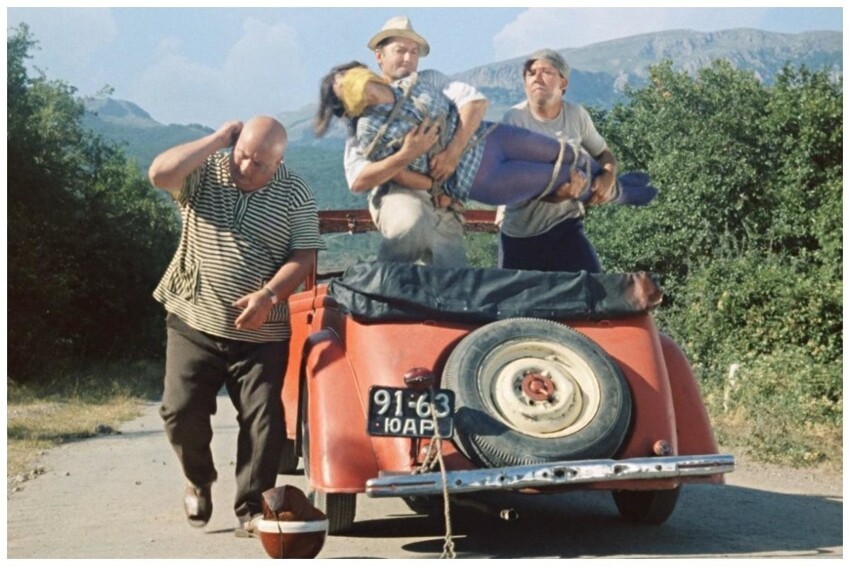
В фильме «Берегись автомобиля» были самые что ни на есть блатные номера, такие выдавались по великому блату
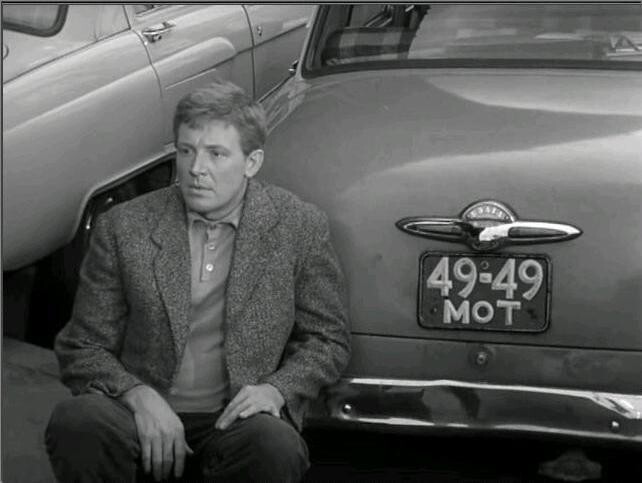
СССР пережил несколько изменений номеров
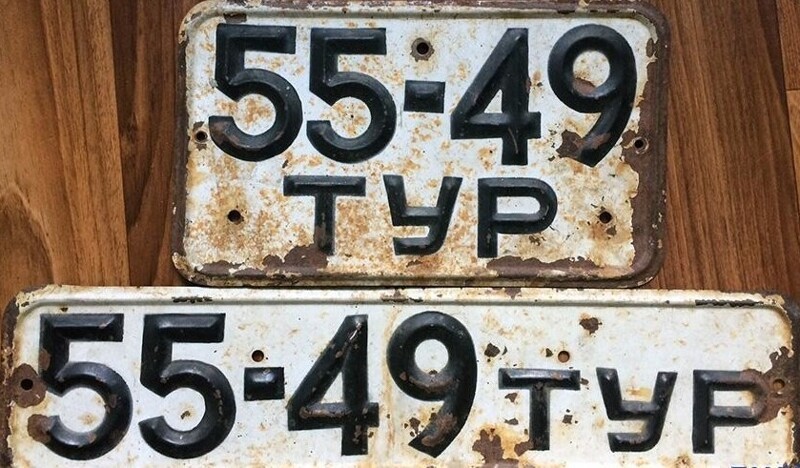
Источник:
Так, в 1946 году черные символы наносились на желтый фон В 1959 году — белые символы на черном фоне, причем букв стало три В 1980-м — черные цифры и буквы на белом фоне. 1994 год — на новых номерах буквенное обозначение региона заменили цифровым — каждому региону был присвоен двузначный (в исключительных случаях — трехзначный) код.
Еще крутые истории!
Основной проблемой первых номеров автомобилей СССР было то, что они никак не указывали на регион, в котором были выданы. Буквенные обозначения выдавались по алфавиту без какой-либо территориальной привязки.
Вопреки распространенному мнению, учет транспортных средств в России начал вестись задолго до революции. Но только в 1931 г. был принят общий стандарт госномеров для СССР. Посмотрим, какими были советские номера автомобилей.
Как выглядели номера на автомобилях СССР
Стандарт регистрационных номеров автомобилей в СССР менялся на протяжении всей истории государства.
В 1931 году
К разработке единого госномера привела индустриальная революция в Советском Союзе. Со времен Российской Империи и до 30-х годов 20 в. ситуация на дорогах изменилась не сильно, поэтому для обозначения транспортных средств использовались стандарты, принятые еще при императоре. В каждой губернии они были свои. Не стоит забывать, что в то время не было оборудованных шоссе, и путешествия на авто между городами были очень затруднительны — нужды не было ни в единой системе, ни в территориальных обозначениях.
Все изменилось в 1931 г. Первый номер СССР на авто выглядел так — жестяная прямоугольная табличка белого цвета с черными символами. Знаков было пять — одна кириллическая буква и две пары арабских цифр, разделенные дефисом. Стандарт размещения, принятый тогда, знаком всем и сегодня. Одинаковых табличек должно было быть две, и крепиться они должны были на передний и задний бампер автомобиля. На мотоцикле — на переднее и заднее крыло.

Автомобильные номера 1931 года
Изначально такой стандарт был принят только в Москве, но уже в 1932 г. его распространили на всю страну.
Контроль автономеров передали в ведомство Центрального управления шоссейных и грунтовых дорог и автомобильного транспорта — с этого года оно занималось их выдачей и учетом.
В том же году были выпущены «одноразовые» номера — от обычных они отличались надписью «Проба» и тем, что вместо двух на них была выбита только одна пара цифр. Использовались такие знаки для разовых поездок.
В 1934 году
Основной проблемой первых номеров автомобилей СССР было то, что они никак не указывали на регион, в котором были выданы. Буквенные обозначения выдавались по алфавиту без какой-либо территориальной привязки.
Проблема была решена очень просто — управление не стало разрабатывать системы региональных кодов. Теперь под самим номером на табличке добавилось название города, где был расположен филиал Дортранса, выдавший этот знак. В 1934 г. таких отделений было 45, позже их количество увеличилось.
Сам номер тоже претерпел изменения — буква в нем была изменена на цифру. По государственному стандарту цифр должно было быть пять, но это правило соблюдалось не везде.
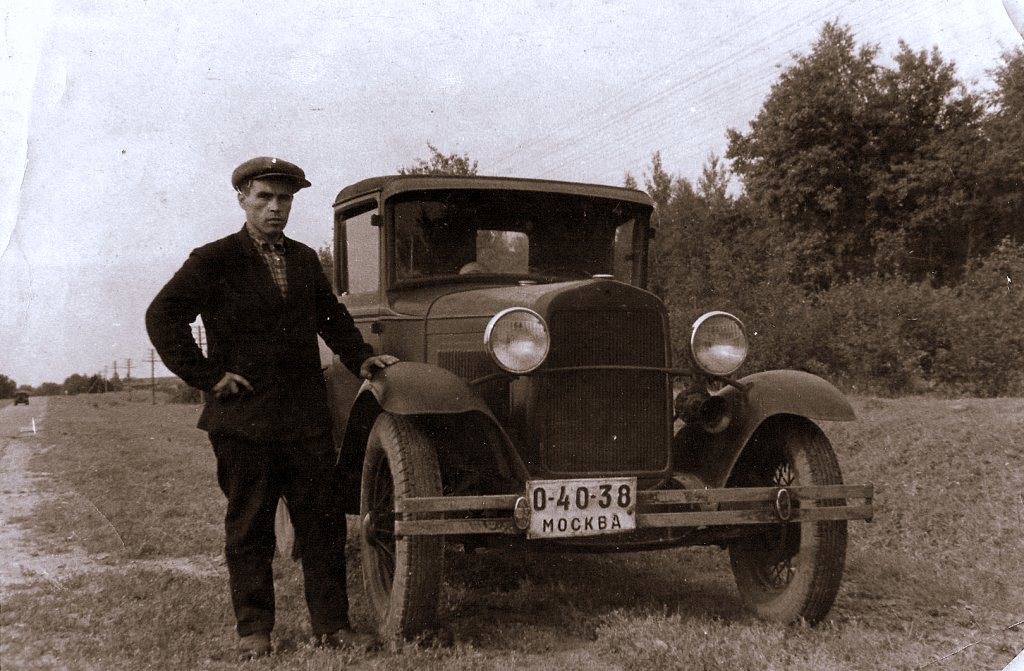
Автомобильный номер СССР (1934 год)
Практика пробных номеров тоже никуда не делась — их также подвели под новый стандарт. Появились варианты с обозначением «Транзит».
Интересно, что для электрического транспорта (трамваев или появившихся в тех же годах троллейбусов) система регистрационных знаков была совсем другой.
Стандарт 1936 года
В 1936 г. в транспортной сфере жизни государства случилось еще одно важное событие — в июле Союзом народных комиссаров СССР была учреждена Государственная автомобильная инспекция. С этих пор все действия с номерными знаками были переданы под ее юрисдикцию.
В этом же году ГАИ снова изменила образец номерных знаков на авто в СССР. Сама пластина стала намного больше, поле было черным, а символы — белыми. Кстати, стандарт изготовления этих номеров по сей день считается самым неудачным. В качестве материала использовалось кровельное железо, которое не выдерживало дорожных нагрузок, и пластины часто ломались.
В этом году впервые была разработана система территориальных обозначений — теперь каждый регион обзавелся своим буквенным кодом.
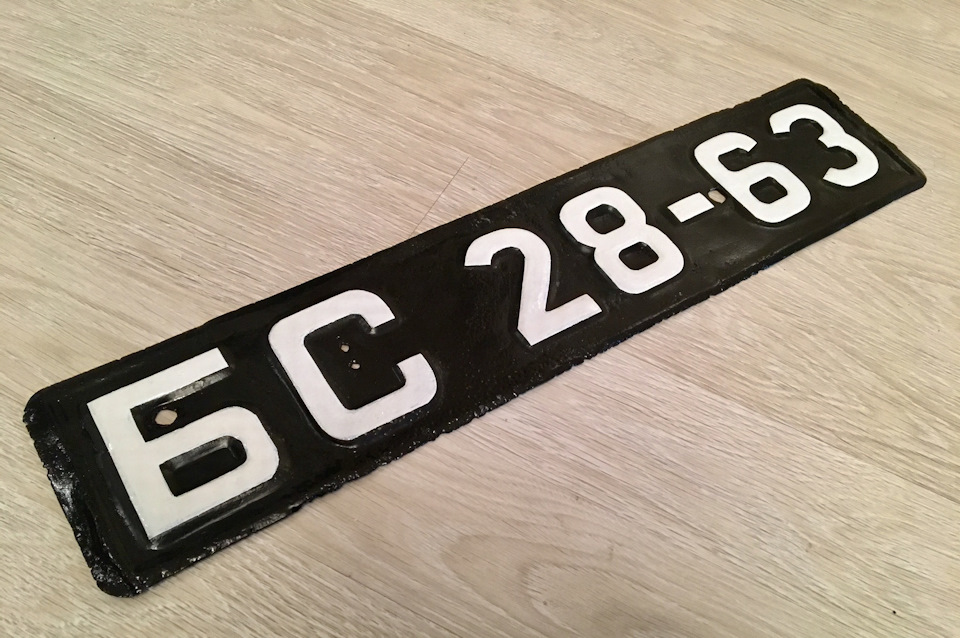
Автомобильный номер образца 1936 года
Сам номер был приведен к такому формату: две буквы (именно они и указывали на регион), пробел и две пары цифр через дефис. Эта схема уже соблюдалась гораздо строже, чем предыдущая, никаких отклонений от количества символов не допускалось. Пластина же выпускалась в двух вариантах. Однорядная (прямоугольная) крепилась на переднем бампере машины, двухрядная (по форме была близка к квадрату) — на задний.
Ближе к сороковому году ГАИ выпустило альтернативный вариант номерной пластины с уменьшенными размерами полотна, чтобы продлить срок его службы — сам образец при этом не менялся.
В этот период стоит отметить и специфику военных номеров — у них тоже был свой стандарт, но соблюдался он гораздо менее строго, чем гражданский. Число символов на номере автомобиля Красной Армии могло колебаться от четырех до шести, распределялись они произвольно, а иногда на пластине пририсовывали совсем посторонние знаки — например, звезды.
Автономера СССР 1946 года
После войны государству проще было провести реформу госномеров, чем приводить в порядок действующую систему учета. Огромное количество техники было мобилизовано, и далеко не вся она была перерегистрирована по правилам. Трофейные автомобили, которые в изобилии ездили по стране, тоже нуждались в регистрации. Свою долю хаоса внесли и оккупанты, перерегистрировавшие автомобили по собственным правилам.

Автомобильные номера 1946 года
Новый стандарт был объявлен в 1946 г. ГАИ сохранила довоенный формат записи в виде двух букв и четырех цифр (где буквы расшифровывались как код региона), изменился только внешний вид самого знака. Его полотно стало желтым, а буквы — черными. Деление на однорядные и двухрядные тоже осталось.
Важным изменением стало отдельное обозначение прицепов — раньше на них просто вешали номера грузовиков. Теперь на таких табличках появилась надпись «Прицеп».
ГОСТ 1959 года
В послевоенные годы уровень автомобилизации в Союзе Советских Социалистических Республик стремительно рос, и уже к концу 50-х номеров формата «две буквы-четыре цифры» стало не хватать.
Решено было добавить в номера машин СССР еще одну букву. Кроме того, в 1959 г. ГАИ отказалась от желтого полотна знака — внешний вид вернулся к довоенному формату. Сама пластина снова стала черной, а символы — белыми. Знаки с двумя буквами также остались в эксплуатации, но теперь их могли выдавать только военным автомобилям.

Автономера СССР 1959 года
Сочетания быстро заканчивались еще и потому, что один номер не закреплялся за машиной пожизненно — он менялся при каждой продаже. Тогда же было введено понятие транзитного номера, более привычное современному человеку — такие знаки изготавливались из бумаги и крепились на переднее и заднее стекла автомобиля.
Желтый фон для номеров чуть позже (в 1965 г.) был передан сельскохозяйственной технике.
Номера 1981 года
Следующая реформа состоялась после московской Олимпиады, в 1980 г.
Новый формат номеров уже гораздо больше напоминал современный. Как и в самом начале истории советских госномеров на авто, пластина стала белой, а символы — черными.
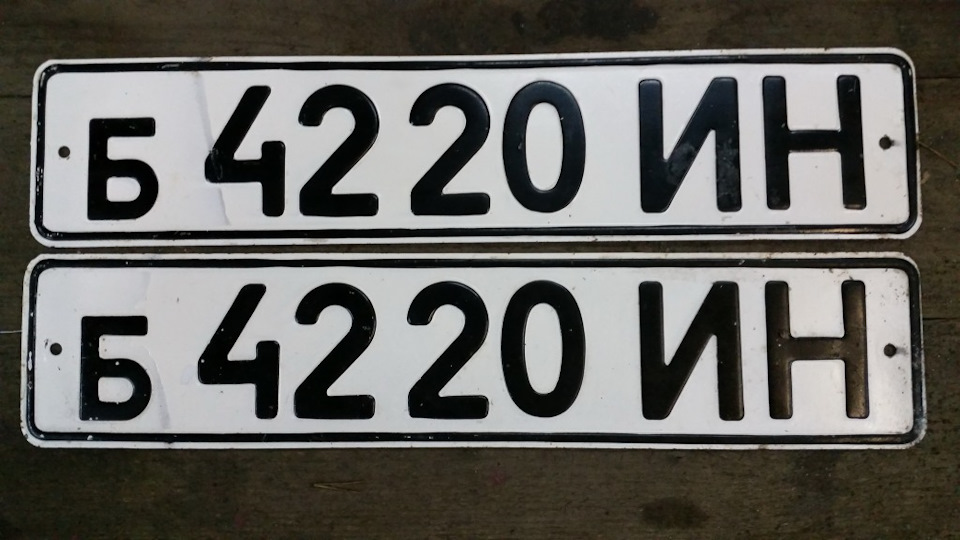
Автономера 1981 года
На самом деле в том году было принято сразу два стандарта — для частного и служебного автотранспорта. Но никаких существенных преобразований не последовало. Изменился только внешний вид советских номеров машин и порядок написания символов на них. Содержание осталось тем же — четыре цифры, три буквы (две, обозначающие регион, и одна дополнительная).
Размеры автономеров СССР
Размеры госномеров в Советском Союзе последовательно менялись с принятием каждого нового стандарта, это регламентировалось внутренним законодательством.
Однако во время реформы 1980 г. ГАИ пришлось принять во внимание международные стандарты госномеров европейских государств. Согласно им, размер переднего знака составил 465х112 мм, а заднего — 290х170 мм.
Расшифровка советских номеров авто
Старые номера машин СССР, выпущенные по первым стандартам, не имели никакой систематики — и цифры, и буквы выпускались по порядку.
Расшифровка советских номеров автомобилей стала возможна только в 1936 г. Цифры по-прежнему проставлялись по порядку, но буквенный код обозначал определенные регион.
В 1980 к каждой двухбуквенной комбинации стали добавлять одну переменную букву, обозначавшую серию, к которой принадлежал номер.
Индексы регионов
Первая буква индекса обычно была первой буквой названия региона.
Как сейчас для обозначения каждой области может использоваться два и больше кода, так и в СССР регион мог иметь несколько индексов. Как правило, дополнительный вводился, когда исчерпывались комбинации предыдущего.
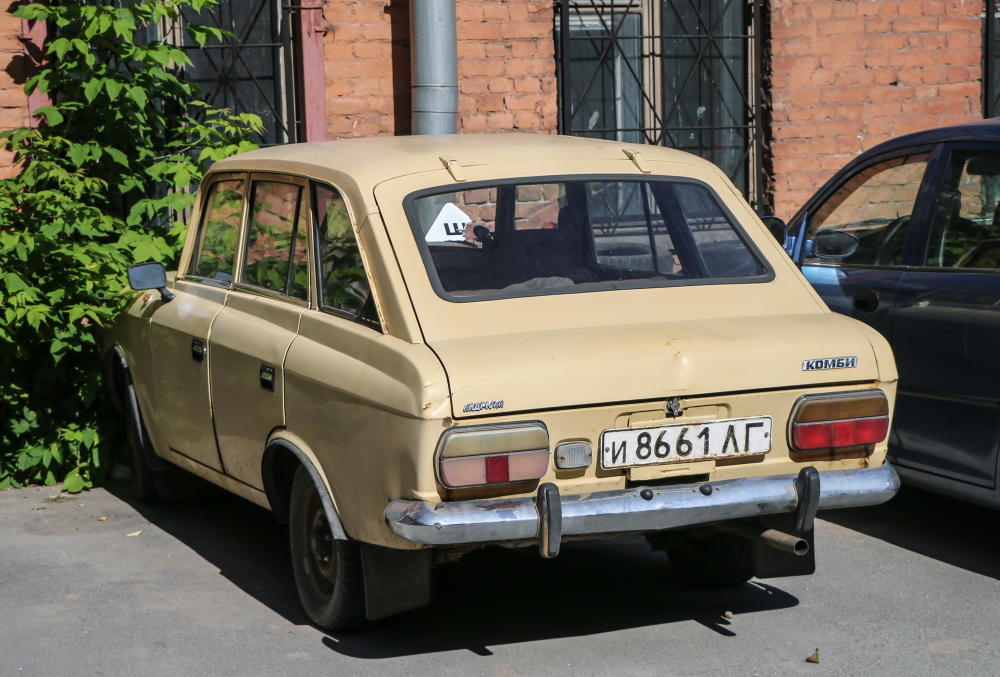
Автомобильные номера времен СССР г. Ленинграда и области
Так, например, случилось с Ленинградской областью — когда все варианты номеров с кодом «ЛО» уже были в использовании, пришлось вводить индекс «ЛГ».
Можно ли ездить на авто с советскими номерами
В этом случае закон однозначен и не терпит никаких двояких трактовок — советские номера могут иметь лишь те автомобили, что были единожды зарегистрированы в СССР, и с тех пор ни разу не меняли владельца. При любой перерегистрации транспортного средства его номера придется сдать и получить современные согласно новому государственному стандарту.
Разумеется, и здесь есть лазейки — например, советский автомобиль можно приобрести по генеральной доверенности, тогда перерегистрировать его не придется, но в любом случае первоначальный владелец должен быть жив.
Наложить штраф за использование советского госномера автоинспектор не вправе — такими машинами можно управлять вполне законно, оформлять на них страховки и совершать другие юридические операции, не требующие перерегистрации транспорта.
Заключение
Современный стандарт государственных номеров был принят в 1994 г. и используется до сих пор. В 2018 г. Он был дополнен выпуском номеров квадратной формы — например, для японских и американских автомобилей, не предназначенных для экспорта. На формат современных госномеров по большей части повлияли международные стандарты, например, требование к буквам, чтобы они могли читаться как кириллицей, так и латиницей.
У России и Советского Союза долгая история государственного учета транспорта. Как показало время, не все решения были правильными — например, изготовление пластин из отходов кровельного железа. С дорог постепенно уходят последние советские номера — уже совсем скоро их можно будет увидеть только в музеях и частных коллекциях.

